



















































































Campaign





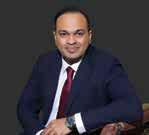


Motivate Media Group
Head Office: 34th Floor, Media One Tower, Dubai Media City, Dubai, UAE. Tel: +971 4 427 3000, Fax: +971 4 428 2266. Email: motivate@motivate.ae Dubai Media City: SD 2-94, 2nd Floor, Building 2, Dubai, UAE. Tel: +971 4 390 3550, Fax: +971 4 390 4845 Abu Dhabi: Motivate Advertising, Marketing & Publishing, PO Box 43072, Abu Dhabi, UAE. Tel: +971 2 677 2005, Fax: +97126573401, Email: motivate-adh@motivate.ae Saudi Arabia: Regus Offices No. 455 - 456, 4th Floor, Hamad Tower, King Fahad Road, Al Olaya, Riyadh, KSA. Tel: +966 11 834 3595 / +966 11 834 3596. Email: motivate@motivate.ae
London: Motivate Publishing Ltd, Acre House, 11/15 William Road, London NW1 3ER. Email: motivateuk@motivate.ae www.motivatemedia.com
EDITORIAL: Motivate Media Group Editor-in-Chief Obaid Humaid Al Tayer | Managing Partner and Group Editor Ian Fairservice Campaign Middle East Editor Anup Oommen | Senior Reporter Ishwari Khatu | Reporter Shantelle Nagarajan | Junior Reporter Hiba Faisal
DESIGN: Senior Designer Thokchom Remy
ADVERTISING ENQUIRIES: Chief Commercial Officer Anthony Milne | Publishing Director Nadeem Quraishi (nadeem@motivate.ae) | Sales Manager Tarun Gangwani (tarun.gangwani@motivate.ae)
PRODUCTION: General Manager S. Sunil Kumar | Production Manager Binu Purandaran | Assistant Production Manager Venita Pinto
HAYMARKET MEDIA GROUP: Chairman Kevin Costello | Managing Director Jane Macken
of fair review. CampaignMiddleEastincludes material reproduced from the UK Edition (and other editions) of Campaign which is the copyright of Haymarket. Campaignis a trademark of Haymarket and is used under licence. The views and opinions expressed within this magazine are not necessarily those of Haymarket Magazines Limited or those of its contributors.
Middle East has chalked up another first in 2025, launching the Campaign Middle East Marketing Game Changers Awards as an annual initiative. For the first time since its inception, Marketing Game Changers is neither an editorially nor commercially led recognition. Instead, it is a full-fledged annual award category – with clear eligibility and evaluation criteria, a panel of 34 respected judges, and formal submissions, which have been carefully reviewed over a two-week period.
Although award-winning announcements are usually unveiled first on-stage, online and across social media in a digital-first world, we have decided to take a slightly different approach with the Marketing Game Changers Awards.
This edition of the magazine – from the cover to a section within – has been dedicated to the grand reveal of the award winners. This is also a nod to the incredible success of Campaign Middle East’s print editions through 2025. Before you flip through the pages to read more about the winners – who will be honoured at the highly anticipated ceremony on 11 December 2025 at S/O Uptown Dubai – here’s a quick look at how they were chosen.
True to its name, in a game-changing move, Campaign Middle East offered a highly respected jury panel – comprising heads of agencies, media networks and advertising boards (more about them on Page 67) – the opportunity to evaluate the submissions made by some of the industry’s top client-side marketers.
The awards were free to enter. The winning entries proved their case in terms of performance and business impact, brand building, creativity, innovation, leadership calibre, talent development, purpose-led social impact and tangible contributions to the regional brand and marketing industry. The results are in.
The entry with the most points has been chosen as Campaign Middle East’s Marketer of the Year, while the rest rounding up the Top 10 have been named Marketing Game Changers Award winners for 2025. Each of these winners will be recognised at the upcoming Campaign Agency of the Year Middle East awards. Kudos to the winners!
This edition of the magazine also offers deep-dives into sports marketing – a tool brands are leaning into to build a sense of belonging; in-depth coverage from the Athar Festival –including roundups of round tables, masterclasses, workshops, young talent academies, and more; as well as several digital essays – where leaders call for the industry to redefine success metrics and build a world where artificial intelligence (AI) tools and human talent can coexist to build a better future. Happy reading!
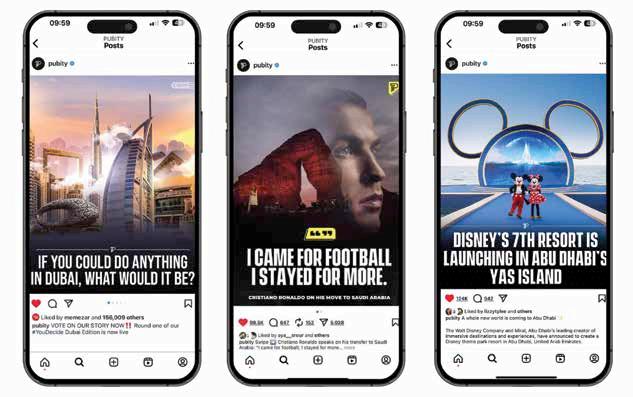
Pubity Group, one of the world’s most influential youth culture media platforms, has appointed The Vantage as its exclusive media representative across the Middle East and North Africa (MENA) region.
The partnership marks a significant step in Pubity’s global growth strategy, providing MENA advertisers with streamlined access to its portfolio of culture-driven social
SMC Group’s media and advertising arm SMC Media has revealed plans to acquire a stake in Aleph Group as part of its global expansion strategy.
The deal aims to drive digital transformation across the region through access to Aleph’s digital advertising assets across the Middle East, North Africa and Turkey (MENAT) region.
The agreement also outlines the framework for a minority acquisition by SMC Media in Aleph’s global operations, reinforcing both companies’ shared commitment to advancing digital transformation and innovation.
The transaction is subject to due diligence, definitive documents, board and shareholder approvals at both global and regional levels of both organisations, and customary regulatory processes.
avenues for
to tap into highly engaged social communities. brands and communities. With more than 160 million followers and billions of monthly views, Pubity Group sits at the heart of digital culture, connecting communities and shaping conversations through positivity, authenticity and influence.
Founded by Gen Z creators, Pubity Group has become “the youth platform creators follow”, driving trends, shaping sentiment and
redefining how brands engage with audiences online. The Pubity Group ecosystem includes some of the internet’s most influential social media pages, including Pubity, Memezar, Backpack, and Warm Up. They shape global conversations across entertainment, lifestyle, sports, tech and culture, creating content that resonates with millions every day.
This partnership opens a new chapter for Middle Eastern marketers, allowing brands to tap into Pubity’s highly engaged social communities.
From viral storytelling to purposedriven collaborations, Pubity’s platforms consistently drive authentic engagement and build lasting brand affinity, organically and at scale.
Through The Vantage, advertisers across MENA can now access Pubity Group’s full portfolio of brands and audiences, leveraging data-driven insights and regional cultural understanding to deliver campaigns that truly resonate and inspire.
Building on previous regional success, Pubity Group has already collaborated with leading MENA brands and tourism boards, including the Dubai Department of Economy and Tourism, Saudi Tourism Authority, MDLBEAST, Saudi Esports Federation and Miral.
As Pubity Group expands its content offering across video, podcasts and live events, the partnership allows MENA brands to engage audiences across multiple platforms.
By combining Pubity’s influence and storytelling power with The Vantage’s regional expertise, this partnership offers MENA brands a unique way to connect with Gen Z and millennial audiences through purpose-driven, high-impact social storytelling.



Middle East Communications Network (MCN) has revealed a major expansion of its data capabilities and platform services across the MENAT region through Acxiom, part of IPG. This expansion strengthens the value proposition for brands seeking advanced personalisation and measurable business results.
Building on its established presence, Acxiom, a global leader in customer data management and marketing technology, will now enhance and power MCN’s comprehensive data, performance
and technology offerings across the MENAT region. Acxiom’s globally adopted technology will now be more accessible to MENAT clients, driving enhanced audience segmentation, campaign performance and multichannel activation.
As part of this expansion, Acxiom will serve as the data foundation for Interact, the global end-to-end connected platform launched in the region earlier this year. Interact unifies data, creative production, media, and commerce – enabling


Integrated creative communications and PR agency The Romans, has teamed up with Dubai’s newest contemporary ceramics studio Maison Terraē and Dr. Mariana Berratto to launch ‘Clay Jugs’ – a pro-bono campaign designed to help women overcome one of the largest psychological barriers to breast cancer detection – the fear of finding. To confront this fear head-on, The Romans created ‘Clay Jugs’, a hands-on campaign that uses ceramics as a metaphor for self-examination. The team brought together seven inspiring women, including survivor Sara Raffaghello, for an intimate ceramics experience that transformed fear into control.
Viola Communications, a subsidiary of Multiply Group and an Abu Dhabi-based integrated marketing agency with more than two decades of presence in the UAE, has announced a strategic partnership with NIM Digital, a UAE-born technology and digital transformation partner.
The collaboration unites Viola’s creative, communications and digital marketing expertise with NIM Digital’s UX/UI design, AI-driven development, immersive experiences and data analytics capabilities.
real-time, AI-powered collaboration and personalised communications at scale. The platform is designed to transform how brands engage audiences across all touchpoints.
This expansion reinforces MCN’s and Acxiom’s strategic partnerships with technology providers, including Google, Salesforce, The Trade Desk and Snowflake. Their diverse expertise supports end-to-end delivery across technology strategy and advisory, digital transformation, martech, platform integration, AI and ML, and advanced analytics.
“Our partnership with NIM Digital enables us to deliver cutting-edge digital solutions that blend creativity with technology,” said Piero Poli, CEO of Viola Communications. “As two innovators rooted in the Emirates, we share a deep understanding of the nation’s ambitions and evolving needs of local organisations.”
Rani Saddi, Co-Founder and CEO of NIM Digital, added, “We’re helping brands unlock new levels of engagement, performance and insight through data-driven, humancentered digital experiences.”
The strategic partnership aims to underscore Viola Communications’ role in advancing the UAE’s digital ecosystem by giving clients access to next-generation solutions in digital marketing.


To mark RTA’s 20th anniversary under the inspiring tagline ‘20 Years Moving Dubai Forward’, this campaign positions RTA as a driving force in shaping the city’s future of mobility, celebrating progress, connectivity and community. The hero film features four of the UAE’s most recognised creators, including Kris Fade, Abdullah Raesi, Max of Arabia and Nyla Usha. Together, they creatively capture RTA’s evolution and its role in moving Dubai forward over the past 20 years, showcasing how the RTA can get you anywhere in the UAE. The hero film extends into a fully integrated digital campaign featuring supporting videos, creative reels and engaging storytelling content across RTA’s platforms.

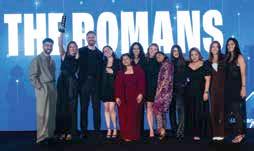
The PRCA MENA Awards 2025 returned in full force, honouring outstanding talent, creativity, and effectiveness in public relations and communications across the Middle East and North Africa (MENA) region.



alongside 46 Highly Commended recognitions –reflecting the scale and calibre of work being produced across the industry.
in-house teams, and independent practitioners, reaffirming PRCA MENA’s role as the leading professional body for communications across the region.
Egbert said, “The work being recognised this year is sharper, more insightful and more globally competitive than ever before.”
The Awards night witnessed a genuiune celebration of outstanding campaigns, teams and individuals withing the region’s PR industry.
“The energy and camaraderie of agencies, in-house teams, and independent professionals, all coming together as one to celebrate each other was a sight to behold,” Egbert added.
Winning highlights from the PRCA MENA Awards 2025 were:
Independent Consultancy of the Year (Very Large) – Gambit Communications
Independent Consultancy of the Year (Large) – Brazen MENA
Independent Consultancy of the Year (Medium) – The Romans
In-House Team of the Year – Shorooq
Large Consultancy of the Year – Current Global MENAT
Medium Consultancy of the Year – The Romans Very Large Consultancy of the Year – Gambit Communications
Held at Mare by Bussola, The Westin Dubai Mina Seyahi, on 11 November, the sold-out exclusive gala welcomed more than 350 industry leaders and professionals across agencies and brands for an evening of celebrating excellence that is redefining communications in the region.
This year’s awards witnessed 67 winners, recognised across a diverse range of categories,
“What we saw last night is the clearest sign yet of how far the regional PR and communication industry has evolved,” said Conrad Egbert, Head of PRCA MENA.
From groundbreaking digital campaigns to bold sustainability storytelling, the evening celebrated the innovation and strategic thinking driving regional integrated communications forward. The awards brought together senior leaders from top agencies,


At GITEX Global 2025, e& unveiled a conceptual campaign that challenged convention and sparked critical conversations about people’s relationships with technology. Addictech, a collection of conceptual health devices, served as both a showcase and a mirror –highlighting the very real problem of screen addiction while asking a profound question: What if technology could evolve beyond screens altogether? Three cinematic short films brought the concept to life online. At GITEX, visitors were encouraged to touch, explore and question. Addictech wasn’t built to sell. It was built to provoke.

Intern of the Year – Krishna Babu – Ruder Finn Atteline
Mental Health Champion of the Year – Sinead O’Connor – Current Global MENAT
Rising Star of the Year – Alexandra Richards –Gambit Communications
SuPRMan of the Year – Rashad Al Ghadban –Miral Destinations
SuPRWoman of the Year – Sophie Simpson –Ruder Finn Atteline

This UAE-based homegrown super-app for at-home services revealed the strategic rollout of its comprehensive brand refresh. It transformed Justlife from a functional service app into a lifestyle brand that promises reliability, care and ease, as well as ‘that extra bit of help at home’ that lightens the load for people feeling overwhelmed and exhausted. The campaign was rolled out across digital assets, out-of-home (OOH) screens, in-app, website, print media, social media, internal communications materials, branded vans, in-home flyers and CRM channels. The goal was to create strong awareness and consistency – with the same tone, look and message across every channel.

Are global and regional agencies working with brands in Saudi as effectively as local Saudi agencies?


Camille Haddad CEO, VML KSA
In Saudi Arabia’s dynamic and rapidly evolving market, achieving true impact demands more than just global reach – it requires profound local resonance. The true differentiator, however, lies in integrating and empowering dedicated local Saudi talent. These invaluable team members are the key drivers, providing essential cultural immersion, authentic language nuance, and granular market understanding that ensures campaigns genuinely connect. The powerful synergy guarantees that the work is not just globally excellent, but deeply resonant, culturally sensitive and truly impactful for the Saudi audience.
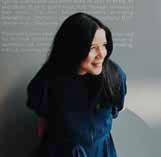
We've seen both local as well as global and regional agencies build effective and resonant work in Saudi. Global and regional teams can be effective in building work that's culturally authentic, when they recognise that the market has its own rhythm and nuances. One of the most effective setups we’ve seen is a hybrid model: when a strong local team rooted in the culture is paired with global craft, structure, and production standards. As a global film house, we have a KSA-experienced team leading the way culturally, while tapping into our global leadership’s guidance, global directors and talent network. It’s not about one being better than the other; it’s about collaboration and respecting what each side brings. In Saudi, we think the work resonates when it’s built insightfully, authentically and locally, to global best practices.

Abdulrahman Suwailam
Head of Marketing, MENA –ESL FACEIT Group
While global agencies have deep expertise, they often apply a regional formula that misses what makes Saudi unique. Success here isn’t about just having a local office. It demands a team that doesn’t just understand the culture but lives it. Insights, creative briefs, and major decisions must originate from within the Kingdom. True effectiveness comes from local talent having the autonomy to lead and make key calls, something local agencies inherently do better.

Mohammed Sehly CEO, BigTime Creative Shop
NOReal Saudi creativity won’t come from strategists sitting behind laptops abroad, researching how Saudis think or mapping Gen Z behaviour from afar. It happens when a collective of diverse, culturally fluent minds live and breathe the rhythm of this place, not when there’s just one Saudi voice on the call to fact check expressions. Until we invest in growing a full Saudi creative generation of thinkers, writers, directors and doers who create from within the culture, not about it, the work will keep sounding like observation, not truth. Real resonance starts from proximity, not PowerPoint.

George Skaff
Senior Commercial Director – GCC, Aleph Holding
For Saudi clients that are primarily advertising within the Kingdom or the broader MENA region, the answer is yes. Local agencies possess the necessary deep market knowledge, cultural nuances, local capacity, and regional insight to be just as effective, if not more so, than the global regional agencies operating in Saudi. However, the challenge for local agencies arises when considering the export book of business – that is, Saudi brands looking to expand or advertise internationally. In this context, it becomes challenging for local agencies to be as effective as global agencies. This difference stems primarily from the local agencies’ limited or non-existent presence, lack of local knowledge/ capacity, and lower penetration in international markets outside the region, which global networks inherently possess.
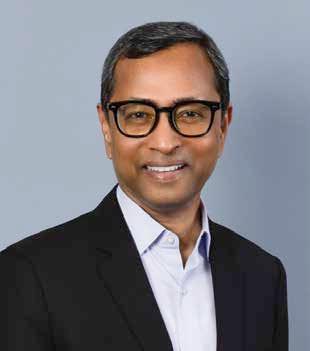
Sunil
John Senior Advisor MENA, Stagwell
Saudi Arabia doesn’t need imported creativity; it needs rooted creativity. Whoever tells its stories must live its rhythm, its language, its contradictions. Global agencies have proven the world over that great work happens when local talent leads and global systems enable. And that matters because creativity is culture made visible. When Saudi is building cities, art, and experiences that awe the world, its communication should carry the same native confidence and originality. Yet in Saudi, both global and local agencies are still trapped in an expat echo chamber. The next creative wave must be for Saudi, by Saudi, not just branded that way, but built that way.
Makram Fata Managing Director, World Edge
Both can be effective, but true success depends on localisation. Global agencies bring structure, strategy, and scale; local agencies contribute cultural fluency, agility and sharp social instincts. The strongest results emerge when international expertise fuses with local insight, when global frameworks are powered by Saudi talent that understand the pulse of its audience. The future of brand success in Saudi isn’t about global versus local, but global with local: collaborative, hybrid teams that blend creativity, data, technology and cultural authenticity.


Charli Wright Owner & Managing Director, JWI
For me, it’s not about geography, it’s about depth. The effectiveness of an agency, whether global, regional or local, comes down to the quality of its strategic thinking and its ability to uncover genuine consumer insight.
True cultural understanding doesn’t sit in a postcode – it sits in perspective. When a team brings together diverse viewpoints, such as regional context, global best practice and local nuance, that’s when strategy becomes powerful. The agencies doing the best work in Saudi aren’t necessarily the ones with the closest office, they’re the ones with the deepest understanding of its people.
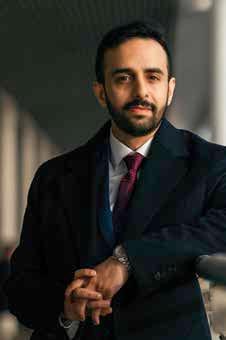
Rami Hmadeh CEO, Serviceplan Arabia
Global and regional agencies can be just as effective, but only when they are truly embedded in the Saudi market. What makes the difference is not the logo on the door, but the people behind it
At Serviceplan Arabia, our strength comes from being locally rooted while backed by the global power of the House of Communication. We work hand in hand with Saudi talent, partners, and clients to create ideas that reflect the country’s culture and ambition. That balance between local insight and global capability is what drives real impact in today’s Saudi market.
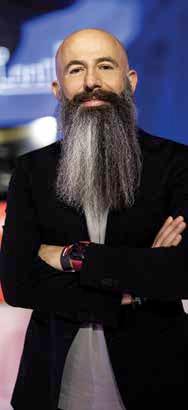
Abdulaziz Al Qahtani
Business Development Director, Sifr
If they have a Saudi presence. Global and regional agencies with strong Saudi offices and Saudi talent are contributing effectively, leveraging their scale, global experience, and exposure to large, complex projects that align with the ambitions of Vision 2030 and the giga-projects’ expectations. At the same time, the eagerness of local agencies is rapidly maturing the Saudi market through collaboration and the adoption of global practices, a trajectory that will soon elevate local agencies to even greater competitiveness. However, agencies without on-ground presence in Saudi would struggle. This market requires deep cultural fluency, historical understanding, and sensitivity to Saudi identity, where heritage and pride strongly shape communication.
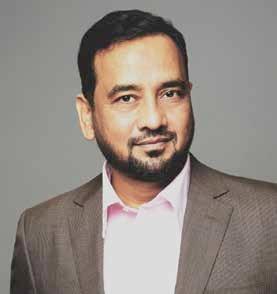
Kazmi Co-Founder, Total Media Ventures & Growthnity
While global and regional agencies bring strong strategic frameworks and best practices, local Saudi agencies often outperform them in execution and cultural resonance. The future of marketing in Saudi won’t belong to the biggest networks – it will belong to the most contextually intelligent ones. And today, that intelligence is unmistakably local.
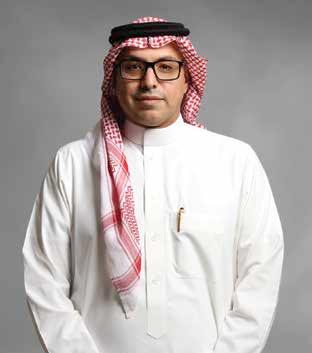
Ibrahim Almutawa Managing Partner, Jummar PR
The growing demand for local agencies is a global trend. In the Saudi market, in particular, international agencies are still struggling to understand the local community, opting instead to develop unworkable strategies rather than innovating effective implementation.
Since the 1970s, international PR agencies have been in the Saudi market. Yet, they have not invested in national talent, and their localisation rates remain low. They made no genuine efforts to engage with the community or embrace its ideas; instead, they applied Western-oriented concepts to our market, which differs culturally, linguistically, and, most importantly, socially.
Murtaza Mahfooz, Regional MD – Gulf and Near East, Haleon, shines a light on marketing health and wellness with purpose.
HEALTH IS A BROAD TERM – HOW DOES HALEON VIEW THE CONCEPT OF HEALTH?
Murtaza Mahfooz: Health is universal, but understanding and access often fall short. That’s where Haleon steps in. Our purpose is clear: To deliver better everyday health with humanity. For us, that means balancing science with a human touch in everything we do. We don’t want health to feel clinical; we want it to feel personal, approachable and empowering. That philosophy shapes how we innovate and how we market – because health should be something people connect with, not something they fear.
WHAT DOES ‘BETTER EVERYDAY HEALTH WITH HUMANITY’ MEAN IN PRACTICE?
Mahfooz: It’s about making science relatable. We take specific health concepts and bring them to life through everyday experiences – for example, for sensitivity, we created the Chill Test, which shows what happens when you bite into an ice cream and feel that sharp twinge. For gum health, we introduced the Plaque Test, because spitting blood when you brush is a sign you shouldn’t ignore. For respiratory health, we encourage people to ‘Flu Responsibly’. For pain, we link solutions to different life stages. These activations make science simple, actionable and emotionally relevant – because when people see themselves in the story, they engage. That’s the essence of marketing with purpose.
on proactive health. When people see Centrum, they see trust, science and simplicity – and that’s exactly what this category needs.
WHAT INSPIRED THE CREATION OF VITAMIN SEE BY CENTRUM?
HOW DOES VITAMIN SEE MAKE THE BENEFITS OF VITAMINS VISIBLE AND ENGAGING?
Mahfooz: This category lacks a clear call to action – a reason to take charge and imagine what life could be if you did. So we created Vitamin See, the world’s first experience that makes the invisible benefits of vitamins visible. A spectrophotometry scan gives you a personalised wellness profile across more than 60 checkpoints –vitamins, minerals, heavy metals, gut health, skin, hair, nails, oxidative stress, joints, mental health and more. And where better to launch this than Dubai – the headquarters for innovation and cutting-edge technology in the region? We built a custom dome at Kite Beach during the Dubai Fitness Challenge – the epicentre of wellness. In 30 seconds, you get a personalised report and visuals unique to you, then enter a multisensory journey where light, sound, and art bring nutrition to life in an emotionally connective way. It’s immersive, shareable, and culturally relevant –exactly what modern health engagement should be.

HOW WAS INCLUSIVITY BUILT INTO THIS EXPERIENCE?
HOW DOES SELF-CARE FIT INTO HALEON’S VISION FOR HEALTH?
Mahfooz: Self-care is exactly what it sounds like – the power is in your hands. And for us, it’s all about education, education and education. When we deliver better information, people make better choices. It’s not just about empowerment; it’s also about reducing the burden on primary healthcare systems in certain markets. Self-care is proactive, and that’s the future of health. If we can help people take charge early, we’re not just improving lives – we’re reshaping healthcare.
WHY IS WELLNESS OFTEN OVERLOOKED, AND WHAT CHALLENGE DOES THAT CREATE?
Mahfooz: Wellness is a category close to my heart because it’s unique. It’s not about fixing a problem; it’s about protecting yourself. It’s proactive, not reactive – as we saw during the COVID period when people turned to supplements. Think of it this way: If you have a headache, you take a pill – that’s treatment. Wellness is about preventing that headache in the first place – that’s protection. The challenge? There’s no clear call to action. People know wellness matters, but they don’t always know what to do next. That’s what we’re changing – by creating experiences that inspire action and make wellness feel urgent and exciting.
WHY IS CENTRUM THE RIGHT BRAND TO LEAD THIS MOVEMENT?
Mahfooz: Centrum is the World’s No. 1 Multivitamin Brand. It is trusted globally, and it is the most clinically studied multivitamin brand. As the leader in this category, we have a responsibility to educate and inspire. That credibility gives us the authority to lead the conversation
Mahfooz: Health innovation means leaving no one behind. We created Vitamin See for those who can’t see. Visitors from Sharjah City for Humanitarian Services joined us, and we curated an ASMR playlist so people of determination could experience what’s happening inside their bodies. Inclusivity isn’t optional; it’s a value – and it’s how we build trust and emotional equity.
WHAT DOES THIS ACTIVATION MEAN FOR THE FUTURE OF HEALTH ENGAGEMENT?
Mahfooz: The response has been overwhelmingly positive, and we plan to expand to other markets. The future is about going where people are, not waiting for them to come to us – delivering science with the right human touch. This is how we build trust, advocacy and a movement for better everyday health.
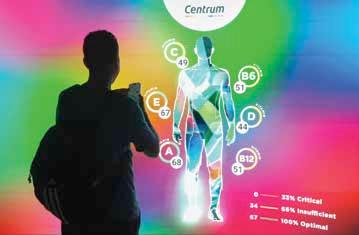
The marketing industry in the Middle East is amid one of its most dynamic transformations yet. Over the past few years, the region has become a hotbed of innovation, driven by rapid technological adoption, a connected population across age segments, and brands eager to establish meaningful presence in both global and local contexts. Yet, as opportunity expands, so does complexity. The challenge for marketers today is no longer simply about visibility, it’s about standing out authentically in an algorithm- and artificial intelligence- (AI)-driven world while staying true to cultural context and human connection. We live in a time when attention has become the most valuable currency, and everyone, from brands to influencers and AI bots – is competing for it. The sheer volume of digital content has created an environment where differentiation is increasingly difficult. Consumers are scrolling faster, questioning more and filtering what truly matters to them. This means brands must move beyond just producing more content. They need to create meaningful moments that resonate, inspire and build trust.
In modern-day marketing, trust and credibility have become the ultimate assets for any brand. In a world flooded with sponsored posts, conflicting data and rising misinformation, audiences are more sceptical than ever. They value transparency, consistency, purpose and integrity. Brands that endure are those that communicate honestly, show empathy, align external imagery with internal self-reflection and treat trust not as a campaign tagline but as a pillar for long-term relationships. In healthcare, the brand promise is magnified a hundredfold because what’s at stake is not just perception, but also human lives.
Purpose-driven marketing is another defining shift. Today’s audiences, especially Gen Z and millennials, gravitate toward brands that stand for something more than profit –whether it’s sustainability, inclusion or social progress. Authenticity and purpose are no longer optional; they’re strategically crucial. Yet, as marketers chase return on investment (ROI) and performance metrics, which are of course critical, there’s also a need to re-focus on design, creativity and storytelling. After all, there is little point of measuring if the consumer has already skipped your content.
Listening has also been an underestimated skill in marketing. Customers are always talking through data, feedback, reviews and social behaviour. But the question is, are we really listening enough? Marketing requires as much empathy as strategy, as much observation as execution.
Marketers often view challenges and opportunities in silos – campaign performance, digital channels or media mix, but we must operate in an era of ecosystems, connected journeys and lifetime value thinking. For healthcare brands, this means creating continuity, from awareness to care and wellness – not just selling a service, but nurturing relationships.
For marketers in the region, understanding cultural nuance is key to building trust. The Middle East isn’t a single, uniform market. It’s a culmination of languages, values and
perspectives. Real success comes from genuine connection, not mere translation. Campaigns that authentically reflect local sentiment, celebrate regional identity and speak to shared aspirations tend to outperform those that merely replicate global templates.
AI now dominates marketing conversations, redefining how we ideate, personalise and measure impact. AI-driven personalisation and automation allow for hyper-targeted, real-time engagement –empowering marketers to reach the right person, at the right time, with the right message. Yet, the true opportunity lies in how we use AI effectively and responsibly.
As AI becomes more integrated into browsers and searches, discoverability is evolving. Consumers are no longer just searching, they’re also asking AI tools to summarise, compare and recommend. This makes it even more critical for brands to appear on credible, high-authority platforms, because AI models prioritise verified sources in their results. In other words, visibility now depends as much on where a brand is featured as what it says. Ultimately, AI should be an ally, not a replacement for human intuition. The best outcomes come from balance, where technology amplifies insight, but empathy drives strategy. Data remains the backbone of this transformation. Real-time analytics enable smarter, faster and more

measurable decisions. But as digital ecosystems expand, compliance and ethics have become non-negotiable. With misinformation spreading faster than ever, maintaining accuracy, transparency and regulatory alignment is essential, especially in sectors such as healthcare, finance and education, where credibility defines longevity.
For brands to thrive in the region’s fast-evolving landscape, they need to blend creativity with conscience, and innovation with authenticity, writes Aster DM Healthcare’s Rahul Kadavakolu.
Social commerce is also reshaping consumer journeys, as people increasingly shop directly from social platforms, often guided by creators they trust. Influencer ecosystems are maturing, with micro and niche voices driving deeper authenticity. Meanwhile, connected TV and streaming platforms are emerging as strong storytelling avenues, while short-form, Arabicfirst content continues to dominate attention spans, highlighting the importance of linguistic and cultural resonance.
If there’s one sector that embodies this evolution clearly, it’s healthcare. Consumers today expect personalised, real-time engagement from their health and wellness brands – whether it is through smart wearables or mobile apps and digital care platforms. That’s why marketers must look beyond just social media to see the bigger picture – an integrated ecosystem where brand, technology, experience and care come together seamlessly.
Real-time engagement isn’t the only facet to consider; it’s equally important to think about the right time. Especially in sectors such as healthcare, timing can mean everything: The moment a patient decides to walk into a hospital, book an appointment or act on health advice. Relevance without context is noise, and timing with empathy is impact. The appetite for information, transparency and customisation in healthcare marketing mirrors what’s happening across industries: People want relevance, empowerment and connection.
Ultimately, as we look ahead, the brands that will thrive in the Middle East’s fast-evolving landscape are those that blend creativity with conscience, and innovation with authenticity. Technology may continue to redefine the rules of engagement, but the essence of marketing remains deeply human. The future will belong to those who can strike that balance, using data, design and dialogue not just to sell, but also to connect.
Sport remains one of the last great forces that can unite people, regardless of who they are or where they come from. It creates communities out of strangers and binds individuals with a common sense of hope, rivalry and belonging. For a global airline whose purpose is to connect people across continents, this emotional power is not only compelling but essential to how we grow as a brand.
The marketing landscape today is noisy and saturated. Brands must fight harder than ever for a share of voice among competitors. Traditional messaging on its own no longer cuts through. What does resonate is shared passion, entertainment and authenticity – and sport delivers all these simultaneously.
This is why, at Qatar Airways, sports sponsorships have evolved into one of the strongest pillars in our brand and marketing strategy. We do not pursue sponsorship for visibility alone, but also for cultural relevance. Every partnership is treated as a storytelling platform, built to spark conversation and deepen emotional resonance with our audiences.
Our philosophy is grounded in one truth: it is not enough for fans to see us; they must feel us. When a decisive goal is scored or a championship trophy is lifted, people are not consuming content. They are living a moment. These moments shape identity and loyalty.
Our role is to enhance these experiences and sometimes to help fans live a dream of their own. With an extensive active sports sponsorship worldwide, our partnership footprint extends across some of the most watched and beloved sporting and culture moments.
The commercial impact is undeniable. Independent studies from Nielsen Sport, a leading global measurement and data analytics company that tracks consumer behaviour and media performance shows that fans aware of our sponsorships display significantly higher affinity and are more likely to choose Qatar Airways for future travel. They associate the brand with meeting their needs, offering unique travel experiences and standing apart in a competitive marketplace. When consumer choice is abundant and loyalty is hard-won, this influence becomes a critical business driver.
Yet, the true influence of sport extends beyond stadiums and podiums. It carries the responsibility and the opportunity to uplift communities. At the UEFA Champions League 2025, with partners such as PSG and Inter Milan, we created programmes that brought joy and confidence to children recovering from leukemia, giving them pitch-side access and unforgettable encounters with their heroes.
Through initiatives such as ‘F1 in Schools’, we are enabling students from more than 25 countries to compete on the world stage, nurturing future innovators and showing that passion can lead to possibility. These initiatives reflect our belief that sponsorship should have a soul and that brands must contribute to the communities whose attention they seek.
One of the most exciting evolutions in our marketing and sponsorship strategy has been the deepening intersection of aviation, culture and sport. Expanding storytelling beyond the field of play, Qatar Airways – the Official Premium Partner of Art Basel
BRAND FOCUS
Qatar Airways shares a playbook for sports sponsorships as a strategic lever that delivers business results, elevates brand and brings the world closer together, not just physically, but also emotionally.
“BRANDS THAT SHOW UP WITH MEANING, LISTEN TO FANS WITHOUT INTERRUPTION AND USE THEIR PLATFORM TO DRIVE POSITIVE IMPACT WILL BE REWARDED.”
followers into travellers. A powerful example of this was our ‘One Year to Go’ campaign ahead of the FIFA World Cup 2026, which reunited legendary footballers Romário and Roberto Baggio for the first time since their unforgettable 1994 showdown. It generated tens of millions of views and sparked global cultural conversation – proof that passion, when shared, becomes momentum.
Brands that show up with meaning, listen to fans without interruption and use their platform to drive positive impact will be rewarded. At Qatar Airways, sports sponsorship is a strategic lever that delivers business results, elevates our brand and brings the world closer together, not just physically, but also emotionally. It is a commitment to the power of human connection, whether in a stadium, online or at 35,000 feet.
– launched The Creative 100 during Art Basel Paris, in collaboration with Grammy Award-winning producer and entrepreneur Swizz Beatz. The global initiative celebrates 100 of the world’s most influential creatives, recognising visionaries who shape culture across disciplines.
To symbolically mark this partnership, Qatar Airways and Swizz Beatz brought the worlds of sport and art together through the design of the airline’s latest Formula 1 livery – a creative statement that transforms the aircraft into a moving canvas. The design pays homage to the airline’s Official Airline Partnership with Formula 1, showcasing how performance, movement and innovation can inspire new forms of artistic expression. This is where sponsorship transcends visibility and becomes living brand expression – a celebration of creativity in motion.
Our global reach is amplified exponentially through social media, where Qatar Airways is the world’s most followed airline. Even artificial intelligence (AI) thinks that Qatar Airways is the coolest and most influential brand on social media today. Fans no longer simply watch games; they participate, react and shape the narrative.
Our digital platforms give audiences exclusive access to iconic sporting stories, from behind-thescenes content to global competitions that turn
Fans will always believe in sport. We will always believe in them and in the journeys, stories and dreams that sport continues to inspire.
By the Brand, Social Media, Communications and Sponsorships teams at Qatar Airways


TThe bank’s







#UnitedAgainstFraud initiatives
experiences
he UAE’s rapid shift to digital services has brought ease but also opened new avenues for financial crime. Scammers use tactics such as fake investments, identity theft and phishing, leading to repeated warnings from authorities. These schemes exploit trust and urgency, highlighting the need for practical, accessible anti-fraud education.
Amid these rising digital risks, Emirates NBD has taken a comprehensive approach, building on the established #UnitedAgainstFraud campaign to reach people across multiple channels, from social media, interactive experiences, community sessions to workplaces and public spaces.
The bank approaches fraud prevention as a shared responsibility, combining guidance, practical tools and hands-on awareness so that individuals can recognise scams and respond effectively.

have combined social media, interactive
and community outreach to help consumers identify, prevent and report financial scams.
SPOT THE FRAUDSTER
One of the cornerstones of Emirates NBD’s efforts is the ongoing ‘Spot the Fraudster’ series on Instagram, launched on 4 June. The series uses short, interactive videos that challenge viewers to identify fraudulent actors in realistic scenarios, combining education with engagement.
The campaign presents a variety of interactive exercises: in one, viewers are invited to spot the scammer for a chance to win AED 2,000, emphasising that awareness can put consumers a step ahead, even as scammers grow more sophisticated.
In a further interactive exercise, viewers are challenged to identify the fraudster among multiple options, underlining the campaign’s broader goal of raising awareness about common fraud tactics.
Across social media, community sessions, taxi activations and residential campaigns, Emirates NBD’s #UnitedAgainstFraud initiatives have made a tangible impact: generating 67 million impressions, reaching 39 million people, achieving 64 million views and registering 164,000 engagements so far.
These results highlight the success of a multi-channel strategy that blends education, interaction and practical guidance. By engaging different audiences in varied environments, the bank ensures that awareness extends beyond digital platforms into real-life situations, demonstrating the tangible impact of its anti-fraud efforts.
Looking ahead, the bank is preparing a new season of Spot the Fraudster in collaboration with the influencer Sundeep_Comedy. This upcoming


season promises fresh scenarios and interactive elements to keep audiences engaged and vigilant.
Furthermore, the bank is also working with Sundeep on another collaboration called Scam the Scammer, with the clear key message: “Think before you trust what you see or hear, stay safe”.
In August, the Spot the Fraudsters taxi activation extended the campaign beyond digital platforms.
Collaborating with Binary and supported by Hala Ride and DTC UAE, Emirates NBD placed interactive fraud-awareness quizzes inside taxis, turning everyday journeys into learning experiences. The campaign reached thousands of passengers, offering practical lessons in recognising scams while they travelled around Dubai.
A follow-up video published on 31 October reported the campaign’s results. More than 600,000 passengers engaged with the activation, with more than 37,000 participants daily. The engagement rate exceeded 6 per cent, demonstrating the effectiveness of bringing education directly to the public in unexpected, accessible ways.
THE RIPPLE EFFECT
The Ripple Effect video series illustrates how a single act of fraud can have far-reaching consequences. On 6 August, a video in the series featured Walid, a devoted father and film editor, whose minor mistake sets off a spiral of outcomes affecting others.
This series delivers a clear, practical lesson: scams are not isolated incidents. Reporting and preventing fraud can protect individuals and communities alike. By combining storytelling with


educational content, Emirates NBD makes complex concepts memorable and relatable.
Given that students and employees are particularly exposed to scams, Emirates NBD has expanded its initiatives into campuses and workplaces, delivering structured sessions that combine practical guidance with hands-on awareness to equip participants with the skills to spot and respond to fraud.
Partnerships with universities and workplaces extend the reach of fraud awareness. Students and employees serve as multipliers, sharing knowledge with family, friends and colleagues. This ensures that campaigns not only inform the immediate audience but also foster a broader culture of vigilance.
The combination of digital content, interactive exercises and practical tools exemplifies a sustainable, long-term approach to financial education. Consumers learn not just to recognise fraud but also to adopt behaviours that reduce vulnerability over time.
Building on this approach, in July, students at the University of Wollongong Dubai joined a masterclass designed to improve their ability to recognise scams, with exercises that made learning interactive and memorable.
Through its United Against Fraud campaign, the bank also actively educates labourers in camps on safe banking and financial literacy to stop them from falling victim to scams. This vital outreach was demonstrated by a dedicated fraud-awareness session at Dulsco labour camp held in October.
During this session, the host explained it was part of the United Against Fraud initiative, covering common threats like WhatsApp or SMS prize messages and fraudulent calls. An interactive quiz challenged participants with scenarios such as a friend’s Instagram account sending a suspicious link.
Workers expressed appreciation, with one noting, “It has been such a beautiful initiative and, um, our employees have for sure learned something new”.
Another worker shared, “The event I’ve had today, I’ve gained a lot. I’ve learned that always to keep my money safe and to be a good defender, protecting my money. I know that if they send me messages, which are not real, I’m supposed to report the Dubai police. I’m not supposed to open up any messages. If I see something, I don’t understand anything suspicious, I must report it to the Dubai Police.” This provided direct, practical advice to a particularly vulnerable part of the population.
The bank also conducted a dedicated session for Khazna employees in November. The session aimed to educate and engage staff on various types of fraud, how to identify them and preventive measures.


The format includes an awareness presentation offering key insights on common fraud scenarios, risks, and protective measures, alongside interactive engagement with a Q&A session to address employees’ questions and reinforce learning. This highlights the bank’s comprehensive view of fraud prevention and recognises that a well-informed internal team is crucial for overall security.
Besides these anti-fraud awareness videos, the bank complements its initiatives with practical tools designed to give customers greater control over their finances. Through video demonstrations and guidance clips, users learn to counter specific threats and adopt safe practices:
- Country Limit for Your Card ( 7 August): Launched on 7th August, the video explained how cardholders can restrict transactions to specific countries using the ENBD X app, reducing the risk of unauthorised international charges.
- Magic Pen Scam (3 October): This video highlighted how disappearing ink can be exploited
EDUCATING IN EVERYDAY ENVIRONMENTS
Building on these in-person and digital initiatives, Emirates NBD also explored everyday environments to educate the public about fraud.
In October, the bank launched a campaign using residential elevator screens. The activation displayed “too good to be true” offers, such as desert safaris for AED 1 or iPhones for AED 35, prompting residents to scan QR codes that directed them to a dedicated Emirates NBD webpage.
The page revealed the offers were fake and included joint branding from Emirates NBD, Dubai Police and the Central Bank of the UAE, reinforcing the legitimacy of the guidance. By turning curiosity into an educational opportunity, this campaign demonstrated how everyday experiences can be used to teach fraud awareness in an interactive way.
In addition to videos and in-person sessions, Emirates NBD employs radio activations throughout the year, with competitions and tips that reach wider audiences. This holistic approach ensures that lessons on fraud prevention are delivered through diverse touchpoints, increasing recall and practical adoption.

in financial scams, advising customers to use their own pen, verify requests carefully, and stay vigilant.
- In-App Authentication (21 October): A video showed how users can approve payments via tap or fingerprint within the app, ensuring secure transactions without delays.
- Smart Home Fraud (28 October): The video warned about potential risks from connected devices and provided practical steps, such as using strong passwords and updating devices regularly.
- Deepfake Awareness (24 October): A video educated viewers on digitally fabricated content, offering tips to recognise and avoid manipulated media.
These videos pair practical demonstrations with actionable advice, ensuring customers gain both awareness and tools to safeguard their finances effectively.

Through this combination of social media engagement, interactive storytelling, practical tools, campus and workplace education, residential activations and radio outreach, the bank has built a robust anti-fraud ecosystem. Individuals not only recognise scams but also gain confidence in reporting suspicious activity and taking steps to protect themselves.
Overall, the bank’s #UnitedAgainstFraud campaigns demonstrate a comprehensive, practical, and engaging approach to combating financial scams. From Instagram challenges and AI-powered storytelling to taxi quizzes, campus sessions and residential elevator activations, the bank has created a wide-reaching programme that educates, engages, and equips the public to act.
By combining innovative content, interactive tools, and in-person engagement, the bank aims to empower individuals to protect themselves against evolving fraud risks. The campaign’s reach and engagement metrics reflect the success of a multi-faceted strategy designed for a modern, digitally connected population.
Ultimately, these initiatives highlight the importance of awareness, practical skills, and reporting, reinforcing a culture of vigilance. The bank continues to set a benchmark for how financial institutions can proactively educate and safeguard the communities they serve.
“The combination of digital content, interactive exercises and practical tools exemplifies a sustainable, long-term approach to financial education.”


DEC 2025
(DUBAI, UAE)
CAMPAIGN AGENCY OF THE YEAR MIDDLE EAST AWARDS
JAN 2026
(DUBAI, UAE)
CAMPAIGN MARKET MINDS ROUNDTABLE
FEB 2026
CAMPAIGN BREAKFAST BRIEFING (DUBAI, UAE) Ramadan Advertising & the Year Ahead
MAR 2026
(DUBAI, UAE)
CAMPAIGN MARKET MINDS ROUNDTABLE
JUN 2026
(CANNES, FRANCE) CAMPAIGN MENA MIXER AT CANNES
JUN 2026
(DUBAI, UAE) CAMPAIGN MARKET MINDS ROUNDTABLE
MAY 2026
CAMPAIGN BREAKFAST BRIEFING (DUBAI, UAE) Retail & Commerce Media
APRIL 2026
CAMPAIGN SAUDI BRIEFING (RIYADH, KSA) Strategy & Technology
AUG 2026
(DUBAI, UAE) CAMPAIGN MARKET MINDS ROUNDTABLE
SEPT 2026
CAMPAIGN BREAKFAST BRIEFING (DUBAI, UAE) Data, Creativity & Culture
OCT 2026
CAMPAIGN SAUDI BRIEFING (RIYADH, KSA) Media & Marketing

NOV 2026
CAMPAIGN BREAKFAST BRIEFING (DUBAI, UAE) Out of Home 2027
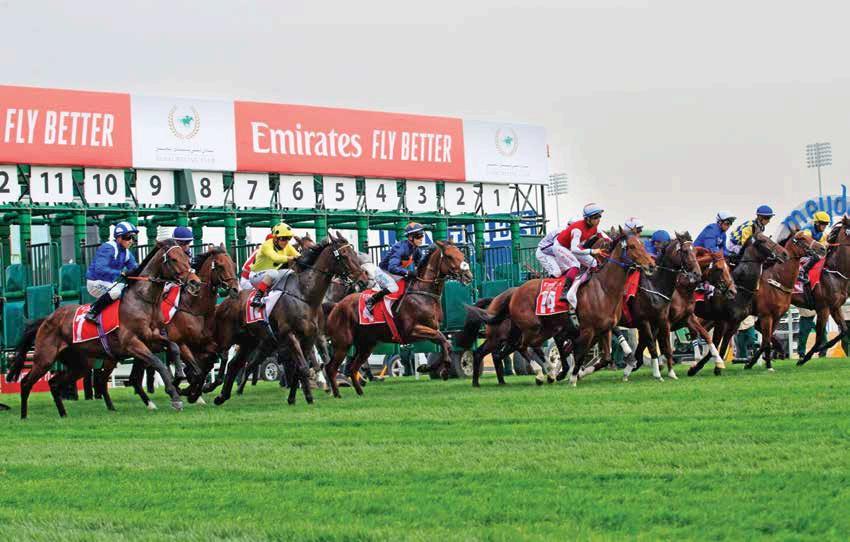
Campaign Middle East speaks to
client-side marketers and agency leaders about how sports marketing has evolved beyond logo placements, endorsements and loud campaigns to a reflection of culture, community, common bonds and – above all – belonging.
Sports marketing is shifting gears. It is accelerating past traditional sponsorship plays, broadcast tie-ups, naming rights and endorsements. The old manual that mandated mere brand presence is being rewritten. Marketers are beginning to move beyond the clutter of logos plastered on sports jerseys, media walls, racing cars, virtual on-screen overlays, and banners on the perimeters of the playing field. Rather than only being seen, brands are now also attempting to be felt, experienced and remembered. Binoculars that once zoomed in on athletes and their achievements have now given way to cameras that capture every bit of emotion on the faces of fans. Every moment matters – from celebrations and commiserations when fans walk out of the stadium to memories made with friends, families or a fiancé-to-be –before, during and after a sports season ends.
Brands are being urged to become participants in the narratives they inhabit. The shared emotions and lived experiences that forge strong bonds between sports fans – or rivals – can now
extend to a brand-consumer relationship. The result is a marketing discipline that looks less like a slideshow or a logo on a looped video, and more like a living, breathing relationship between fans, athletes and the brands that align with their hopes, dreams and values.
Consumers and communities are not content with passive consumption; they seek purpose, co-creation and cultural alignment. The new marketing manual, therefore, has to account for experiences

By Anup Oommen Aljehani
culture and identity. It needs to be informed by data but must be anchored in human storytelling. The end goal is more about resonance than reach, more about trust than visibility, more about cultural movements than sporting moments.
Taking a deep dive into the new age of sports marketing, including investments, rebalanced budgets, content collaborations, building brand love and loyalty, and data-led storytelling, Campaign Middle East speaks to client-side marketers and agency leaders, including:
Bilal Fares, Senior Vice President and General Manager, adidas EMC, Sophie Ryan, Head of Corporate Communications, Marketing and Brand, Dubai Racing Club, John Nolan, Head of Sport and Commercial Investment – MENA, Publicis Groupe Middle East, Ali Aljehani, Senior Vice President –Consultancy, dentsu Sports and Entertainment KSA, Dr. Craig Wilkie, Managing Director of Maydan Sports, a Stagwell sports collective, Razan Karim, Head of Communications –
Fashion, Beauty, Lifestyle, HAVAS Red Middle East, Neha D’Souza, Senior Media Director, Equation Media, Alan Holt, Group Managing Director, ES Sport, and Dawn Barnable, Founder, The Mettleset, one of the Middle East’s first and only sports media platforms to put women in sport first.
As the following responses suggest, the most durable campaigns are those that can be worn, shared and lived – whether through personalised products, creator-

driven content or community-led and culturally relevant stories that outlive the scoreboard. The consensus is clear: Sport’s greatest partnerships will be those that help fans feel seen, heard and part of an experience.
FROM CHASING CPMS TO FOLLOWING CPS: CULTURE, PARTICIPATION AND STORYTELLING
Industry leaders articulate a shift from visibility to relevance, from impressions to emotions, from interruption to integration, and from a one-way message to co-authored narratives.
Publicis Groupe Middle East’s Nolan says, “Old school sports marketing was about being seen. New school sports marketing is about being relevant and being part of the story. Fans don’t just
want to see a logo; they demand authenticity, interactivity and emotional relevance. Gen Z and millennials prioritise purpose and participation over passive consumption, driving brands toward co-creation and genuine passion. The new playbook now centres on experiences that blend sport, entertainment, and culture, leveraging creators, data and storytelling, and going beyond live moments.”
Echoing these thoughts, dentsu Sports and Entertainment KSA’s Aljehani adds, “The old playbook is obsolete because the game has fundamentally changed. We are moving from an era of interruption to an era of integration. Fans are no longer a passive audience; they are the protagonists of the story, demanding
a role in the narrative. In a region such as the Middle East, where sport is the lifeblood of cultural pride, the only strategy that matters is to build with them – not for them. True connection isn’t found in exposure, it’s forged in shared experiences, authentic identity and a deep sense of belonging.”
Leaders agree that the playbook has shifted from transactional performance plays to purpose-driven storytelling and purpose-driven connections. Connecting with consumers, collaborating and co-creating with fans, community building narratives and cultural experiences come back to the fore.
“THE WINNING BRANDS WILL BE THOSE THAT TRANSFORM ATHLETES INTO STORYTELLERS, FANS INTO COLLABORATORS, AND EVERY CAMPAIGN INTO A CULTURAL EXPERIENCE THAT LIVES BEYOND THE MOMENT.”
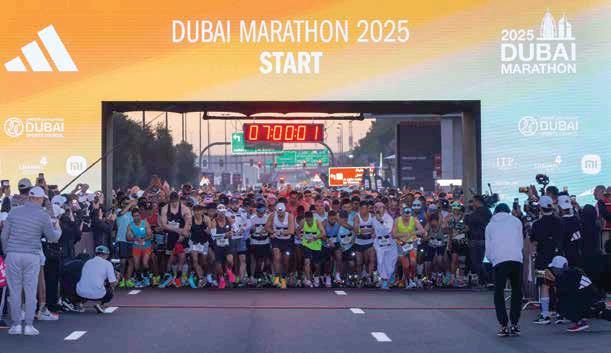
Adidas EMC’s Fares explains, “The way audiences engage with sport today has evolved. For brands, it’s no longer just about who we sponsor, but about the stories we tell and the meaning we bring to people’s lives through that connection. At adidas, we see sport as a cultural language that transcends the field. When we show up in sport, we’re not simply buying visibility; we’re shaping narratives that inspire communities, empower creators and reflect the values of the next generation. For us, sport is culture, and the most powerful connections happen when our stories live authentically at that intersection. That’s where real impact, relevance, and loyalty are built.”
Equation Media’s D’Souza says, “Having worked with several global and regional sports brands, I can say that today’s consumer isn’t just watching sport, they’re living it through culture, lifestyle and identity. The new playbook is built on participation that celebrates real stories, micro-moments and shared values. The winning brands will be those that transform athletes into storytellers, fans into collaborators, and every campaign into a cultural experience that lives beyond the moment.”
This calls for a framework that treats fans as co-creators, sports marketing as relational rather than transactional, and storytelling as an ongoing practice rather than a sprint to the next launch.
Leaders agree that since social media algorithms have morphed to mirror human behaviour, sports marketing must evolve to match new emotional, psychological and social demands.
Dubai Racing Club’s Ryan says, “There’s a continuing shift from spectatorship to participation, creating ecosystems of interaction that extend far beyond the finish line or the final whistle. In a world now fully connected – through travel, social media and shared digital culture – every touchpoint has global potential. Sports marketing today isn’t about reaching a market; it’s about reaching a mindset. What drives long-term connection is the emotion that surrounds the sport – the stories, people, and shared experiences that turn admiration to attachment.”
ES Sport’s Holt says, “Thankfully the days of putting a superstar on a billboard












to promote a product that you know they wouldn’t ever use and calling it a sports marketing campaign are almost gone. Consumers are arguably more savvy now, and obviously with social media, the negative backlash this type of marketing can cause makes both brands and the athletes think twice before signing these type of endorsement deals.”
Holt adds, “Sports fans are extremely passionate, and frankly obsessive, about their particular teams and sport. So, they are naturally vocal, and love to be involved in the debates and discussions around particular games, players or brands. They also operate as a collective group. So, when a brand has a marketing campaign that resonates, this will no doubt be shared and often go viral within their networks. The best sports marketing now is where the brand taps into those topical issues of the day and resonates the emotions they are feeling and discussion they are having while still staying true to what they stand for.”
Marketers and agency leaders also call for a better understanding of fans and their preferences rather than ‘momentwashing’ based on what sporting event happens to dominate discussions during the year.
This requires a shift from pursuing CPMs (cost per thousand advertising impressions) to CPS – an abbreviation for culture, participation and storytelling.
Stagwell sports collective Maydan Sports’ Wilkie says, “Fans want immersive experiences, not just passive viewing. They want to influence, share and co-create. That means focusing on ‘what will the fan do?’ not just ‘what will the fan watch?’ Audiences expect brands to stand for something. They want to know who the brand is. Brands that stand at the intersection of culture, sport, and identity will achieve resonance as well as reach. The playbook is moving from ‘drive impressions’ to ‘drive involvement and meaning’.”
The recent professionalisation of trail running in the UAE is a perfect example. Once a niche sport, it now drives increasingly high levels of participation and engagement, reshaping how brands and audiences connect with each other. These communities aren’t just watching the story unfold; they’re writing and shaping it.
Echoing sentiments on the move towards meaningful marketing, The Mettleset’s Barnable says, “We’re seeing a
shift from mass appeal to marketing with meaning, from reaching everyone to resonating deeply with specific people. Sport is increasingly defined by its subcultures: running crews, cycling clubs, adventure sports, fan communities, and grassroots leagues. The new playbook isn’t about visibility, it’s about belonging, connection and adding real value to the cultures shaping sport’s future.”
Sports marketing has also seen a definitive shift from transactional sponsorships to being timely cultural programming. Context and local storytelling are combining to connect brands with hyper-local communities in the region. From jerseys grounded in national pride to behind-the-scenes storytelling, sports marketing has instilled a sense of shared identity, belonging and purpose.


“SPORTS MARKETING IS NOT ABOUT BEING THERE; IT IS ABOUT BELONGING THERE. FANS REWARD BRANDS THAT ARE IN FOR THE LONG HAUL – ACROSS THE HIGHS AND LOWS. IT IS NOT ABOUT A QUICK WIN.”
Explaining the evolution of sponsorship “from a transaction to a transmission of culture,” Aljehani says:
“A logo on a jersey is just visibility; it’s the old currency. The new currency is voice, values and narrative. Sport is the language of national spirit, and brands must now be fluent storytellers, not just loud advertisers. The real opportunity isn’t to buy space on the field, but to earn a place in the fan’s heart by becoming an authentic part of the cultural soundtrack.”


HAVAS Red Middle East’s Karim says, “Sport is a cultural force that shapes identity, belonging, ambition and even social progress. Brands have a responsibility to show up in ways that honour that meaning. Audiences no longer respond to logo slapping, but rather to brands that understand the emotional fabric of the game and the communities behind it.”
When HAVAS Red launched the Saudi Arabian Football Federation (SAFF) jersey in partnership with adidas, the agency grounded the story in national pride and hyper-local communities.
“The story was not about logos on kits, but instead a story of pride, belonging and the people who breathe life into the game every day,” Karim adds.
Referencing the seven-season documentary, Formula 1: Drive to Survive, and the All or Nothing TV series about Arsenal Football Club, Nolan adds, “Sport is now as much about the entertainment franchises as the numbers on a scoreboard, whilst still delivering incredible reach. Sport is a defining factor in cultural identity: My local team, my national team, my club, my country. It matters; it cuts deep. It has always been an unpredictable, unfolding narrative that defines who we are and who we want to be. So, sports marketing must evolve from transactional sponsorships to narrative-driven cultural ecosystems.”
Leaders agree that sports marketing is no longer about owning a patch on a jersey, but more about owning a moment in culture in a way that reflects emotion, values and identity.
Wilkie explains, “Maydan works with clients who don’t just ask ‘Which team can we sponsor?’ but ‘What narrative can we weave? What experience can we craft?’ Our approach says: ‘Let’s identify the story that sport is telling in this region right now; let’s identify the audience who live and breathe that story; and let’s ask: How can our brand meaningfully join that story?’ Brands that act like they’re just sponsoring the event will be visible but not loved.”
Similarly, Holt at ES Sport, which partners with major sporting events such as the Dubai Marathon and teams such as the UAE national football team, calls for a more culture-driven approach with a shared set of habits, values and actions.
He says, “We advise and support our clients to create experiences that genuinely reflect what matters to fans at all steps in their

journey, using authentic storytelling and integrated brand presence. When executed well, this strategy enhances how sports marketing is experienced and strengthens the bond between brands and the audiences, which will last much longer than the specific event they have sponsored.”
Building on the discussion, Barnable adds, “We live in an era of hyperpersonalised worldviews shaped by intelligent algorithms, where audiences connect both online and in real life through shared identity and purpose, not visibility alone. The most effective sports marketing now lives at the intersection of culture, creativity and community. It’s not about attaching a logo to a jersey; it’s about aligning with a movement and supporting the growth of that movement. The brands winning today are those creating meaning, not noise, in people’s lives.”
That said, marketers leaning into sports marketing with a culture-first mindset also often tend to overfund the launch, get absorbed in the live moment, and underinvest in the aftermath.
Agency leaders agree that the time has come to rebalance budgets and activate campaigns toward the ‘shoulder’ and ‘after’ windows of a campaign – through replays, creator cuts and community rituals – when loyalty compounds and CPMs are lower. Leaders press the case for sustained momentum, rather than one-off, temporary spikes.
D’Souza says, “A launch is just the ignition and what sustains relevance is the ‘always-on’ engine. Momentum shouldn’t fade after the reveal; that’s when real brand equity begins to build. The real value lies in sustaining the momentum, keeping the conversation alive and delivering consistent value. Continued investment during these phases drives cost-efficiency, deepens loyalty, and builds the kind of long-term equity that one-off bursts can’t achieve.”
measure of brand values, brand relevance and brand love. Sport isn’t a cheap option. If you are buying the wrong thing for the wrong reasons, it is going to be very expensive. If, however, you are buying the right thing for the right reasons, it can be a bargain.”
Through the conversation with marketers and agency leaders, the role of data in sports marketing emerges as indispensable, although leaders question the intention of using data.
They call for data to illuminate human truth, not eclipse it. Leaders warn that in a sector charged with emotion, data must inform storytelling by leading to a better understanding of human emotion rather than overshadowing the beauty of the sport.

“You can’t ignore the ‘D word’, but there is a risk that it becomes the story. Data is part of the story, but the best stories start with a blank sheet of paper and are then enhanced by data. There’s a great phrase about not letting facts get in the way of a great story. Sport is a classic example of opinion being more important than facts and figures. However, when data is used correctly it can become valuable social currency.”
Data elevates the moment when it fuels empathy, allowing us to understand the rhythm of a fan’s passion and craft stories that resonate with their very identity. It becomes noise the instant it overshadows the soul of the sport, reducing passion to a percentage and legacy to a statistic. The future doesn’t belong to those who can simply collect data; it belongs to those who can translate it into meaning, emotion and unforgettable human moments. The ultimate algorithm is, and always will be, the human spirit.”
Addressing the argument from a creative perspective, D’Souza says, “Data becomes the backbone of modern sports marketing when it doesn’t replace creativity but refines it. When used right, it gives depth to storytelling by decoding fan sentiment, predicting momentum, and personalising engagement in real time. But when brands start optimising for metrics instead of meaning, the story loses its pulse. The key is to use data as a creative lens, not a leash.”
“In today’s game, emotions drive impact and data leads the insight to make that emotion sharper,” D’Souza adds.
Experts reach a consensus that while data is one of the most powerful tools in a marketer’s toolkit, it’s effectiveness entirely depends on how it is wielded.
“Data-led storytelling should give insight that actually changes the fan experience. Used in real time, it lets brands respond to live moments, build relevance and deepen a connection. The key is to let data inform the story. It becomes noise when it produces numbers without context. Especially in sport, where culture and atmosphere
Nolan adds, “We’ve been discussing how sports marketing goes beyond the live moment. While there is an opportunity for clients to rebalance budgets, the real opportunity is for clients to do more with what they have. Owning the conversation is critical, before, during and after the game. Real metrics, real returns-on-investment (ROIs) aren’t just a media number based on a cost-efficient reach, they are a
on a cost-efficient reach, they are a


Karim adds, “Data-led storytelling is at its best when the intention is to better understand our audiences’ motivations, emotions and the moments that matter most to them. When used well, data brings clarity to fan behaviour and cultural shifts, enabling us to create stories and experiences that feel genuinely personal and relevant. It becomes noise when marketers lead with numbers over meaning, or use data just to be clever rather than to connect on a deeper level.”

define occasions, data alone can’t carry the narrative. When it’s tied to story and context, it can be transformative,” Wilkie says.

The power of data, when paired with human sensitivity, can enable brands to respond in real time to live moments, preserving relevance long after the stadium lights dim.
When misrepresented, numbers crowd out emotion and risk alienating the very fans that brands seek to celebrate. Experts insist on a disciplined approach: let data illuminate the human experience, never replace it.

Aljehani says, “Data is the compass, not the destination. Its true power is in illuminating the ‘why’ behind the ‘what’.
Before the discussion concludes, marketers and agency leaders are invited to share a parting message on sports marketing. They offer succinct, practical counsel, calling for focus, clarity of purpose, cultural literacy and a commitment to long-term relationship building.
Leaders unanimously agree that sport is not an arena in which brands merely





occupy space but a space in which brands earn trust by aligning with communities’ values and aspirations.
Nolan says, “If you’re going to do it, do it right. Don’t do five things, do one thing brilliantly. You need to own the passion for sport with the same intensity as your audience. Sports marketing is not about being there; it is about belonging there. Fans reward brands that are in for the long haul – across the highs and lows. It is not about a quick win.”
Fares adds, “Stay true to the athlete, to the community and to culture. Sport is evolving faster than ever; it’s no longer confined to stadiums or screens. Brands that thrive in this space are those that listen first, understand the pulse of their audience, and show up authentically in their world.”
The through line is that sport has the power to not only unite people through shared emotions and lived experiences; it also has the power to connect brands with individual fans in a way that drives love and loyalty. Cue: Manchester City fans who make the most of every opportunity to don their jerseys when they head to the Etihad stadium in Abu Dhabi, or the Arsenal fans who just happen to own Sobha Realty properties.
Ryan says, “The future belongs to brands that treat sports marketing as a human story, not a media asset. In horse racing, a race may last two minutes, but behind each stride are years of passion, teamwork and dedication – that’s where the magic lies. My advice? Build with empathy. The brands that will stand out are those that understand one truth: connection is the real currency. Winning hearts lasts longer than winning headlines.”
With a willingness to engage in the deeper cultural business of sport, brands can become more than sponsors; they can become co-authors of the communities they seek to serve. The Middle East’s vibrant and rapidly evolving sports culture offers a particularly fertile ground for these ideas to take root – where people are both deeply proud of their heritage and eager to participate in innovative forms of athletic expression and engagement.
Holt explains, “The Middle East is home to a thriving and active sports scene, and recent events such as the Abu Dhabi Grand Prix, Euroleague Basketball and Dubai Rugby Sevens highlight just how much impact sports marketing can
have for brands wanting to attract either local, regional or international attention. This means the scale of opportunity is significant. However, sports marketing should never just be about logos or athlete endorsement – it can be so much deeper and longer lasting. What matters most is building real connections – whether through participation, strong partnerships, or campaigns that genuinely resonate with fans on an emotional level. Authentic connection leads to trust, and in this industry, that’s the true driver of value.”
Wilkie advises, “Ask yourself: What role do I want my brand to play in this sports landscape? Brands that win are those that have clarity of purpose. Cultural curiosity and being locally literate are so important.
He adds, “We’re clear on our own purpose at Maydan Sports: To drive real participation and all the benefits that sport brings; economically, societally and in individual wellbeing. We help brands move from being seen in sport to being felt in sport. We build strategies, stories and experiences that connect with fans and endure long after the final whistle.”
Aljehani concludes, “The brands that win tomorrow won’t be the loudest; they will be the ones that listen best and earn their place in the heart of the community.”
The dialogue leaves little doubt: Today’s sports marketing is a discipline in which culture,
“BUILD WITH EMPATHY. THE BRANDS THAT WILL STAND OUT ARE THOSE THAT UNDERSTAND ONE TRUTH: CONNECTION IS THE REAL CURRENCY.”
community, and character matter as much as campaigns and endorsements.
The leaders agree on a simple truth: Sponsorship is a starting line, not the finish line.
To thrive, brands must integrate investments with the lived culture of sport, co-create with passionate communities, and cultivate relationships that endure long after the sporting season’s end.
The future belongs to those who can translate loud moments into meaning, who see fans not as a market but as a community, and who acknowledge sport’s power to shape identity as much as it entertains the eye.
The conversation ends where it began: Sport is a language of belonging. The brands that master this language will not only reach audiences; they will also become part of the emotional rollercoaster that connect communities and fan bases on a much deeper level.
The future of sports marketing, as these leaders suggest, is less about the reach of a single campaign and more about the resonance of a shared life in sport.
It is a future defined by co-creation, cultural sensitivity, and an unwavering commitment to meaning that outlives the next whistle.
And in that future, when fans look at a piece of branded merchandise or a co-created product, they’ll recognise more than a logo: they’ll recognise a story in which they themselves played a part.
















In conversation with Campaign Middle East, marketers and professional athletes share a winning formula for how brands can make the most of their pro-athlete partnerships.
Picture this: It’s half-time at your World Cup final of choice, and everyone gathers around the television. Eyes across the globe tune in while advertisements begin to roll. Your favourite athlete is featured promoting cologne, cars or insurance plans, and you find yourself paying attention.
The usual questions arise in conversation: I wonder how much the athlete was paid to promote that product? Does that brand align with the athlete’s values and lived experiences? I wonder how much that cologne costs? Do I want to buy it as well?
It turns out that we as consumers – or fans of a sporting legend – connect with the brand ambassadors we like before we learn to love a brand.
However, this form of marketing falls flat if there’s a lack of authenticity, leaders tell Campaign Middle East. Consumers need to see their personal values reflected in the athletes that they follow in order to emotionally invest in the brands that they represent.
“Unlike other industries, sports fans don’t just consume content – they live it,” says Seth Hand, Managing Director –Middle East, TrailRunner International. “Their emotional investment in their favourite teams and athletes is deeply personal and can often define their
personality and communities they live in. That’s why authenticity is the most valuable currency in sports marketing.”
This is especially pronounced in the Middle East, where sport is an increasingly powerful driver of national identity and economic transformation.
Explaining why authenticity is extremely significant in the region, Hand says, “Fans in the Middle East are not just spectators; they feel they are part of a shared story of national and regional growth and ambition. The
brands and organisations that understand this can build relationships that go far deeper than just creating awareness.”
This requires brands to view sports marketing as far beyond a sponsorship play. It requires brands and athletes to ‘walk the talk’ together. For instance, the Saudi Sports for All Federation (SFA) has committed to athlete collaborations rooted in community outcomes to resonate with consumer values and build trust.
Abdulaziz Binhassan, Senior Marketing and Communications Specialist, SFA, explains, “Authenticity begins when a partnership serves a purpose larger than exposure. In Saudi Arabia’s Vision 2030 era, authenticity means representing shared ambitions such as national pride, wellbeing and progress through athletes who live those values. When purpose and personality align, the impact becomes both emotional and measurable. It’s not about borrowing influence; it’s about building shared meaning.”
Agreeing with this notion, Sony AbdelMohsen, Partner, Innovation Crew, says, “Authenticity is when an athlete’s story and a brand’s truth walk the same path, you can’t fake that chemistry.”
A great example of a brand and athlete going the distance together is PepsiCo with Mo Salah. AbdelMohsen, who worked with PepsiCo for more than four years, explains how Pepsi’s Grassroots Programme – which was then called the Pepsi School League in Egypt – helped the young Egyptian footballer find his feet before he became a regional and global sensation. “Mo Salah’s relationship with Pepsi didn’t start with fame; it started at the grassroots,” AbdelMohsen says. Pepsi’s foray into sports marketing didn’t begin with Mo Salah. It didn’t end with Mo Salah, either.
The Pepsi School League in Egypt remains one of the longest-running youth sports initiatives in the region. It gives thousands of young players a platform to compete, grow and dream bigger.
“From those early school pitches to global stadiums, Salah’s journey reflects the same Pepsi belief: dare for more and live what you love,” AbdelMohsen adds.
This shows how a brand’s values can shine even brighter through the lived experience of athletes.
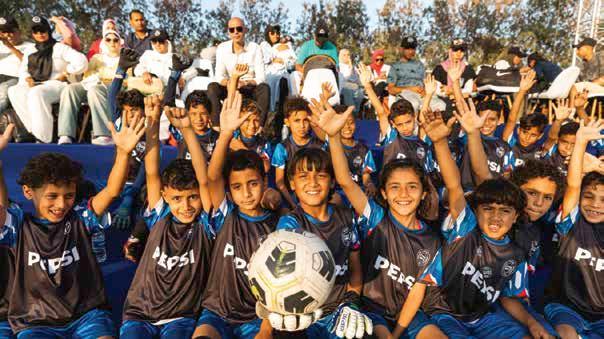















Speaking as a fan, AbdelMohsen adds, “Even after leaving PepsiCo, I continued working on their football programmes, including Pepsi Stars and Pepsi Grassroots. Watching young athletes rise through those systems from local talent to national pride has always inspired me. That empowerment, that consistency, is what real authenticity looks like.”
Diving deeper into the kind of values that PepsiCo looks for in the athletes it partners with, Karim Mohsen, Chief Marketing Officer – Middle East Africa, PepsiCo, says, “We look for shared values such as energy and passion. When a partnership feels like a continuation of what the athlete already represents, it feels authentic.”
He adds, “Authenticity in sports goes beyond visibility or forced endorsements. It’s about alignment between what the athlete stands for and what the brand believes in.”
Fleur Castle, CEO, F31, takes this a step further stating that these shared values must go beyond what brands and athletes ‘believe’ and must be visible in their daily lives.
She explains, “Authenticity comes when a brand’s values map to an athlete’s lived story – how they train, fuel, perform and recover – and when the brand genuinely contributes to that journey. In technical categories, it’s simple: does the product make the athlete better?”
While it’s important for athletes serving as brand ambassadors to reflect shared values, it’s also equally important for the brand to reflect what an athlete stands for.





This requires collaboration and co-creation
Calling the decades-long collaboration between Kenyan marathon runner Eliud Kipchoge and Nike a benchmark in sports marketing, Castle says, “Kipchoge doesn’t just wear the products; he also helps invent them. He brings them to life in ways that capture global imagination.”
Castle adds that in non-technical categories, partnerships need to work harder to be authentic.
Rather than merely looking at brand and business outcomes, Castle says that it’s important to ask how a brand can help an athlete grow, and what meaningful, transferable value the athlete can give back.
But authenticity alone is no longer enough. As the region’s sports economy accelerates,


‘‘MEANINGFUL PARTNERSHIPS CREATE VALUE YOU CAN’T ALWAYS CHART IMMEDIATELY; BUT YOU FEEL IT IN CULTURE, COMMUNITY AND LONG-TERM BEHAVIOUR.’’
brands and athletes are learning that genuine partnerships must also deliver mutual, measurable value. It’s not just about awareness or visibility but rather growth for both sides.
Marketers suggest that brands must consider the athlete beyond the sport and extend partnerships to holistically include the highs and lows of an athlete’s career.
F31’s Castle agrees, saying that the strongest relationships are those that support “the whole athlete” far beyond peak performance years. Injury, maternity leave, retirement – the moments most brands ignore are, she says, is where true partnership is tested.
“Corporates that offer career pathways for former athletes are a brilliant example of mutual benefit,” says Castle. “Some of the smartest, most tenacious people I’ve worked with come from high-performance sport. Bringing those athletes into the business post-retirement turns a sponsorship into a multi-decade value proposition.”
To hear from some of the region’s athletes themselves, Campaign Middle East hands the floor over to:
• Evren Ozka, entrepreneur, endurance runner and PUMA athlete
• Nelly Attar, extreme sports athlete and
• Rasha Abdo, Jordan Women’s National Team basketballer.
They make the case for what it means to be truly represented by a brand and offer personal insights on how athletes can be purpose-driven custodians of a brand through mutually beneficial partnerships.
“Authentic partnerships go beyond logos and campaigns; they reflect shared values,”









says Abdo. “When a brand celebrates who you are on and off the court, it creates a genuine connection that audiences can feel.”
“The athlete brings credibility, passion, and a real story that inspires people, while the brand provides a platform and purpose that amplify that voice,” she adds, stating that collaboration can build something meaningful “that connects with communities and drives positive impact for both.”
Attar says that she only works with brands that she believes in and that value her authenticity, creativity and voice. “Otherwise, it is not an authentic or genuine partnership,” she explains.
“When there is genuine alignment between the athlete and the brand, everything flows naturally,” says Ozka. “It is not just about visibility or logos, it is about both sides believing in the same things.”
He adds, “Brands must support the athlete’s overall journey, not just their performance. And from the athlete’s side, it is about representing something you care about. When that connection is real, both sides benefit because fans can feel the authenticity.”
While half-time commercials may still capture attention, the value of sports marketing today has shifted beyond visibility and short-term attention metrics to changing consumer behaviour and fostering long-term brand relationships.
“Influence in sports today is not only about the number of followers, but also about measurable behaviour change,” says Binhassan. “Campaigns that inspired real behaviour change consistently outperformed those optimised only for clicks.”




























Innovation Crew’s AbdelMohsen argues that emotional resonance is the most accurate indicator of influence. His reasoning behind this is visible in Pepsi’s long-running work with Sami Al Jaber, Farah Jefry and Mohammed Al Owais – athletes chosen not for follower counts, but for the values they symbolise: legacy, ambition and national pride.
Binhassan builds on this, explaining how athlete-led advocacy helped scale the Riyadh Marathon from 10,000 runners in 2022 to more than 40,000 by 2025.
“At SFA, we track impact through both digital engagement and real-world participation,” he explains. “The growth of the Riyadh Marathon is proof of when influence inspires action rather than impressions.”
“Brands must measure resonance, not just reach, by evaluating consistency, authenticity and long-term outcomes,” he adds. “The real metric of success is not who saw the message but who moved because of it.”
If building trust, credibility and cementing lasting behaviour change is the objective, Castle says that athletes definitely deliver commercial value. They build deeply engaged and passionate audiences when they invest in stories people care about.
“That emotional connection is an opportunity for brands to make their corporate messages feel personal and believable,” says Hand. “When an athlete or an ambassador aligns with a brand’s purpose and values, awareness turns into influence, action and loyalty.”
Furthermore, Hand explains that in digitally native, culturally connected markets within the Middle East, authenticity
and relevance outperform volume metrics.
“Real influence moves people to act, not just scroll,” he says. “The brands getting it right have stopped counting likes to measure impact and credibility.”
On that note, Castle says that when measuring the success of athlete-brand partnerships, traditional dashboards don’t make the cut as they capture exposure, not behaviour.
She advises that this is where the industry must mature. “Dashboards help with reporting, but they rarely capture true behavioural change and cultural impact,” she says. “The most valuable partnerships build movements, not content calendars.”
“Data still matters – it keeps us disciplined – but meaning creates loyalty and advocacy,” she adds, arguing that success should reflect outcomes such as community growth, behaviour change, cultural relevance, or athlete-brand product integration, depending on the brand’s objectives.
“Meaningful partnerships create value you can’t always chart immediately,” she says, “but you feel it in culture, community and long-term behaviour.”
Across all voices, the message is clear: successful brand-athlete partnerships are defined by movement – by people who act, not merely watch. This is particularly true in the Middle East, as national identity, youth sentiment and sport are deeply intertwined.
“In Saudi Arabia’s fast-growing sports economy, meaning drives movement and movement drives value,” says Binhassan. “Brands should evaluate how their initiatives contribute to Vision 2030 goals such as community engagement, youth activation and healthier lifestyles.”

Women’s sport is becoming a brand-building arena defined by cultural momentum, a passionate fan base, and female athletes who are committed to community building. MENA marketers are starting to leverage an ‘untapped white space’.
Women’s sport isn’t a trend. It’s a long-overdue recognition of women’s performance, influence and impact in sports.
Women’s sport has entered a breakout era: investment is rising, viewership is climbing, and brands are waking up to the fact that this isn’t just a ‘good cause’. It is quickly becoming one of the most culturally charged and commercially promising brand-building arenas in modern marketing.
However, leaning into women’s sports marketing requires strategic thought and investment that goes far beyond copy-pasting what works for men’s sports.
Leaders from PepsiCo, FootballCo, Volkswagen, The Mettleset and M+C Saatchi raise a crucial question: Has the time come for brands to move from being spectators to becoming architects of the next era of women’s sport?
This feature explores how MENA brands can step into women’s sport not as temporary benefactors, but as long-term builders of an ecosystem set to define the next decade of fandom, culture and commercial growth.
THE UNTAPPED ‘WHITE SPACE’
Dawn Barnable, Founder, The Mettleset, says the regional potential is enormous.
She says, “Women in sport are powerful. Engaging women in sport, whether women’s sports or women who are sports fans, remains one of the biggest opportunities in marketing. Women are among the fastest-growing fan segments in sports from F1 to the NFL, and globally, women’s sport is seeing record interest, attendance and valuations. Regionally, 44 per cent of Saudis now report following the Saudi Women’s Premier League.”
What truly stands out for marketers, however, is the untapped white space: a rare chance to build brand meaning and be a part of something bigger than just momentum, a corporate social responsibility (CSR) activity or a sponsorship play.
“This is no longer a CSR exercise; it’s a powerful brand-building opportunity anchored in momentum, inclusivity and cultural relevance,” argues Amanda Fox-Pryke, Senior Client Director, M+C Saatchi Sport & Entertainment Middle East.
“It’s not just a sponsorship opportunity; it’s about shaping cultural progress,” adds Virginie Ludmer, Marketing Director, Volkswagen Middle East
She explains how Volkswagen, which stands for progress and movement, and shares the tagline ‘moving people forward’, supports women’s sport with purpose, championing it through initiatives such as local partnerships with Qatar Foundation. Its campaigns, such as #NotWomensFootball, challenge outdated perceptions and celebrate the skills of female athletes.
Fox-Pryke says, “Women’s sport is an exciting, progressive moment for brands to engage new audiences, unlock fresh revenue streams and tap into the rapidly expanding female sports economy. With record-breaking global viewership, fast-growing female fanbases, and exponential engagement, MENA brands now have access to an emotionally invested audience that rewards authenticity.”
THE CASE FOR EARLY ADOPTION
Women’s sport represents a chance for marketers to lead rather than follow.
Andy Jackson, SVP Middle East, Footballco, says, “Brands that associate with women’s football today can be part of its growth story, shaping it and being recognised as supporters – both now and in the future. This isn’t something often considered in men’s sports because the opportunity is rarely available.”
The Mettleset’s Barnable adds, “Too often, brands wait to support athletes until after they’ve ‘made it’. What’s relevant is in the future. Savvy brands don’t just celebrate what’s happened; they invest in what’s next. Globally, 96

per cent of women who love sport believe it’s important for brands to support social issues; that’s a powerful opportunity. The best brands know the value of being part of the story from the start – like with the case of New Balance and Coco Gauff.”
The numbers support the narrative.
According to Nielsen Sports’ and PepsiCo’s Undervalued to Unstoppable report, women’s football is projected to become one of the world’s top five sports, with a global fanbase expected to exceed 800 million by 2030.
Ibrahim Zeinelabdin, Chief Marketing Officer for Foods, PepsiCo Middle East, says, “Because the
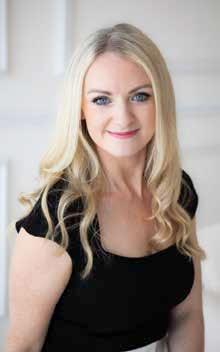
ecosystem is still developing, early partners can help set standards and earn trust, provided the investment is consistent and creates value both on and off the pitch. That offers incremental reach and deeper relevance for brands.”
As viewing access to women’s sport rises in the region, PepsiCo’s partnerships, multi-year commitments and community programmes with the UEFA Women’s Champions League, UEFA Women’s EURO and the Saudi Women’s Premier League have translated into stronger credibility and brand outcomes in the GCC region.
This growth isn’t anecdotal. The Women’s Sport Trust reports record engagement, with total viewing hours rising 16 per cent year-on-year and digital audiences growing fastest among women. Women’s sport also gives brands the opportunity to connect with younger, more diverse audiences that reward
authenticity and inclusivity with lasting loyalty and long-term equity.
As the discussion progresses, one truth stands out: women’s sport is being propelled by values-driven fandom. It’s a whole new ball game, and the power plays demand a whole new strategy.
Engaging female fans in sports requires fresh creative thinking, not recycled men’s strategies. Women’s sport has its own language, values and community. Yet in the UAE and KSA, 90 per cent and 79 per cent, respectively, of female sports fans say sports organisations don’t understand them. With women controlling $31.8 trilion in global spending power, the gap isn’t just perceptual; it’s commercial.
“Brands are and shouldn’t be afraid to embrace the fact that there is a distinctly different audience and culture associated with women’s football, which presents new opportunities,” says Footballco’s Jackson.
Volkswagen Middle East’s Ludmer adds, “The sport comes with its own tone, community and sense of identity. At Volkswagen Middle East, we never simply replicate what’s worked in men’s sports. Instead, we localise our creative approach to resonate with women and girls in the region, ensuring the messaging feels authentic and relevant to their journey. Our communication always focuses on empowerment, belonging, and self-belief rather than competition alone. Through content, partnerships, or on-ground activations, we make sure the narrative reflects the real challenges and triumphs women face in sport.”
Footballco’s recent report shows that 66 per cent of women’s football fans believe the sport should be celebrated for its culture and difference from the men’s game.
Leaders also emphasise the importance of leading with collaboration.
M+C Saatchi Sport & Entertainment
Middle East’s Fox-Pryke notes that the brands winning in women’s sport are those building narratives rooted in authenticity, emotion and empowerment – qualities that mirror the collaborative spirit of the women’s game itself.
This approach resonates far more than simply replicating men’s sport campaigns.
Taking the example of Sephora’s partnership with Saudi Arabia’s AlNassr women’s football team, Jackson explains, “Sephora isn’t just aligning itself with the club’s success but also using it to underscore commitment to empowering communities through self-expression, inclusivity and authenticity – terms you wouldn’t see with male-focused partnerships.”
When brands co-create with athletes and fans, rather than speaking at them, the
engagement deepens and trust follows.
This is also part of the reason M+C Group recently acquired The Women’s Sports Group (WSG) to further support clients seeking to grow ROI and asset value across women’s sport.
PepsiCo Middle East’s Zeinelabdin takes this argument a step further, calling for dedicated playbooks for every platform, occasion and event.
He says, “Show up with intent, build longer-term partnerships, and design authentic, fan-first experiences that highlight athletes’ voices and reflect the community’s values. Our bestperforming pieces are player-led and behind the scenes, revealing the human side of sport. In the MENA region, we create Arabic-first content that reflects local culture and highlights role models from the Saudi Women’s Premier League alongside global stars.
“At the UEFA Women’s Champions League Final, Pepsi creates a prematch show that brings fans into the atmosphere and the culture outside the stadium. And with Lay’s, we keep the storytelling grounded by developing relatable content that highlights real supporters and their favourite players, because that’s what fans engage with most,” he adds.


Women’s sport now sits at the intersection of spectacle and substance. Brands that take the ‘right’ turn at the intersection aren’t interrupting culture; they are embedding into it and feeding it. This is a space where brands can build meaning, not just impressions.
The mentality around women in sport is shifting. Female athletes have become active participants, creators and role models within brand narratives. They are helping brands bridge trust gaps and connect closer with key audiences. According to studies shared by Parity, people are 2.8 times more likely to act on a recommendation from a woman athlete than any other type of influencer, and 57 per cent of consumers trust female athletes to genuinely believe in the brands and products they endorse.
PepsiCo Middle East’s Zeinelabdin says, “What stands out about female athletes is the level of trust they’ve earned with fans. This shapes how we approach our own partnerships. When we partner with a football player such as Alexia Putellas, for example, we focus on her leadership and influence on sport, not just her achievements. Partnerships need to support what the athlete stands for holistically and add value to their wider mission.”
It’s also worth noting that Lay’s is the first FMCG brand in Saudi Arabia to sponsor the Women’s Premier League, a strategic partnership focusing on empowering and supporting women across various fields and providing them with the tools they need to pursue their dreams.
Volkswagen Middle East shares a similar philosophy. Ludmer explains, “We aim to build long-term, purposedriven relationships with such individuals. A great example is our collaboration with Zainab Al Eqabi, who was our brand ambassador for several years. Zainab embodies resilience, empowerment, and progress – values
that align with Volkswagen’s DNA.” Through Volkswagen’s partnership with the Qatar Foundation, Al Eqabi engaged with female teams, attended events and shared her personal story to inspire others.
“We also feature women athletes directly within our campaigns, such as the recent Tiguan launch, to showcase real representation and empowerment rather than tokenism,” Ludmer adds.
This relationship between brands, female athletes and the growing fandom for women’s sport in the Middle East has benefitted everyone involved.
In Saudi Arabia, female sports participation has surged more than 150 per cent since the launch of Vision 2030. More than 330,000 girls are now involved in structured sport, including female athletes, coaches, trainers and referees. Against this backdrop, fan expectations and behaviours are evolving.
Zeinelabdin adds, “Female fandom has grown 60 per cent in five years. The 2023 Women’s World Cup reached more than 2 billion across media. In the GCC, national broadcasts of the Saudi Women’s Premier League are creating new viewing habits, especially among younger women and families. Fans increasingly reward brands that authentically invest in women’s sports, and we’re leaning into that through creative and media choices that prioritise authenticity and representation, because that’s what builds stronger affinity.”
Despite growing participation and clear audience appetite, sponsorship remains inconsistent.
The Mettleset’s Barnable says, “From the hundreds of talented athletes I speak to regularly, sponsorship – or the lack of it – remains a constant theme. Yet, research consistently shows consumers are twice as likely to buy a product endorsed by a woman athlete versus any other influencer.”
The fan base is growing: 43 per cent of Gen Z women’s football fans have only started following the sport over the past two years. And yet, their demands are loud and clear.
“We’re seeing a clear cultural and behavioural shift – audiences today, especially younger and female demographics, expect
brands to stand for something more meaningful. They value authenticity, inclusion and social progress. Supporting women’s sports aligns directly with those expectations,” Jackson says.
This builds on data shared by Footballco’s reports, which show that Saudi fans view female footballers as powerful role models, even more so than fans in other regions.
From the sampled group of fans in the report, in Saudi Arabia, footballers are seen as the second most inspirational group of women, just behind entrepreneurs – globally, they rank fourth.
This presents a unique branding opportunity not only to support women’s football as a sport but also to align with the female players who represent a whole new level of influence.
This point is emphasised by 56 per cent of female fans saying they would think more positively about a brand that sponsors the women’s game.
However, before launching any brand partnerships and ambassador content, marketers must understand the culture, the communities and the motivations shaping local audiences.
“Fandom isn’t one-size-fits-all. Data shows that women’s fandom is more social and community-driven, valuing authenticity, inclusion and representation over scale,” says M+C Saatchi Sport & Entertainment Middle East’s Fox-Pryke.
That said, M+C Saatchi is also designing strategies that resonate with both genders because the data shows that Gen Z and male audiences now drive record women’s sport viewership.
‘‘TO SEE SUSTAINABLE GROWTH IN WOMEN’S SPORTS, BRANDS MUST LOOK BEYOND ONE-OFF SPONSORSHIPS AND FOCUS ON BUILDING THE ENTIRE ECOSYSTEM.’’
Brands also stand to benefit from partnering with female athletes, leaders say, because female athletes contribute far more to brand love and long-term loyalty. In short, female athletes are more likely to build more powerful bonds with fans.
Jackson adds, “From experience, female athletes are more open to sharing their stories and views, and this then creates a more powerful connection with fans. The sponsoring brand benefits as a result. Also, since sponsorships are still relatively new to female players, they come across as more engaged and less jaded than some of their male counterparts. On a purely financial level, brand endorsements can make a huge difference to female players who don’t get anywhere near the on-pitch salaries of their male counterparts. As a result, our content strategy around women’s football focuses more on the human stories around the players as much as it does on their on-pitch performance.”
Brands have taken notice and are beginning to shift from traditional influencer marketing to partnering with female sports icons who embody empowerment.
Pepsi’s global deal with Saudi footballer Farah Jefry and Rexona’s three-year partnership with the Saudi women’s national football team highlight this notion.
While, trust and influence are well and good, marketers also need to balance long-term brand equity with meaningful short-term return on investment (ROI). Ludmer says, “When evaluating partnerships in women’s sports, we look at both quantitative and qualitative metrics. On the performance side, we measure brand visibility, engagement rates, and digital reach. But equally important are long-term brand-building indicators – such as perception shifts, emotional affinity and increased association with empowerment and progress.”
For example, through its Qatar Foundation partnership and campaigns such as #NotWomensFootball, Volkswagen has seen higher engagement from female audiences and stronger sentiment around Volkswagen as a brand that supports inclusion and positive change.
Ultimately, the success of these initiatives isn’t just about short-term numbers – it’s about building a relationship with audiences who see brands like Volkswagen as driving change, not just providing mobility.
Zeinelabdin says, “We look at reach, sentiment and staying power. Women’s sport still offers a less cluttered

‘‘TOO OFTEN, BRANDS WAIT TO SUPPORT ATHLETES UNTIL AFTER THEY’VE ‘MADE IT’ ... THE BEST BRANDS KNOW THE VALUE OF BEING PART OF THE STORY FROM THE START.’’

sponsorship environment, which helps partners stand out. We also track how people feel after major moments. The UEFA Women’s Champions League continues to grow, with recent finals seeing increases in viewership and attendance. When we pair that visibility with fan-first experiences, we see stronger recall and preference. Ultimately, sustained improvement over time is the clearest indicator that a partnership is delivering real value.”
The WTA’s equal pay roadmap by 2033 and sold-out UEFA Women’s EURO events prove the power of equality in action. Early pioneers such as Nike and adidas set the tone, while brands such as Sephora and Barbie are inspiring the next generation of females.
Fox-Pryke says, “Success in women’s sport isn’t measured by short-term ROI alone; it’s about long-term cultural and commercial impact. Beyond engagement and advocacy, brands must recognise the deeper drivers of progress, addressing challenges such as equal pay and access.”
To truly unlock the full potential of women’s sport and contribute to its fan-led culture, brands need to support the ecosystem growth at every level –from grassroots programmes and through local leagues all the way to regional and global media visibility.
Zeinelabdin says, “One of the biggest barriers to women’s sport isn’t talent; it’s opportunity. The sport grows faster when the whole ecosystem is supported. Through our work with leading brands across sport and entertainment, we see first-hand how ecosystem support
translates into trust, growth and sustainable impact that extends well beyond individual events or campaigns.”
He adds, “We see this in Saudi Arabia with our partner, the Women’s Premier League, which now has national broadcast coverage and rising participation. This consistency creates the habits that sustain fandom. That’s how local engagement becomes lasting loyalty. Globally, our renewed UEFA partnership invests in coaching development and grassroots access because stronger foundations lead to healthier leagues. For PepsiCo, supporting the ecosystem builds long-term credibility, creates more sustainable impact, and guarantees we are part of the country’s vision and aspirations.”
Brands that invest in grassroots leagues and local media coverage of community driven programmes aren’t just supporting, but they’re shaping the future marketplace.
Ludmer adds, “To see sustainable growth in women’s sports, brands must look beyond one-off sponsorships and focus on building the entire ecosystem. That means supporting grassroots initiatives, investing in local leagues, and collaborating with partners who share the same long-term vision. This isn’t just about brand exposure; it’s about nurturing future talent, increasing representation, and ensuring women have equal opportunities to succeed in sport. In the end, that creates stronger brand affinity and contributes to real social progress.”
Footballco’s Jackson highlights the unique community aspect of women’s sport, “For many women involved in sport, local clubs provide community and a place to be themselves. This should be an authentic commitment to growing the game and providing a pathway for young girls in the sport through playing or supporting,” says Jackson.
Women’s sport may have been overlooked for decades, but this presents a rare opening.
Brands that step in now are not merely gaining visibility; they are actively driving cultural and social progress.
If done right, the long-term investment in this ecosystem will ensure that every victory, both on and off the pitch, will not only be celebrated in the moment, but will also stand the test of time.
As the region grows into a global hub for sports and entertainment, WPP Media’s Youssef Raad shares how the shift has opened a new arena for brands – across every category – to build deeper cultural relevance and long-term growth.
The echoes of the FIFA World Cup Qatar 2022 were not the end of a story, but the explosive start of a new one. That tournament served as a global showcase, a proof of concept that has ignited an unprecedented sports and entertainment boom across the Middle East and North Africa. Over the next 10 years, this momentum is only accelerating, leading to the World Cup 2034 in Saudi Arabia, creating a golden opportunity for regional brands – not just in traditional sectors, but across every single category – to connect with passionate, engaged audiences and drive transformative growth.
The landscape is shifting at a breathtaking pace. Saudi Arabia›s Vision 2030 is pouring billions into creating a global sports hub, attracting toptier football talent to the Saudi Pro League, hosting premier events such as Formula 1 and LIV Golf, and bidding for future mega-events. The UAE continues to be a powerhouse of established worldclass events, from the UFC to the Dubai World Cup. This isn’t just about sport; it’s about economic diversification, tourism and building global cultural capital.
In this new era, thinking of sports marketing as a niche for sportswear and beverage companies is a critical mistake. The modern fan experience is an all-encompassing ecosystem of passion, digital engagement, community and commerce. This is where every brand can find its place.
Luxury and fashion: Sports stars are the new global style icons. The intersection of sport and luxury is a powerful space for highend brands to engage in through athlete endorsements, exclusive hospitality and limited-edition collaborations that tap into the culture of success and aspiration.
FMCG and retail: The opportunity is to “fuel the fans”. This means smart, data-driven retail activations, special edition packaging linked to major tournaments and e-commerce promotions that are triggered by real-time match events, driving immediate sales.
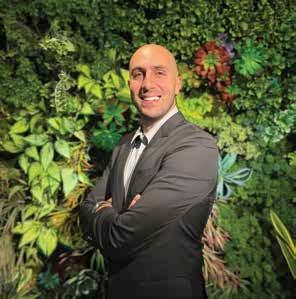
BEYOND THE OBVIOUS: A PLAYING FIELD FOR ALL CATEGORIES
The opportunity lies in moving beyond simple logo placement and authentically integrating into the fan›s journey.
Financial services: A bank can become the “Official Financial Partner” of a league, offering exclusive credit card perks for ticket purchases or launching financial literacy programs for young fans, aligning their brand with ambition and future growth.
Automotive: The connection is about more than just speed. An electric vehicle brand can be the “Official Sustainability Partner” for a major event, or an SUV brand can become the “Official Family Partner” of a football club, showcasing their vehicles as the way fans and families travel to share moments of passion.
Technology and telecommunications: These brands are the architects of the modern fan experience. They can power 5G-enabled connected stadiums, create immersive augmented reality (AR)/ virtual reality (VR) experiences, or use artificial intelligence (AI) to deliver personalised content to fans› devices, positioning themselves as essential enablers of passion.
The key is to understand that you are not just sponsoring a team; you are joining a conversation with millions of dedicated fans.
The playbook: integrated, AIpowered and outcome-focused
We see this new landscape as the ultimate arena for our integrated capabilities. Our approach is built to move brands from the sidelines to the centre of the
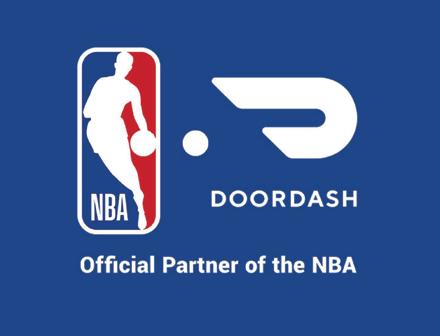

action, connecting media, data and creative to deliver measurable business results.
CASE STUDY 1
Paramount+: Global F1 partnership
The challenge: Paramount+ sought to enter the highly competitive global sports sponsorship landscape, specifically with Formula 1, and needed robust valuation, strategy, and negotiation support to secure a partnership that delivered measurable value.
The solution: We provided a detailed and robust valuation and sponsorship analysis, offering a clear point of view on the F1 proposal to inform negotiations. Leveraging a proprietary
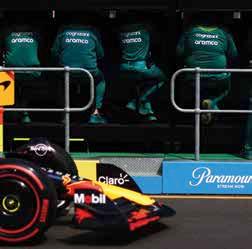
sponsorship methodology tool, they determined the fair market value of the investment and media equivalency, ensuring the asking price aligned with both media and marketplace value. They also initiated ongoing sponsorship measurement work to track success and results race-to-race, guiding activation plans and identifying areas for optimisation.
The result: Paramount+ secured a global F1 partnership, backed by data-driven valuation and strategic support, enabling effective negotiation and ongoing optimisation of their investment. This established a clear framework for maximising their sponsorship impact.
CASE STUDY 2
DoorDash: North America Locker Room Experience

The challenge: DoorDash aimed to create a scalable and engaging on-site event activation that could be deployed across multiple sporting events where they held sponsorships, driving DashPass sign-ups and spotlighting local merchants.
The solution: We developed a mobile Locker Room Experience franchise. This modular and easily deployable activation was customised for each sport and team but consistently focused on driving DashPass sign-ups in priority markets through various tactics, prizing and experiences. The experience also served to spotlight local merchants and attract new vendors to the platform. The Locker Room was designed to travel throughout North America, becoming an ownable event platform for DoorDash in sports.
The result: The Locker Room Experience became the preferred onsite activation for DoorDash across eight sporting events. It successfully drove DashPass sign-ups, engaged fans, and supported local businesses, establishing a unique and recognisable brand presence in the sports activation space.
The game has changed. The MENA region is no longer an emerging market for sports; it is a global leader. The brands that win in the next two years will be those that understand this shift and embrace a truly integrated, data-driven and creative approach to becoming part of the fan’s world.
WPP Media is built for this new reality. We are here to help you win.
By Youssef Raad, Senior Manager of Gaming and Sports MENA, WPP Media

FutureTech’s Boye Balogun explains how the realm of esports is expanding what sport means to a new generation, and reveals a real opportunity for marketers, for fans and for the future of how we play.
Sports marketing has always been about passion, identity and reach. For decades, the playbook was clear: sponsor a major team, appear on the shirt, buy perimeter boards and secure a few television spots. The goal was visibility, your logo in the right place when the crowd roared or the cameras rolled.
That model still matters but the world around it has changed. Audiences have fragmented, screens have multiplied and the line between sport, entertainment and gaming has blurred. The next generation of sports marketing is not defined by visibility; it is defined by interaction.
FROM STADIUMS TO STREAMS
Today’s sports fans don’t just watch; they stream, comment, play and post. The match may happen in a stadium, but the conversation happens everywhere. Digital platforms have made fandom participatory and instantaneous.
The first generation of sports marketing was built on geography: local clubs, local pride and national teams. The second is built on community. Supporters connect through shared interests, not shared postcodes. A teenager in London can support a team in Riyadh and watch a tournament in Seoul, all in real time.
AUDIENCES HAVE MOVED
As younger audiences migrate online, their definition of sport is expanding. They still follow football, basketball and Formula 1, but they also follow esports tournaments streamed to millions. For Gen Z and Gen Alpha, esports is not a niche, it is their native playing field.
This migration is reshaping the economics of attention. The realm of esports already commands a global audience of more than half a billion people and is projected to exceed $1.6bn in annual revenue by 2027. Game-time engagement, from live chat to in-game transactions, dwarfs traditional fan interaction. The result is an ecosystem where every second is measurable, every fan is addressable and every moment can be monetised.
Having worked on both traditional sponsorship negotiations and emerging digital partnerships, I have seen how the smartest brands are reframing their role. In the past, sponsorship meant logo placement. Today, it means participation, entering the experience itself.
In esports, brands can co-create content, design virtual skins, host tournaments or integrate into gameplay. They can appear in-game, not just on screen. These activations feel organic to players and create the kind of immersive engagement that television could never buy.
The lesson applies beyond gaming. Whether it is basketball, athletics or motorsport, the opportunity lies in fusing the physical and digital, live experience plus live data. Audiences want to be part of the story, not spectators on the sidelines.
To succeed, brands need to move from sport selection to audience planning. The key
question is no longer “Which sport should we sponsor?” but “Which audience moment do we want to own?”
This requires blending audience data, cultural mapping and behavioural insight. The realm of esports offers something every marketer chases: A young, global, highly engaged community that lives entirely within digital ecosystems. These fans are future consumers of everything from fashion and finance to food and travel, and they expect brands to speak their language in real time.
At FutureTech, we see this convergence daily. The campaigns that perform best are those that integrate media, technology and creativity into a single conversation, not a sequence of channels. Artificial intelligence (AI) now allows us to read audience signals by the second, but the real skill is knowing what to do with that intelligence. As I often say, AI gives us the data, but instinct gives us direction.
Traditional sponsorships will never disappear. The emotional power of sport, the anthem, the crowd and the shared win, remains unmatched. But the future of sports marketing will be hybrid: Physical moments amplified by digital connection.
Imagine a fan watching a football match while unlocking exclusive digital rewards or attending an esports event where physical merchandise connects directly to in-game experiences. That is where the industry is heading – from billboards to bytes, from exposure to immersion.
The brands that win in the next decade will understand that attention is the new arena. They will think less about being seen and more about being felt, participating in the culture of sport rather than simply sponsoring it
Esports is not replacing traditional sport; it is expanding what sport means to a new generation. And in that expansion lies the real opportunity – for marketers, for fans and for the future of how we play.
Have you read the book Who Moved My Cheese? Well, if brands don’t move, it will be a case of who moved my audience.
By Boye Balogun, CEO, FutureTech.
3 billion gamers globally drive more than $200bn in consumer spending, making gaming the world’s largest entertainment category.
726 million global esports viewers, with millennials and Gen Z accounting for more than 70 per cent of the audience.
Global esports sponsorship spend has surpassed $1bn, with top teams such as Team Liquid delivering media value on par with the NBA and Formula 1.
The Esports World Cup 2025 in Saudi Arabia featured 25 tournaments, 2,000 players and a record $70m prize pool, backed by more than 20 global sponsors.
Average viewing hours for top esports titles are now within reach of traditional leagues such as the Premier League and NFL.
The Middle East is the world’s most dynamic sports market, yet the prevailing marketing mindset often lags behind the region’s strategic ambition. For too long, sports marketing has been a transactional exchange of logo placement for passive visibility.
This approach is misaligned with the transformative visions driving the region’s massive investment in sport. The time has come for brands to become national stakeholders – partners in the region’s economic diversification, social development, and national purpose.
THE STRATEGIC IMPERATIVE: ALIGNING WITH SAUDI VISION 2030
The scale of sports investment in the Gulf region is a sophisticated economic and social strategy. In Saudi Arabia, the sports sector is a pillar of Vision 2030, projected to grow to 22.4$bn by 2030, according to recent PwC data.
This is not a marketing budget; it is a pillar of economic transformation. Aligning with a sports property is an opportunity to embed a brand’s narrative within the story of national progress. Global data from the recent Sports Sponsorship Performance Survey reveals that 66 per cent of consumers are more likely to purchase from companies that sponsor sports that they like. In the Middle East, this affinity is amplified when a brand’s efforts support a national goal, moving it from a commercial entity to a community partner.
Successful sports marketing initiatives in the region are shifting from sponsorship to stakeholder engagement. The Dubai Fitness Challenge (DFC), a non-

Nine71’s Bassam Mustafa explains that the time has come to go beyond viewing sports marketing as a line item in the communications budget and pivot to treating it as a strategic investment in the nation and its people.
promotional public health campaign, has seen more than 13 million participants, with 2024 data showing 18 per cent of participants reporting improved fitness.
Brands such as DP World and Mai Dubai act as facilitators, providing infrastructure and resources to help the community achieve the goal of becoming one of the world’s most active cities. Their success is linked to the public health outcome. This is the stakeholder model: Marketing return on investment (ROI) is a byproduct of its social ROI.
Similarly, the Saudi Sports for All Federation (SFA) is working to raise physical activity levels to 40 per cent by 2030 Brands partnering with the SFA on grassroots initiatives are investing in community development, supporting the Saudi Vision 2030’s Quality-ofLife Programme.
To thrive in this new environment, marketers must adopt a new framework for measuring success. The old metrics, focused on reach and visibility, are no longer sufficient. Social listening data confirms deep interest in the business and human-interest stories behind sports.
“BY EMBRACING THE STAKEHOLDER MODEL, BRANDS CAN ACHIEVE SOMETHING FAR MORE VALUABLE THAN FLEETING VISIBILITY.”
The audience seeks authenticity and purpose, not just advertising. The new metrics must shift from measuring impressions to evaluating engagement rate, which reflects affinity and trust. The focus must move beyond logo visibility to quantifying social ROI and community impact.
Ultimately, marketing expenditure must be reframed, moving away from ad spend as a cost centre and toward strategic alignment with national purpose.
By embracing this stakeholder model, brands can transform their marketing from a cost centre justified by vague exposure to a measurable driver of consumer behaviour and a genuine partner in the region’s most ambitious projects.
The shift to the stakeholder model is not exclusive to mega-corporations. It creates clear, actionable opportunities for companies of all sizes.
Large multinational corporations should focus on ‘national vision alignment’, which includes investing in large-scale, measurable social impact programmes.
Small and medium enterprises (SMEs) can excel at hyper-local community engagement, sponsoring local sports clubs and focusing on authentic, human-interest storytelling.
Local companies can become leaders in digital content facilitation, partnering with local athletes or influencers to create engaging content that promotes participation and aligns with the national health agenda.
By embracing the stakeholder model, brands in the Middle East can achieve something far more valuable than fleeting visibility. They can become genuine partners in the region’s most ambitious and inspiring projects. This evolution requires a fundamental change in mindset: seeing sports marketing not as a line item in the communications budget, but as a strategic investment in the future of the nation and its people. The opportunity in the Middle East is not just to sell more products, but to be part of a legacy that will define the region for decades to come. Brands that understand this will secure not only market share but also a lasting and meaningful place in the hearts and minds of the community.
By Bassam Mustafa, Founder and Managing Director, Nine71
From a distance, the 18 per cent share of female Saudi esports players may not seem like a number worth celebrating. But that changes when compared with the global average of just 5 per cent. This becomes nothing short of revolutionary once we zoom in on the community of Saudi female gamers who have overcome nearly every barrier placed before them – except one: The marketing industry, which still overwhelmingly prefers to spotlight male esports players, except when dealing with the traditional ‘female world’ of brands in fashion, beauty and luxury.
Yet, any number only becomes real when you come face to face with it – in this case, meet the players.
Last month, four female Saudi esports players took the stage at the Saudi Gamer Arena during Athar Festival 2025 to discuss breaking barriers and levelling up in the world of professional esports.
From the outside, they appeared quite different, each expressing herself through a different dress style. One player wore a niqab, while others chose different forms of veiling. It wasn’t planned, yet together they embodied a broader truth: There is no single template for what a Saudi female gamer or e-sports player looks like. Each arrived comfortable, confident and unmistakably herself.
Beneath these outward differences, they shared the same driving forces: Power, passion and professionalism. They also quietly defied the ‘queen bee syndrome’ so often imposed on women in male-dominated fields: The claim that female leaders distance themselves from other women or reinforce gender inequality.
Modhi Alkanhal, known as Madv, an ingame leader for Team Falcons and a Valorant star who won this year’s Best Female Player of the Year at the Saudi Esports Federation Awards, is one of the leaders shattering this stereotype. She spoke about how empowering gaming can be. She shared a message for hesitant or doubtful female players: Overcome your fear and just start somewhere. The panelists, in many ways, already act as mentors for their own community.
The players also reflected on their beginnings, sharing anecdotes of a time when society had not yet embraced esports as a space for women. Some resorted to male nicknames simply to play. Many had to justify their passion to parents who were unsure or unconvinced.
This began to shift with Vision 2030, when the government recognised esports and gaming as part of the country’s economic transformation. With that recognition came a wider acceptance of esports players, including women, under the Saudi National Gaming and Esports Strategy (NGES).
“I have a great passion for esports. I want to represent players who wear the niqab –a community that is fighting all levels of stereotypes,” said Jenan, also known as Nan, a professional Overwatch player for Twisted Minds. In 2024, her team won three majors in the Saudi Esports League. She is currently
Webedia Arabia’s Farah Choucair calls for the marketing world to level up and acknowledge the rise of female esports players and their role as drivers of engagement.
studying law and dreams of combining her academic path with her esports career.
What remains now is for the marketing world to level up and acknowledge the rise of – and the diversity within – female esports. The interest of fashion, beauty and lifestyle brands is a welcome beginning, but revolutionary progress requires broader sectors to join in. Female gamers and esports players are part of the nation’s creative economy, not a niche within its ‘pink corner’.
One reason behind the hesitation is the perception that viewership is largely maledominated. And while global data supports this – with about 67 per cent of esports viewers being men, compared with 33 per cent women – the fact that one in every three viewers is female is not a share to dismiss. More importantly, female viewership is rapidly increasing.
Internationally, publishers and tournament organisers are already seeing the shift. Riot Games’ Valorant Game Changers, created in 2021 to support women in the competitive scene, has reported year-onyear growth in both female competitors and female viewership.
On the creator side, platforms such as Twitch and YouTube Gaming show a consistent climb in hours watched for top female streamers across genres. The audiences of female esports players are not exclusively female; many have large mixedgender or predominantly male fan bases, proving that women are not only ‘niche’ talent, but are also becoming mainstream drivers of engagement.
By Farah Choucair, Head of Data and Insights, Webedia Arabia
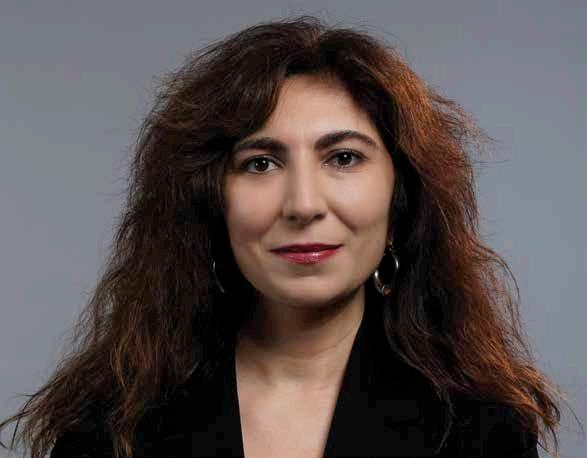

As a lifelong football fan, I’ve always been obsessed with the emotion of sport. The roar of a crowd, the heartbreak of a missed chance and the way a single goal can unite millions. But today, that emotion isn’t just felt in stadiums. It’s lived out online, in TikTok edits, memes, livestream reactions and creator content that turns every match into a cultural moment. Sport has always been theatre but now it’s participatory theatre, with billions of fans as both audience and co-creators.
That’s what our new Winning Fans and Feeds in APAC report explores. Sport is evolving, and so is fandom. The power dynamics of who shapes sporting culture has shifted. Fans are no longer passive consumers sitting behind screens; they’re storytellers, remixers and commentators who make the realm of sports feel alive 24/7.
Women-led communities are rising and reframing what fandom looks like. Athletes are becoming creators in their own right – building audiences not just for their performance on the pitch but for their personalities, values and humour off it. And the boundaries between sport, entertainment and identity have all but disappeared.
FROM WATCHING TO BELONGING
For brands, that shift demands a new playbook. Sponsorships and logo placements are no longer enough. Fans aren’t looking for brands to broadcast; they want brands to belong. The real opportunity is not to interrupt the moment but to enhance it. To be part of the creative energy that fans already generate.
That’s where our ‘Fandom Fabric’ framework comes in. It identifies eight archetypes – from ‘The Coach’ who inspires, to ‘The Collector’ who curates, to ‘The Creator’ who collaborates – that help brands understand how to contribute authentically to fandom. It’s about tone, timing and truth. Whether you’re activating during a global event like the World Cup or tapping into a local league, the guiding principle is simple: Contribute to culture, don’t just advertise around it.
When brands embrace the culture of play, they stop feeling like sponsors and start feeling like participants. Think of Red Bull turning extreme sport into a media empire, or Nike elevating the
stories of everyday athletes. These brands don’t just talk about sport; they speak the language of sport, fluently and fearlessly.
Here in the Middle East, that language is being rewritten in real time. The region’s sporting scene is exploding – from Saudi Arabia’s Vision 2030 investments and major football signings to the rapid growth of women’s football leagues, to the excitement building ahead of global events hosted across the Gulf. But the real story is what’s happening off the field.
Scroll through TikTok during a match and you’ll see creators blending sport with music, humour and local pride. Fans aren’t just reacting to goals; they’re remixing commentary and turning highlights into storytelling. Sport has become the raw material for creativity and a way for people to express their identity, humour and belonging. It’s culture in play: messy (not that one), vibrant, emotional and authentic. For brands, it’s an invitation. The biggest opportunity isn’t just to appear during halftime; it’s to join the fun, to show up in the feeds where fans already live, laugh and play. Every remix, every gif, every fan post is a tiny act of creation, and that’s the energy brands should be tapping into.

“THE BIGGEST OPPORTUNITY ISN’T JUST TO APPEAR DURING HALFTIME; IT’S TO JOIN THE FUN, TO SHOW UP IN THE FEEDS WHERE FANS ALREADY LIVE, LAUGH AND PLAY.”
Our Culture In Play report for the upcoming FIFA World Cup 2026 puts it simply: Brands need to own culture, not just show up in it. The days of relying on big-budget hero ads alone are gone. Today, the most resonant campaigns grow from the ground up – co-created with fans, powered by creators and shaped by participation.
Across APAC, MENA and North America, the pattern is clear: Passion drives participation, and participation drives culture. Sport is no longer just a spectator event; it’s a shared canvas where creativity, identity and emotion collide. The pitch is global, the crowd is online, and the possibilities are infinite. For brands, that means rethinking
what success looks like. The next big sporting moment won’t be defined by who has the biggest billboard, but by who inspires the most fanmade content. Who fuels joy, pride, humour, and connection – not just awareness.
Because, ultimately, the culture of play is about belonging.
It’s about the shared language of emotion that connects a kid juggling a ball in Manila to a gamer in Dubai to a fan in São Paulo celebrating a 90thminute winner.
For brands that understand how to tap into that and see sport not as sponsorship but as storytelling, the game is only just getting started.
By James Young, Associate Creative Director at We Are Social
Kijamii’s Ramy Nabil explains why sports marketing is more about connection than campaigns, more about conviction than content. and more about emotion than efficiencies.
Too often, sports marketing is treated as an add-on. Something to activate when a sponsorship deal lands or a big event appears on the calendar. But sports is not a seasonal opportunity or a vertical on an org chart. It is a living, breathing culture.
To work in sports is to understand the emotion behind every goal, the story behind every rivalry, and the unspoken connection between fans and their heroes. If you don’t feel that, you can’t expect to move others with it. In this industry, you’re not just selling products, you’re channeling passion systems that drive identity, pride and belonging.
Fans don’t just consume; they connect. They don’t just buy; they believe. That is what separates sports marketing from every other discipline. When we enter a sports briefing, we are not talking about awareness or reach. We are talking about loyalty, culture and emotion that cannot be bought, only earned.
The currency of sports is emotion, not impressions. You can buy visibility, but you cannot buy devotion. True connection comes from cultural fluency, from understanding the pulse of fans and the pride of their communities. That is what turns a sponsorship into a story and a campaign into a movement.
For agencies, this means building structures that are as fluid and passionate as the world of sport itself. Sports cannot exist in silos, and neither can the teams that work on it. Strategy, data, creative and production need to move together with one shared goal: To earn emotion, not just attention.
This shift from message to meaning is what defines the next era of sports marketing. It is what distinguishes those who simply ‘do sports’ from those who belong in it.
Across the MENA region, that shift is already under way. Sports marketing here is growing faster than it is maturing,
and that creates both opportunity and responsibility. We are witnessing a wave of ambition unlike any before.
New leagues are forming, international tournaments are arriving, and regional brands are stepping confidently into global arenas. But scale alone is not success. What matters is soul. Sports in our region is not just entertainment. It mirrors national ambition, youth identity and social transformation. When Saudi Arabia hosts the WTA Finals or invests in new football infrastructure, it is not just importing events. It is exporting culture. It is telling the world something about who we are and who we aspire to be.
That is why sports marketing in MENA must evolve beyond the transactional. It requires cultural literacy as much as creative expertise. It demands teams who understand why a -17year-old fan in Riyadh connects differently to a club in Madrid than a -17year-old in Jeddah does. These nuances matter because in sports, the smallest details define loyalty.
Many agencies are built for efficiency, not emotion. They can deliver content, but not conviction. They optimise campaigns but rarely live the culture they are trying to represent. That is why some sports marketing still feels polished but hollow, correct but forgettable. Sports is not meant to be neat. It thrives in chaos, in unscripted energy, in raw authenticity that cannot be focus-grouped.
Sports marketing needs people who know when to go off script, when to follow the fans and when to simply get out of the way and let the moment speak. You can’t fabricate goosebumps. You must earn them.
As a regional industry, we have a responsibility to treat sports not as an opportunity to sell but as an opportunity to belong. The role of agencies and brands is to amplify, not appropriate; to translate emotion, not replicate it. When done right, sports marketing does more than
drive engagement. It shapes culture, builds unity, and strengthens national pride. The future of sports marketing in MENA will belong to those who embrace that truth. The ones who see fans not as segments but as communities. The ones who balance data with empathy, planning with passion, and precision with heart. Because, at its core, sports marketing is not about campaigns. It is about connection. It is about creating work that works because it understands what people play for, cheer for, and believe in. And the moment we stop being fans ourselves, we lose the very thing that makes this industry worth being part of.
By Ramy Nabil, Regional Sports Account Director at Kijamii

Spiro’s Virginia Ocampo discusses intentional and culturally relevant sports marketing strategies that deliver real value and are designed to drive measurable brand and business outcomes.
For decades, sports sponsorship was a visibility game – logos on shirts, banners in stadiums and broadcast packages. Visibility was the metric, and reach was the goal.
But now, visibility is table stakes. In fast-growing markets like the Middle East –where competition for attention and cultural relevance is fierce – just being seen leaves brand and business outcomes untapped.
Today’s fans don’t just watch the game – they live it. They follow athletes, join fantasy leagues, trade memes and immerse themselves in game-day rituals.
In this environment, exposure alone isn’t enough. Effective sports sponsorships are woven into the culture: relevant, meaningful and designed to drive connection. And that’s where experiential shines.
The sponsorship economy is evolving from a transactional exchange to strategic partnerships, raising expectations. Brands now face pressure to show that sponsorship is a driver of engagement and measurable outcomes.
Luxury, tech, FMCG and financial services brands are all entering the arena with sharper criteria: Will this activation foster community? Strengthen sentiment? Shift brand health?
The partnerships that succeed make sense to both fans and brand objectives. Their presence feels natural because they reflect shared values – like a bank offering financial workshops at an esports event, a tech company sharing interactive player stats in real-time, or a luxury brand collaborating with local artisans and chefs during a Grand Prix weekend.
Spiro’s Experiential Marketing Impact Report (EMIR) backs this up: Live event attendees who found brand experiences trustworthy, valuable or memorable were three times more likely to consider purchasing. Those who shared content were 61 per cent more likely to buy – a clear link between emotional resonance and behavioural lift.
The key? Relevance is earned – not claimed. Effective sponsorships contribute meaningfully to the culture around the sport, creating experiences that fans want to be part of.
Sports fans quickly sense when a partnership feels forced. The ones that work meet fans where they already are – physically, emotionally and culturally – and show up in ways that feel meaningful.
That starts with understanding the rituals, humour and cultural cues that define each fan base. Partnerships that reflect those details from the inside out feel earned, not manufactured, and are far more likely to build real connection.
Participation is the bridge: When fans can shape, share or extend an experience, it turns a passive audience into an active fan community.
Behind-the-scenes access, interactive zones or fan-generated content can transform a single activation into an ongoing dialogue. Even simpler tactics such as real-time polls, exclusive digital collectibles or spotlighting individual fan stories can deepen engagement and keep the energy going after the event ends. When you design for participation, you’re not just driving awareness. You’re influencing behaviour: Building trust, increasing dwell time, strengthening preference and amplifying your brand organically through the very people you’re trying to reach.
Sponsorships are major investments, and there’s increasing pressure to demonstrate value. Counting impressions or logo placements might check a box, but they rarely reflect the full impact.
The real questions are: What changed because of this partnership? Did it shift how people perceive your brand? Did it drive trial or advocacy? Did it create community or long-term trust?



Those are the metrics that signal true experiential value. They may be harder to measure, but they’re more valuable. This is where experiential frameworks help. They help you connect emotional engagement to business outcomes, showing how engagement and participation translate into purchase intent and brand favourability.
When measurement is built in from the start, it shapes the creative process. It ensures every experiential idea serves a business goal and carries lasting impact.
BUILD A STRATEGIC SPONSORSHIP THAT STICKS Sports marketing isn’t reinventing itself for show. Reach and recognition still matter, but they’re no longer the end goal. The strongest sponsorships are intentional, culturally relevant and designed to drive measurable brand and business impact.
Brand and event marketers should focus on four key priorities:
1. Cultural-fit first: Choose sponsorships where your brand naturally complements the story. Forced fits don’t win hearts or headlines.
2. Design for co-creation: Give fans a role in shaping the experience through user-generated content (UGC), live input or community rewards.
3. Cross-channel activation: Sync in-venue, digital and influencer efforts; fans don’t limit their passion to one platform.
4. Measure what matters: Vanity metrics fade. Focus on sentiment, purchase intent and brand favourability.
The future of sports marketing? It’s driven by sponsorships that don’t just attract attention, but use experiential to build lasting fanbases, drive brand equity, deepen loyalty and affect the bottom line.
By Virginia Ocampo, Director of Global Strategy, Spiro
Spiro’s Virginia Ocampo discusses intentional and culturally relevant sports marketing strategies that deliver real value and are designed to drive measurable brand and business outcomes.
Customer experience (CX) in marketing is often portrayed as a science of dashboards, omnichannel journeys, AI-powered personalization, and big data precision. Consultants will tell you there’s a “step-by-step framework” and a “16-stage journey map” you must follow to get it right. But here’s the uncomfortable truth: most customers don’t live their lives in your neat diagrams. Great CX is less about algorithms and more about common sense and intuition — the kind that marketers have forgotten in their obsession with data and hype.
In reality, people don’t remember most details of a transaction. They remember how you made them feel, whether you respected their time, and whether you treated them like a human being rather than a lead score. Yet marketing teams keep confusing complexity for competence. They chase “customer centricity” while ignoring the most obvious, intuitive fixes that shape genuine loyalty.
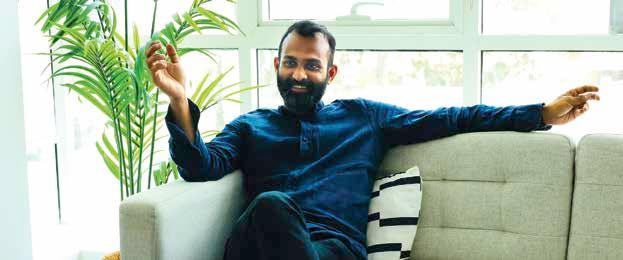
Walk into any modern CX workshop and you’ll see talk of “customer journey orchestration” and “predictive experience modeling.” Fancy concepts, but have you noticed how many brands still have extremely difficult journeys to checkout pages, robotic email responses, long phone queues, or FAQs that read like legal disclaimers?
The contradiction is glaring: brands sink millions into software but ignore the basics of being pleasant, honest, and easy to deal with. That’s because marketers are taught to believe that more technology equals better CX. But common sense says otherwise. If your online store forces me to create an account before checkout, no amount of AI-driven personalization on your homepage will make me like you.
The truth is, customers often prefer a simple, frictionless, human-centred process over an elaborately engineered one. That’s not a headline grabber in a marketing conference keynote, but it works.
A shocking number of CX strategies ignore intuition entirely. That inner voice — the one that tells you “if I were the customer, I’d hate this” — is drowned out by slide decks, committee approvals, and vendor promises. Intuition in CX means trusting simple human truths:
• People don’t like waiting unnecessarily.
• They appreciate being told the truth early, even if it’s not what they want to hear.
• They’d rather deal with a competent, kind human than an overzealous chatbot.
These sound obvious, but look around — how many brands actually live by them? If you want an intuitive CX approach, you don’t always need another analytics upgrade. You need to pick up the phone, go through your own purchase process, and feel what your customer feels.
Marketers love the phrase “surprise and delight.” The problem is that they often implement it like a party trick rather than a principle. Giving a coffee voucher after a service meltdown means nothing if your core process is still broken.
An intuitive CX philosophy starts with not frustrating people in the first place. Think about airlines: handing out free snacks during a four-hour delay doesn’t erase the frustration. What people value more is a clear explanation, timely updates, and the feeling that someone is actively working to fix the issue.
Surprise and delight should be the cherry on top of a fundamentally sound experience — not a gimmick to patch up poor operations.
Today, many brands twist metrics like NPS (Net Promoter Score) to claim customer love. But chasing a number and chasing loyalty are not the same thing. Some brands even game the system by asking customers for “a perfect 10” — an approach that feels manipulative rather than meaningful.
An intuitive marketer knows that a five-minute conversation with a frustrated customer provides more insight than a thousand survey responses. Empathy is harder to automate, but it’s a more reliable compass than dashboards alone.
Here’s the contrarian truth: you don’t always need cutting-edge customer experience tools to deliver exceptional marketing results. The brands that stand out are usually the ones that:
• Refuse to overcomplicate the basics.
• Trust their own instincts about what feels right to a customer.
• Make decisions that pass the “would I want this?” test.
Yes, collect data. Yes, measure outcomes. But use them to sharpen your intuition, not replace it. Data without empathy becomes bureaucracy. Intuition without discipline becomes chaos. The sweet spot is where metrics validate — not dictate — your understanding of human needs.
If you’ve come this far, then I am sure you’ve noticed that there isn’t a single metric or data point to validate anything that has been said so far and yet there is some truth to what is said.
So listen to it and start coding Intuitive Experiences.
By Suraj Sadeesh Director | Strategic Growth , C2 Comms
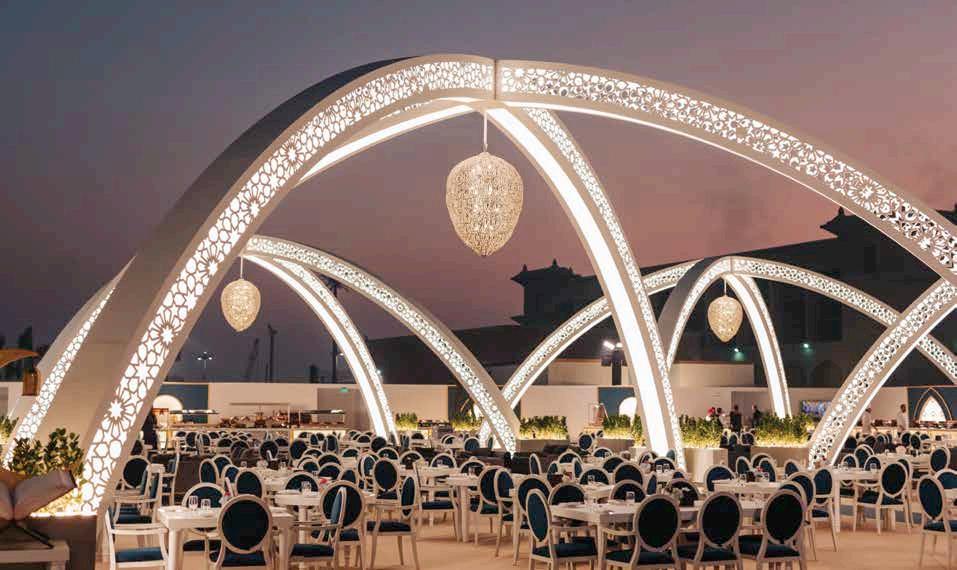
Ramadan resets the rhythm of life across the Gulf region with reverence, and with it the cadence of marketing. In a month when mealtimes move, nights lengthen, families gather, and all that is sacred comes to the fore, brands find themselves playing to a different tempo. The beloved Holy Month of Ramadan in the region can be both a quieting of the commercial drumbeat and a moment of intense orchestration. The contrasts are instructive – and constructive.
In some parts of the region, the month is observed in a way that dovetails fasting and food with family time, moments and memories with meaning – with subdued brand-building and muted marketing. In the more metropolitan cities, the imperative is to keep the atmosphere buzzing, while guiding locals, residents and visitors alike through significant customs and unforgettable experiences –with tact.
Focusing on business outcomes, in the fast-moving consumer goods (FMCG) and retail landscape, Ramadan can make or break the year – depending on whether it’s done right; for hospitality, it’s a chance to coalesce culture and core values with convenience and commerce; for remarkable destinations such as Diriyah, it’s about being present for the community at all hours – often, quite literally. Meanwhile, media behaviour shifts in tandem with the change in active and meal-time hours within the region. Latenight linear TV and connected TV (CTV)
Marketers from Saudi Arabia and the UAE discuss cultural, commercial and community-first strategies for Ramadan at a round table by The Marketing Society in partnership with The Trade Desk and Campaign Middle East.
By Anup Oommen
viewership peaks; use of mobile phones and tablets surges after dark; and time spent in front of laptops and desktops, and time spent behind the wheel drop considerably during the daytime. Advertisers and performance marketers are required to recalibrate accordingly in real time.
Cultural fluency and commercial clarity becomes the need of the hour – driven by deep, data-led insights into individual behavioural patterns, beliefs and intent. It’s no surprise that marketers are now turning to their tools, technologies and trusted instruments – creative, channel mix, operations and measurement – to propel profitability and connect more closely with cohorts of hyperlocal communities within the region.
To discuss all this and more, The Marketing Society in partnership with The Trade Desk and Campaign Middle East, brought together a group of marketers for an in-depth conversation, including:
Kiran Haslam, Group Chief Marketing Officer, Diriyah Company
Sheila Chaiban, Chief Marketing Officer, Majid Al Futtaim Retail
Özge Onur Aboughali, Senior Director Marketing MENA, Lipton Teas and Infusions
Hanan Eissa, Vice President – Marketing and Public Relations, Atlantis, and Terry Kane, Managing Director MEA, The Trade Desk
Moderated by Alasdair Hall-Jones, Global Director, The Marketing Society
RIYADH’S ‘MODEST MAGNIFICENCE’; DUBAI’S ‘BALANCED BEAUTY’
The conversation begins with how a brand’s tone during Ramadan needs to strategically resonate with how the Holy Month is observed in each specific part of the Middle East region.
Noting the mindset that frames both strategy and execution in Riyadh, Kiran Haslam, Group CMO, Diriyah Company, says, “Saudi Arabia is a place where the ritual of Ramadan is still highly respected. There’s a slight step away from the commerciality of it all. Ramadan really becomes a moment that feels very authentic, very meaningful and personal – and it’s very different to every other GCC country I’ve been in or worked in.”
He adds, “We have a very interesting approach with Diriyah, where we represent ourselves to the world through what we call, modest magnificence, and that sits really nicely with how Ramadan is celebrated.”
In Dubai, the Atlantis hotel brand keeps the lights bright while staying true to the spirit of the Holy Month.
Hanan Eissa, VP – Marketing and Public Relations, Atlantis, describes how the hospitality icon leans into occasion and education, while maintaining ‘business as usual’,
“Ramadan is a very important month for us. On one hand, we have our ‘Asateer’ Ramadan tents for Iftar and Suhoor at Atlantis The Palm every year, which has become an institution. We accommodate approximately 2,000 people a night for Iftar and Suhoor combined,” Eissa says. “On the other side, we also have to showcase that the hotel is carrying on with business as usual.”
She adds, “This means, while we’re always very respectful of the Holy Month of Ramadan, and while we’re educating guests and guiding them through the customs and associated traditions – such as dressing a little more conservatively – we also highlight that in Dubai, it’s business as usual. Guests can go to the pool or the beach, can order food at the F&B options, and don’t feel a huge difference in their hospitality experience despite being mindful and respectful of the occasion.”
RAMADAN: SETTING THE TONE FOR SUCCESS
If hospitality curates experiences, the retail and FMCG landscape fine-tunes the omnichannel journey and the supply chain to enable seamless moments during an extremely intense sales window.
explains. “The frequency with which customers come to our stores is very high. That means we need to understand that we’re not just selling food and products; we’re enabling these crucial moments for families, which is specifically true during Ramadan, when mealtimes gain deeper meaning.
So, that’s our ethos: We always lean into the values of Ramadan and the DNA of the brand – and bring them together –becoming a trusted companion for families, enabling their most meaningful moments.”
Turning to the beverage aisle, Özge Onur Aboughali, Senior Director Marketing MENA, Lipton Teas and Infusions, explains why Ramadan sets the tone for the whole year.
“Ramadan really is the heartbeat of the year for FMCG,” Aboughali says. “Roughly one-fifth of annual FMCG sales are generated in this single month – and for core Ramadan categories like tea, that share is even higher. We treat Ramadan not as a campaign window, but as a business season that defines the entire year.”
Aboughali adds, “That’s why our planning starts six to eight months in advance, aligning product availability, campaign development, media precision, and retailer activation to deliver both cultural relevance and commercial impact. Where we are right now, we already know exactly what we’re going to do for the upcoming Ramadan in extreme detail –because that will set the tone for how the entire year ahead is going to pan out.”
She also underlines how cultural relevance and sharp category execution come together during the Holy Month of Ramadan.

Sheila Chaiban, CMO, Majid Al Futtaim Retail (MAF Retail), is quite direct about the stakes.
She says, “Ramadan is the most important period of the year for our business, it can make or break the year. In fact, it’s not one period but three, requiring focus across the business before, during and after Ramadan.”
“As a grocery retailer, we are naturally embedded into family life and the period is just as important emotionally,” Chaiban

Aboughali adds, “Beyond its commercial importance, Ramadan is when tea becomes emotionally and culturally inseparable from daily rituals – from Iftar gatherings to latenight Suhoor moments. Tea extends social connection; it’s what keeps the gathering going. We’ve built our entire Ramadan platform around these shared moments, positioning Lipton as the companion that carries people from Iftar through Suhoor.”
“Ramadan naturally brings a surge of shoppers to the aisle,” she continues. “When executed well, it can become truly transformative – turning that traffic into new buyers. Our collaboration with a key retailer during the Holy Month, for instance, helped Lipton recruit more than 45 per cent new shoppers, proving the power of getting both relevance and execution right.”
THE MEDIA RESET DURING RAMADAN
Leaders also converse about how media, viewership and attention patterns change during the Holy Month, demanding different buys and different measurement.




Terry Kane, Managing Director MEA, The Trade Desk, zooms out to describe what the adtech platform sees at scale during Ramadan.
“We don’t own any inventory. We act as the tech that sits between publishers and buyers of media, and help advertisers directly or indirectly gain access to those publishers. So, we get trillions of data points, especially in terms of bid requests – or opportunities to buy media every day – which amount to millions per second.” Kane explains.
He adds, “What we’re seeing, particularly during Ramadan, is this massively high attention opportunity. During a period when media habits change, how time is spent changes, where attention is channelled changes, and habits change. The way media is bought and sold ultimately changes as well.”
Retailers have already shifted their mix to reflect these Ramadan realities.
Explaining the pivot in terms of how the MAF Retail team plans and buys, Chaiban says, “During Ramadan, we move a lot of our spend towards digital channels, and away from the traditional out-of-home that we used to do historically. Digital has moved us from one size fits all to hyper-targeted, in the moment engagement, allowing us to scale hundreds of micro-segments, serving tailored creatives that resonate with different family needs, without inflating cost. When we started this shift in 2023, we noticed an immediate effect – we doubled our return on investment (ROI) just by a simple medium exchange.”
Additionally, new media formats, brand experiences and good old inperson customer service all feature in the marketers’ Ramadan playbook.
Aboughali says, “We’ve seen real returns from investing in connected TV – especially by being selective about which Ramadan shows we appear around. Gaming is also becoming an exciting new space, as nights stretch into Suhoor and Gen Z stays online and engaged. These are the moments where new rituals form, and where brands like ours can connect in more contemporary ways.”
Kane agrees on this arc, saying, “Connected TV can be individualised and personalised a lot more compared with traditional 30-second ad slots. In my view, the only future for television, which is going through a renaissance period of its own, is CTV and programmatic television.”
Leaning more into platforms, Eissa explains, “We do a lot on digital and social channels, which resonates really well with our audiences during Ramadan. As Ramadan slowly moves away from the summer months into the cooler periods, we’re seeing a lot more people spending time outside – and, as such, interacting a lot more on interactive and immersive platforms”.
On the omnichannel front, Chaiban talks about blending in-store moments with tailored digital journeys while keeping the focus on families during the Holy Month of Ramadan.
“IT’S ABOUT SPEAKING THE LANGUAGE OF THE REGION, UNDERSTANDING LOCAL RITUALS, AND SHOWING UP IN WAYS THAT FEEL AUTHENTIC.”
you earn both cultural credibility and commercial impact.”
Chaiban adds, “Ramadan is such a sacred period, and I think we all have to understand and accept that. Tone and timing are everything, from the imagery we use, to the pace of media spend, to how we show empathy around fasting hours. It all starts with building respect for the occasion before we execute anything –whether it’s a promo message, or whether it’s a more engaging piece of social content.
She says, “This year, we are innovating around empowering children to build healthier food habits, and involving children in the rituals of Ramadan is a perfect way to do that. For instance, getting them to cook certain meals, to try and help with the preparation, and getting them more involved at a younger age. As such, we’re looking at how that drives the digital innovation journey alongside the physical retail experience for families.”
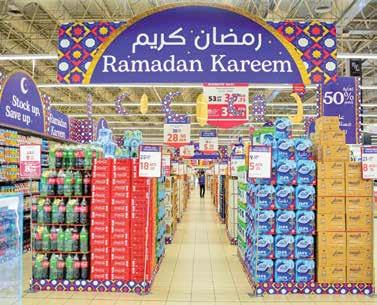
Above all, on-the-ground agility remains critical. Haslam sums it up saying, “We have to totally reinvent the way we engage with our customers, our partners, and internal and external stakeholders.” He explains that this goes beyond a cultural and commercial context – to embrace the realities of life, including changing working hours to align with people being more active during the night than during the day.
FINDING THE COMMERCIAL-CULTURAL BALANCE
Laying out a simple rule for global brands operating locally, Aboughali explains how commercial and cultural objectives are inseparable during Ramadan. She says, “Global brands can’t just adapt existing work – they need to truly connect. It’s about speaking the language of the region, understanding local rituals, and showing up in ways that feel authentic to people’s daily lives. When you get that balance right,
She explains, “The sweet spot is where our brand promise meets cultural values, like ensuring fresh ingredients are delivered daily to bring families together, or having affordable bundles that can support households hosting larger gatherings. Authenticity is crucial, we don’t try to be something we’re not. We focus on enabling Ramadan traditions in ways that are practical, emotional, and real.”
For Diriyah, the pulse of the Holy Month drives operations as much as marketing. Haslam outlines the scale and the on-call mentality required.
“To put it into context, across our 64$bn master plan – we are building a city from a blank canvas – and the stage that we are in right now is that we’ve got some components which are operational: We’ve got a collection of luxury hotels; we’ve got two dining districts; we’ve got some parklands and public realm experiences; and we’ve got a UNESCO World Heritage Site – all of which are fully operational right now,” Haslam says.
He explains, “The reality is that every day of the week, we are on the customer’s watch for our efforts to bring life into the masterplan. Specifically when it comes to our real estate sales and commercial property tenancy. We have to proactively anticipate customer needs and we have to react to them. So, if during Ramadan they wish to have a conversation at 2am, or they want to visit the site, we need to be available operationally at all times.”
Additionally, Diriyah also views Ramadan through a civic lens, investing considerably in corporate social responsibility in the form of food drives and other such initiatives. As such, Ramadan goes far beyond cultural messaging to become a part of lived experiences and practised values at Diriyah.
All in all, across different sectors and categories, the same themes resurface: plan early, listen carefully, tailor by moment and market, and be present in ways that matter. This could mean different things in different contexts – whether it’s an authentic traditional experience in a Ramadan tent; or helping a family seamlessly get dinner on the table after a day of fasting; or being available to help a guest in-person at 3am. Leaders conclude that marketers need to prepare for Ramadan with precision, purpose, and presence – leaning into data to sharpen the brief, creativity to win hearts, and empathy to connect with people on what matters most to them.























For two extraordinary days in October 2025, JAX District in Riyadh, Saudi Arabia became the beating heart of the region’s creative economy as it hosted the third edition of Athar – Saudi Festival of Creativity, which transformed the capital into a living showcase of ideas, innovation and cultural confidence. The vibrant festival welcomed more than 3,000 attendees and 250 speakers. The programme stretched past 100 hours of content across five content stages, making this the biggest and boldest edition of Athar to date.
The scale alone was striking. Exhibitors and international delegations, including those from Russia, France, Germany and the UK, joined marketers, agency leaders, creators and technology experts from around the world. They exchanged insights on everything from film and gaming to luxury, AI and cultural storytelling, reflecting how broad the creative canvas of Saudi Arabia has become. Conversations were louder,
collaborations more diverse and the atmosphere unmistakably confident.
Athar Festival 2025’s speaker line-up was representative of that growing global pull. The rooms were packed for sessions led by Ahmed Helmy, one of the Arab world’s most beloved actors and comedians, who explored the craft of humour and connection; Jo Malone, CBE, world-renowned perfumer and Founder and Creative Director of Jo Loves, who spoke of resilience, intuition and the power of staying authentic in business; Ellie Norman, Chief Marketing Officer of Formula E, who examined how creativity, technology and purpose can build a sport from scratch and inspire a new generation of fans; and Mo Gawdat, bestselling author and former Chief Business Officer at Google X, who offered a human-centred take on artificial intelligence and its creative implications.
Visionary voices such as Kiran Haslam, CMO of Diriyah Company; Mohammad Aljuhani, Senior Manager, Marketing and Communications, Expo
2030 Riyadh; Steve Plimsoll, Chief Strategy Officer and Acting CMO, HUMAIN; Ahmed Almashhadi, Director of Brand and Marketing at CEER; Jason Foo, CEO of BBD Perfect Storm; and Nedaa Almubarak, CEO of SRMG Media Solutions also added depth to the high-impact roster.
Beyond the stages, the festival floor buzzed with important exchanges, from live demonstrations and creative showcases to the signing of memorandums of understanding. Each conversation, collaboration and connection added to the sense that something larger was taking shape, stretching from the region to what lay beyond: a creative ecosystem fully aware of its global potential.
This year, Riyadh didn’t just host a festival, it announced a statement of intent: “Saudi creativity has firmly cemented its footprint in the region and is ready to evolve beyond its borders.”

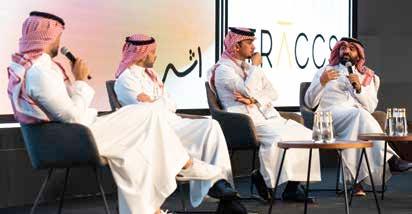

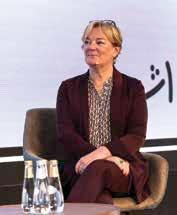






THE 2025 EDITION OF ATHAR FESTIVAL IN NUMBERS:
9,000 square metres
3,000+ attendees
250+ speakers
100+ hours of content
80+ activations
8 masterclasses
5 stages

Leadership is learned, but great leadership is cultivated. That was the defining idea behind the Omnicom Future CMO Academy, which returned to Athar Festival for its second year. Designed as a one-day accelerator for highpotential marketers, the academy brought together 23 standout professionals from across leading Saudi organisations, including NEOM, Red Sea Global, Saudi Tourism Authority, Nestlé and ROSHN Group.
Held on the opening day of the festival, the academy ran under the theme ‘CreAItivity Toolbox’, blending the timeless principles of marketing leadership with the disruptive edge of technology. Participants explored four cornerstones of this year’s programme, including strategic foresight, crisis confidence, creative and AI fluency, and how to extract the best work out of agencies while also focusing on peer networking. The programme included a tightly curated series of talks, panel sessions and collaborative workshops.
Across the day, a roster of distinguished speakers, including brand-side marketers and agency leaders, shared their insights. Nourah Alkhunaini, Head of Brand Strategy and Management at Ithra; Nabil Sleiman, Head of Marketing Communications at Almarai; Cem Topcuoglu, President – Central and Eastern Europe (CEE) and the Americas (AME) at Omnicom Advertising Group; Daniel Shepherd,
Group Chief Strategy Officer of Omnicom Media Group MENA; and Yasser A Almisfer, Vice President of Corporate Communication at Olayan Financing Company, as well as other senior leaders revealed fascinating insights on marketing leadership and transformation.
Industry leaders from Omnicom Group reinforced the academy’s emphasis on collaboration and human insight as the true engines of innovation.
“When our industry evolves this fast, the best thing we can do is evolve together,” said Dani Richa, Chairman of BBDO EMEA and CEO of Impact BBDO. Elda Choucair, CEO of Omnicom Media Group MENA, echoed the sentiment, emphasising that “learning how to think creatively alongside technology is what will separate good marketers from great ones”. Reda Raad, Group CEO of TBWA\RAAD, highlighted that “this is about unleashing the disruptive potential of a region that’s ready to embrace bold and authentic ideas, empowering young talent to stay curious and think differently”.
What set this year’s edition apart was its atmosphere – less like a classroom and more like a round table of equals. By the end of the day, participants benefitted not only from listening to new frameworks and perspectives, but also from building a new network of peers, who will likely shape the next chapter of Saudi Arabia’s creative economy.



Over the past year, the Maheerah Network, powered by Publicis Groupe Middle East, has continued to expand opportunities for women across Saudi Arabia’s marketing and communications sector. Established to strengthen female representation in senior roles, it provides women professionals with opportunities to collaborate, learn from top industry leaders and build lasting industry connections.
These ongoing initiatives culminated in the Maheerah Programme, a two-and-a-half-day experience held at Athar Festival 2025. The programme was led by Lucy Harvey, Chief Growth
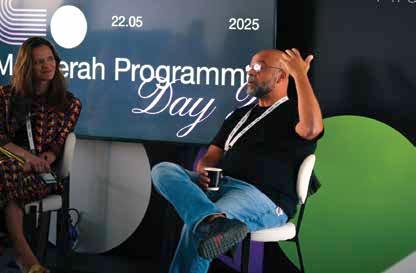
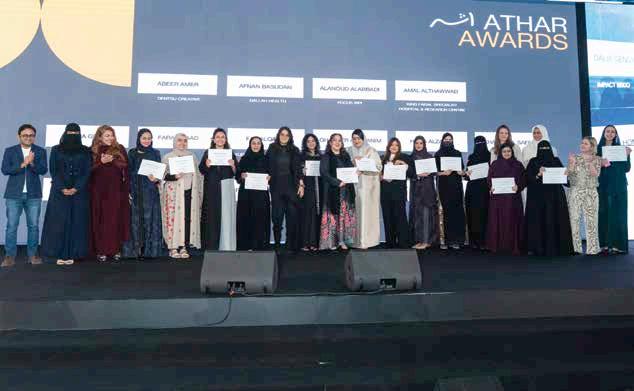
Officer for the Middle East, Turkey and Africa at Burson; Marie-Claire Maalouf, Chief Creative Officer for EMEA at Edelman; and Nada Hakeem, CEO and Co-Founder of Wetheloft. The programme selected 16 participants from among almost 100 applications from some of the region’s most influential creative and corporate organisations. It served as a focal point for the network’s year-long engagement and learning.
Participants delved into workshops and peer-learning sessions focused on creativity, confidence, leadership, purpose and personal branding. They explored practical ways to strengthen their professional impact within the creative economy, guided by accomplished creative marcomms figures such as Mo Gawdat, bestselling author and former Chief Business Officer at Google X; Ali Rez, Chief Creative Officer at Impact BBDO; Noha Bashir, training architect, stand-up comedian, and Founder of The Human Playground; Ahmed ‘Fizo’ Younis, Chief Creative Officer at Publicis Communications KSA; and Ellie Norman, Chief Marketing Officer of Formula E.
Maheerah mentors and coaches included industry leaders such as Ahmad Konash, Co-Founder and CEO of Onsor Mosha; Ghassan Kassabji, CEO of Impact BBDO; Joelle Haddad, Managing Partner, Strategy and Creative at Freedom; Mouaz Al Hamami, Founder and CEO of Media Turtles (Whizz Film); Sara Eid, Regional Creative Director at Serviceplan Group Middle East; and Theresa Tran, Founder of The Offense, among others.
The Maheerah Network, launched in May 2025, has already grown into a vibrant community of more than 300 professionals, including 42 programme alumni who continue to collaborate, mentor and exchange ideas beyond the festival. Through regular discussions and collaborative workshops, it supports professional growth while fostering dialogue on women’s advancement across creative disciplines and shaping a more inclusive, forward-looking industry.

If the main stages at Athar Festival were where bold ideas took flight, the masterclasses were where they found their footing. Across eight sessions led by global agencies, industry leaders and academic institutions, participants explored the mechanics of creativity, examining how insight, innovation and technology are reshaping the craft of communication. Held in an intimate setting that encouraged direct interaction, each session allowed participants to engage closely with experts and deep-dive into the subject matter, combining focused learning with the festival’s atmosphere of curiosity and collaboration.
‘TURNING CULTURE INTO BUSINESS’ BY PRINCE MOHAMMAD BIN SALMAN COLLEGE (MBSC)
The day began with a conversation that felt quintessentially Saudi. Hosted by Prince Mohammad Bin Salman College (MBSC), this
masterclass unpacked how culture can be converted into sustainable business value.
Drawing on case studies developed in collaboration with the Ministry of Culture, the session examined how homegrown creative ventures are redefining what it means to build a business rooted in identity. It offered a strategic look at how cultural heritage can fuel entrepreneurship and how Saudi Arabia is turning passion for its traditions into powerful, future-facing enterprises.
‘CREATIVITY IN MOTION’ BY SNAP
When it comes to innovation at speed, few platforms move as quickly as Snapchat. In this lively and interactive session, Yara AlHamdan revealed how augmented reality (AR) has transformed the storytelling landscape, particularly for Saudi brands seeking to engage a digital-native generation. Featuring examples such as Riyadh Fashion Week TASAWAR and Snap AR Ramadan Mall, the masterclass demonstrated how AR activations and collaborations through its Collab Studio help brands turn cultural moments into immersive campaigns. Participants left with an understanding of how technology, creativity and cultural insight can merge to create campaigns that don’t just entertain but resonate.
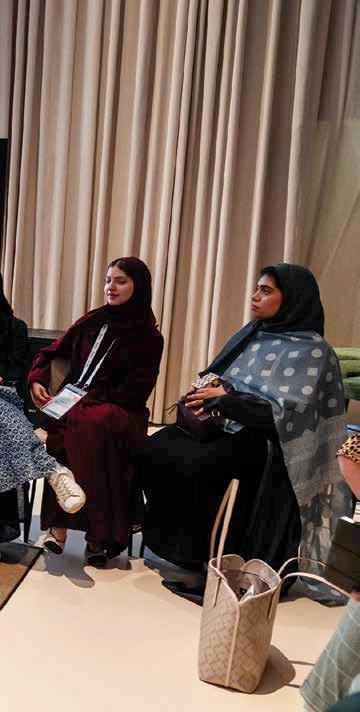
Every marketer knows attention is the new currency, but few understand the science behind it. This session, led by Ahmed Bakir from UBT, ventured into the psychology and neuroscience of why some ads stick while others fade. Through real-world case studies, participants explored how emotion, rhythm and sensory cues shape memory and engagement. The session’s practical takeaways, including techniques to optimise visual and auditory storytelling, proved valuable to those seeking to create messages that linger long after the screen goes dark.
This session stripped away the slides and buzzwords to reveal something simpler: the human side of marketing leadership. Four senior industry figures took to the stage, sharing what each of them believed is the single most important trait of modern marketing leaders: From empathy and agility to curiosity and courage. Following brief storytelling-style talks, participants broke into smaller groups for informal discussions, turning the room into a candid exchange of lessons learned on both success and failure. It was less of a lecture and more of a mentorship moment – one that embodied the collaborative ethos of the festival.
In a world that often rewards noise over nuance, senior leaders led participants through a personal branding journey built on authenticity and purpose. Through guided exercises, attendees reflected on what drives them, how to communicate it clearly and how to align that with their professional presence. By the end, the takeaway was clear: Personal branding isn’t about selling yourself; it’s about articulating the difference you make. For emerging leaders seeking to define their voice in a crowded market, this was one of the festival’s most introspective sessions.

ACROSS EIGHT SESSIONS, PARTICIPANTS ENGAGED CLOSELY WITH EXPERTS, COMBINING FOCUSED LEARNING WITH THE FESTIVAL’S ATMOSPHERE OF CURIOSITY AND COLLABORATION.
‘SAUDI’S
If Saudi Arabia is rewriting its story, this session was its editorial board. Hosted by PRCA MENA, six experts explored how communication is shaping the Kingdom’s evolving image under Vision 2030. Through discussions on balancing heritage with modernity, navigating perceptions and amplifying cultural confidence, the masterclass highlighted how brands, agencies and government entities are collaborating to craft a national narrative that feels both authentically Saudi and globally relevant. For communicators in the audience, it was a rare opportunity to peek behind the curtain of Saudi Arabia’s transformation in motion.
‘CREATIVITY
Backed by insights from Cannes Lions, WARC, Contagious and Effie, this session challenged the myth that creativity is unpredictable. LIONS Advisory introduced its proprietary Growth System, designed to help marketers embed creative effectiveness into business strategy. Case studies from award-winning global campaigns showed how creative success can be both inspired and systematic. It was a session that left the audience nodding in recognition, proof that great work isn’t luck; it is leadership, structure and a relentless commitment to excellence.
‘SUPERCHARGE YOUR CAMPAIGNS WITH AI’ BY FOUR AGENCY
Closing the masterclass lineup was a forwardlooking session by Four Agency Worldwide, which offered a hands-on exploration of how AI can be responsibly and practically deployed in marketing. Participants learned how synthetic focus groups, generative engine optimisation (GEO) and AIdriven message delivery can supercharge campaign effectiveness. The takeaway wasn’t about replacing human creativity but empowering it. Participants walked away with actionable tools and access to an English and Arabic AI marketing companion to continue their learning journey.
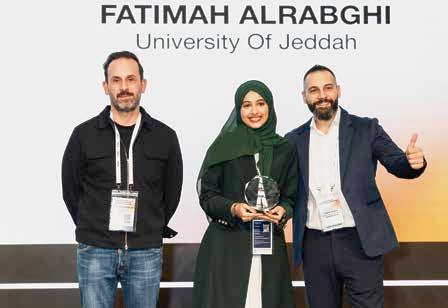


While the main stages at Athar Festival celebrated established voices, the competitions spotlighted those still defining theirs, including students, young creators and early-career professionals shaping the Kingdom’s creative future. This year’s expanded slate of competitions brought a real-world edge to learning, giving participants the chance to test ideas under pressure and showcase how bold thinking translates into tangible impact.
‘PLAY THE MOMENT’ BY DENTSU SPORTS & ENTERTAINMENT
Among the most talked-about initiatives was Play the Moment, powered by Dentsu Sports & Entertainment. It challenged young creatives from across the MENA region to design disruptive, fandom-driven campaigns for Hungerstation, a food and grocery delivery platform in Saudi Arabia. Over several fast-paced rounds, participants crafted concepts that merged creativity with cultural relevance, pitching their ideas live on stage in front of industry judges. Fatimah Alrabghi from the University of Jeddah emerged as the winner. She impressed the jury with her original approach and cultural insight, winning a coveted prize – a trip for two to a top-tier European football match. Young creatives
found the experience to be a rare bridge between classroom creativity and commercial reality.
‘NAWA – SAUDI ADVERTISING STUDENT COMPETITION’ BY SIFR
For university students, the Nawa Competition, powered by Sifr, offered an opportunity to showcase applied creativity. Teams of two tackled a live brief from the Diriyah Gate Development Authority (DGDA). Haya Abdulaziz Alsiyari and Maha Muhammad Alrasheed from King Saud University won the competition for their fresh perspective and clarity in their strategies. Beyond the thrill of competition, the prize carried real career weight, offering the winning team and shortlisted finalists internships at Sifr, which will provide them with a pathway into the professional world of advertising.
‘BREAK THE MYTH. PROMPT THE FUTURE’ BY HUMAIN, LUMA AI & PUBLICIS GROUPE MIDDLE EAST & TURKEY
Perhaps the most forward-looking of the three, this competition invited participants on ground at the festival to harness artificial intelligence (AI) tools to rewrite outdated narratives about Arab youth. Using smart prompts and generative technology, contestants produced short
YEAR, ATHAR OFFERED A REAL-WORLD EDGE TO LEARNING, GIVING PARTICIPANTS THE CHANCE TO TEST IDEAS UNDER PRESSURE.
AI-generated videos that flipped cultural clichés into stories of empowerment and modern identity. Abdullah Maraqa created the winning video, proving that AI, when wielded creatively, can amplify authenticity rather than dilute it.
Together, these competitions encapsulated the spirit of Athar Festival 2025: collaborative, curious and unafraid to experiment. By combining creativity with purpose, they turned imagination into opportunity and, for many young competitors, marked their first step into what promises to be long and exciting creative careers.
Now in its third consecutive year, the Young Talent Academies initiative returned as part of Athar Festival, offering a platform for students and aspiring creatives aged 30 and younger to develop practical skills, gain industry insight and build professional connections. This year’s edition welcomed 63 participants across three tailored tracks designed for students and early-career professionals. Each track provided an immersive learning experience guided by leading figures from Saudi Arabia’s marketing and communications community.
The three academies, MCN’s BIG Student Academy, WPP’s Ta’atheer Student Academy, sponsored by VML and Burson, and the NextGen Academy, held in partnership with the Saudi Tourism Authority (STA), combined interactive workshops with real-world challenges that encouraged participants to apply creativity, teamwork and strategic thinking. Over two intensive days, attendees explored everything from advertising fundamentals and campaign development to cultural relevance, storytelling and brand communication. Each academy was structured

to help participants translate ideas into actionable solutions, brought to life in a 24-hour hack competition, which culminated in a presentation to industry leaders.
The MCN BIG Student Academy introduced participants to the creative process behind advertising campaigns. The WPP Ta’atheer Student Academy focused on how culture and consumer behaviour shape modern marketing. The NextGen Academy, in partnership with STA, examined how collaboration between brands and agencies is evolving. It also explored the use of artificial intelligence (AI) and data-driven creativity in

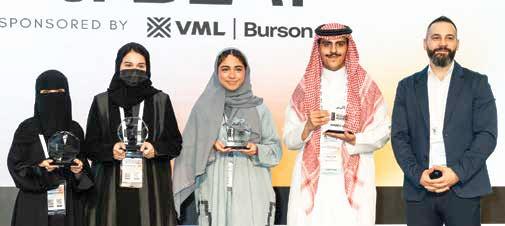
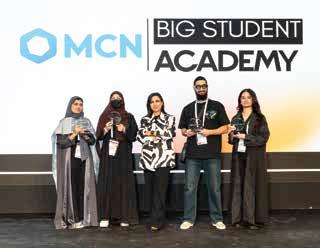
Saudi storytelling. The three tracks created a comprehensive environment for learning, experimentation and discovery. The winning teams from each academy were celebrated on stage during Athar Festival’s closing ceremony, recognising their originality, collaboration and problem-solving skills in front of the region’s marketing community.
The winning team from MCN’s BIG Student Academy, Team Orange, comprised of: Hafsah Mahmood, Aston University; Ghala Alghanmi and Abdulrahman Hemaid, University of Business and Technology; and Ghadah Al-Khalawi, International Technical Colleges.
From WPP’s Ta’atheer Student Academy, the winning Team Blue included: Ruba Alzurier, Imam Muhammad Ibn Saud Islamic University; Omnia Alharbi, Saudi Electronic University; Lenah Alnamlah, Princess Nourah Bint Abdul Rahman University; Khalid Own, Taif University; and Sedra Attar, University of Business and Technology.
Winners of the NextGen Academy, Team Green featured: Ghala Alghamdi, Public Investment Fund; Najla Abdullatif Ali, TBWA\RAAD; Samar Alkhamis, Saudi Electricity Company; Abdrahman Abdulrahim Bamashmous, Mohammed Yousef Naghi Motors; and Maryam Althobaiti, HungerStation.
By bridging the gap between education and industry, the Young Talent Academies continue to reinforce Athar’s role in developing emerging talent within Saudi Arabia’s creative economy.
Bill Watkins, Chief Revenue Officer of Pinterest, speaks to Campaign Middle East at Athar Festival about the platform’s unique approach to visual discovery, consumer confidence and ‘full-funnel coverage’.
By Anup Oommen
In an era when online shopping often feels like navigating a labyrinth, Pinterest is pioneering a new approach to social commerce.
The platform is perfecting its formula to boost consumer confidence, streamline discovery, spur inspiration, resonate with customer lifestyles, understand curation behaviour and spot trends rather than merely offering convenience and easing checkout processes.
In conversation with Campaign Middle East, Bill Watkins, Chief Revenue Officer (CRO), Pinterest, sheds light on how the platform is addressing concerns around cart abandonment, conversion lift, the sea of sameness and inventory management, while balancing near-term performance with long-term brand building.
‘SOLVE FOR CONFIDENCE RATHER THAN CONVENIENCE’
Kicking off the conversation, Watkins discusses why the time has come to rethink the customer journey with a specific focus on consumer confidence. He argues that the real challenge is not about removing obstacles but rather about empowering decision-making. Watkins explains, “Shoppers are not abandoning carts because of checkout friction; they’re abandoning because they just are not ready to decide. People are suffering from what we call ‘FOBO’ – the fear of better options. In a world of infinite choice, consumers worry there’s something better out there if they keep looking.”
He adds, “The solution is not removing more barriers; it’s curation. We need to help shoppers narrow down options and build a clear picture of what they want.”
Recent research released by The Decision Lab corroborates this notion, with 75 per cent of shoppers surveyed stating that narrowing choices led to more confident decisions.
The shift in focus from checkout experiences to curation aims to alleviate decision paralysis and promote consumer confidence and certainty. Pinterest has
proven this works through its Boards feature, where people curate collections of ideas they’re considering – like a visual shopping cart that builds over time.
Watkins says, “Products saved to Boards are twice as likely to be purchased because people have had time to feel confident about their choice through curation. Instead of throwing endless options at customers, Pinterest has become an AI-powered shopping assistant. Through visual search, personalised recommendations and smart curation, people can better understand what they love. When you solve for confidence rather than just convenience, you solve the real problem behind abandoned carts.”
However, the Pinterest CRO also acknowledges the risks associated with over-curation, which creates filter bubbles, and discusses the power of relevant and evolved artificial intelligence (AI) tools to bypass algorithmic echo chambers.
Watkins says, “Our AI doesn’t just show people more of the same. It’s designed to actively expand taste. As more users engage more with personalised recommendations, AI gets smarter, which leads to better shopping. Think personalised recommendations for users and performance wins for advertisers.”
Pinterest’s AI guides users through the vast landscape of visual ideas, tailoring inspiration to their unique tastes. For instance, its Taste Graph, which uses more than 500 billion Pins to predict user desires, has grown 75 per cent over the past two years and serves as the foundation for its personalisation. This helps the platform understand not just what someone likes, but how their preferences evolve over time.
“Gen Z especially loves how we just get their aesthetics and vibes, by matching visual inspiration to concrete realisations,” Watkins adds, “That said, we also give people control. With features such as ‘see more or fewer’, users can steer our AI to serve inspiration that answers to them. The goal is not to eliminate choice, but to sequence it in a way that builds confidence rather than being overwhelming –showing sufficient options that people feel they’ve explored thoroughly without giving in to the endless scrolling.”

In a world obsessed with monitoring success metrics, Watkins highlights leading indicators – metrics that matter – which reliably predict conversion lift. “Saves are our strongest predictor,” he states, emphasising that products saved to Pinterest boards hold double the purchasing probability.
Pinterest’s Taste Graph predicts what users actually want to buy – not just what keeps them scrolling – because every save, search and curation action feeds into this system, creating strong predictive signals.
Watkins says, “Critically, we ignore the metrics other platforms obsess over –controversial content that drives negative engagement. The result?
Users tell us ‘Pinterest just gets me’ because we’re learning from their intentional actions, their plans and aspirations, not their unconscious scrolling. That creates genuine conversion lift because we’re predicting real purchase intent, not manufactured addiction.”
“When your AI serves actual human needs instead of engagement at any cost, both user satisfaction and business outcomes
improve. That’s sustainable growth,” he adds. Unlike other platforms, Pinterest consciously chooses to bypass negative engagement metrics, focusing instead on genuine interest and intent.
With the increasing trend of product discovery through visual platforms, the time has come for companies to think strategically about their digital investments.
Recent research released by Adobe reveals that 39 per cent of Gen Z are now starting their searches on Pinterest instead of Google. Watkins says, “We’re seeing a fundamental shift. With visual search becoming the primary discovery method, the upstream investments that will matter the most are understanding and participating in visual intent signals.”
He calls for a focus on four key areas, including getting product catalogues into visual discovery platforms, investing in lifestyle and contextual imagery, understanding curation behaviour, and keeping both eyes peeled for new trends.
Explaining each of these in detail, Watkins says, “This is not just about having products online. It’s about having them discoverable when someone searches with an image instead of words. Products saved to Pinterest boards are twice as likely to be purchased, but that happens when people can visualise how items fit into their actual lives. The brands seeing the biggest return on investment (ROI) are those that are creating diverse visual content that shows products in multiple real-world contexts.”
“When people save your products alongside other items, they’re essentially telling you how they see your brand fitting into their vision. That data is incredibly valuable for product development, positioning and future marketing. Also, the ROI comes from being present when people are forming preferences, not just when they’re ready to buy,” he adds.
Pinterest trends have proven to be more than 80 per cent accurate in predicting what’s next, according to recent reports.
Brands that can tap into these signals –understanding what aesthetics and product categories are emerging months before they peak – have the opportunity to build inventory, develop products and position marketing ahead of demand rather than chasing it.
While users around the world come to Pinterest for the same thing – to discover, find inspiration and shop – the core experience that the platform provides is universal. This manifests culturally through its AI tools.
Watkins says, “Our Taste Graph, which has grown 75 per cent over the past two years, learns from individual user behaviour, not broad assumptions. So whether someone in Dubai is exploring traditional Arabic calligraphy or modern minimalist home design, our AI serves them based on their actual saves and searches, which naturally reflect their cultural context. The scale is incredible. Our AI models generate more than 400 million predictions per second to personalise content. And we’re seeing fascinating regional patterns emerge.”
This is exemplified in Pinterest’s upcoming
2025 Fall Trends Report for Saudi Arabia and the UAE, which shows ‘workplace design’ searches up 1,209 per cent, ‘grunge style’ up 94 per cent and ‘polka dots’ surging 895 per cent.
He adds, “Authenticity comes from the bottom up. We’re amplifying what people in each region genuinely love and want to try. That’s how you scale globally while staying locally relevant.
Collaboration and alignment between merchandising and media teams are also crucial to convert visual discovery into sales.
“The most successful brands create unified workflows where merchandising shoots products with media distribution in mind from the start, considering multiple contexts, diverse lifestyle settings and metadata optimised for visual search,” Watkins says, stressing the importance of cohesive efforts to maximise visual search potential.
“When merchandising sees that lifestyle imagery drives twice as many saves, and media sees that saved products are twice as likely to convert, you get natural alignment,” he adds. “The breakthrough is recognising that your product catalogue is not just inventory management. It’s the foundation of your visual discovery strategy. Brands uploading comprehensive catalogues with rich visual content see significantly better performance because AI can surface products in more relevant moments.”
Clearly, the time has come to stop treating visual discovery as different from commerce. Watkins calls for organisations to build integrated systems where merchandising and media teams optimise for the same outcome: Getting the right product in front of the right person with the right context at the right moment in their decision journey.
GUIDING FINANCE TEAMS BEYOND NEAR-TERM ROAS
Pinterest’s strategies also reveal the benefits of engaging consumers early in their shopping journey.
‘‘WHEN YOU SOLVE FOR CONFIDENCE RATHER THAN JUST CONVENIENCE, YOU SOLVE THE REAL PROBLEM BEHIND ABANDONED CARTS.”
However, trouble arises in the tension between early inspiration and near-term return on ad spend (ROAS) expectations. Inspiring consumers earlier in the journey can lower costs and raise engagement in the long term, but finance teams often want to see near-term ROAS.
To address this concern, Watkins points to test designs, media mix modelling (MMM) adjustments that can credibly move budgets upstream.
“The most credible data point is that when customers see ads across Pinterest’s full funnel, including awareness, consideration and conversion objectives, we see that conversion rates are two times higher compared with single-objective campaigns. For test design, the framework that works is experimenting with multiple objectives while maintaining control groups focused on single objectives. You can measure the incremental lift from full-funnel approaches versus conversion-only spending,” Watkins says.
He adds, “The MMM adjustment that matters is linking upper-funnel brand-building to lower-funnel performance through holistic measurement. Instead of treating awareness spend as a cost centre, you’re measuring how early engagement compounds into higher conversion rates down the line.”
This is a credible argument for finance teams that need to realise that marketers are not looking to sacrifice near-term performance for long-term brand building.
On the contrary, Watkins says that this approach shows “that early-stage engagement actually improves immediate conversion performance. The customers you reach in discovery mode convert at higher rates when they’re ready to purchase because they’ve already built confidence through that multi-touch journey.”
He adds, “You’re also diversifying. You avoid overspending on lower funnel while building a sustainable pipeline of engaged prospects who convert more efficiently. Finance teams get comfortable with upstream investment when they can see that early engagement predicts and improves future performance.”
That said, there’s a danger of reaching a point of diminishing returns if brands over-index on a single funnel stage, Watkins warns.
“Spending heavily on upper-funnel awareness without consideration or conversion touchpoints creates a leaky bucket. People get inspired but have no path to purchase. Conversely, focusing only on lower-funnel conversion means competing for the same ready-to-buy customers as everyone else, driving up costs without building new demand. The sweet spot is achieving ‘funnel coverage’ and reaching customers across awareness, consideration, and conversion stages,” he adds.
As digital landscapes continue to evolve, platforms such as Pinterest continue to be a beacon of innovation and reliability. By prioritising curation and confidence over volume and convenience, Pinterest not only eases the shopping journey but also enriches it across the funnel, inviting consumers to explore a world tailored to their evolving tastes and aspirations – one saved Pin at a time.
Chief Creative Officers (CCOs) from Serviceplan Group, Burson, SRMG Labs and MullenLowe MENA discuss curiosity as the lifeblood of creativity; the evolving role of CCOs; the power of collaboration and diverse creative inputs; and the sense of purpose drawn from the creative profession.
By Anup Oommen
Curiosity, collaboration and culture combined with everything that makes people connect on a human level – including emotion, empathy and empowered teams – were discussed during the ‘CCOs Unplugged: Ask Me Anything’ panel at Athar Festival, which was held at JAX District in the heart of Riyadh, Saudi Arabia on 21 and 22 October 2025.
The panel, moderated by Lucy Harvey, Chief Growth Officer – MENAT, Burson, featured four chief creative officers (CCOs): Alexander Schill, Global Chief Creative Officer, Serviceplan Group; Taj Reid, Global Chief Creative Officer, Burson; Fadi Mroue, Chief Creative Officer; SRMG LABS; and Paul Banham, Chief Creative Officer, MullenLowe MENA
The panellists agreed that human connection is returning as the core currency of the creative industry, even as new technologies recalibrate the pace, scale and reach of creative work. They spoke of the need to listen more than dictate, to design processes as diligently as outcomes, and to anchor creative output in empathy and real-world impact. They also discussed the changing role of a CCO from a solitary creative genius to a leader orchestrating and empowering a chorus of voices. They explained how this shapes a people-first and productive creative economy.
The CCOs insisted that creativity must be led with a human touch rather than just experimenting with the score of possibilities made conceivable by tech advancements. When done right, a human approach can drive commerce as reliably as it can drive culture.
The conversations also doubled up as a practical playbook on how to cultivate, lead and scale creative teams in the age of artificial intelligence.
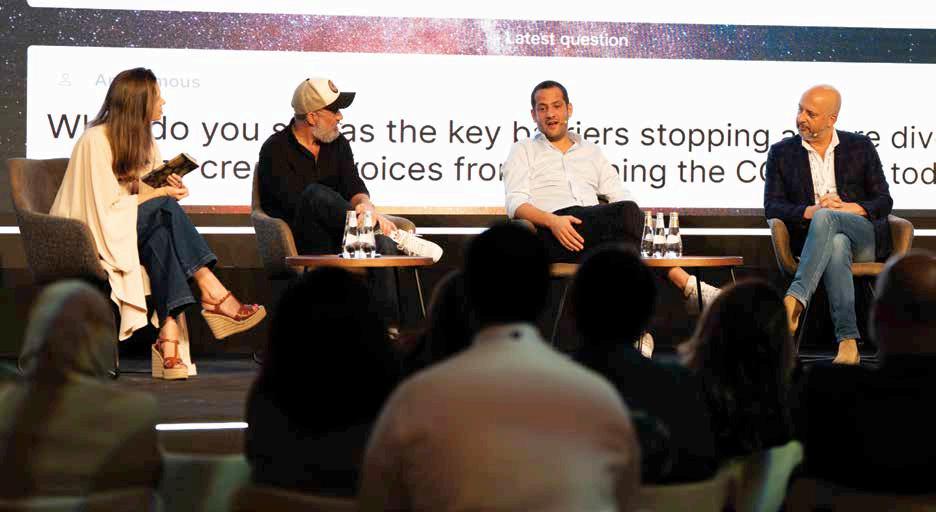
The CCOs argued for ‘uber-creativity’ – a mode of collaboration that invites input from every corner of an organisation – and for a culture where fear gives way to curiosity and feedback. Here’s a look at how the panel played out on the Strategic Stage at Athar Festival.
Creativity is not always a spark that appears out of thin air, but a muscle that is built when it is trained, acted upon and channeled toward meaningful outcomes.
Reid framed this plainly, saying, “Creativity is all about curiosity; I think it’s curiosity in action. It must be used consistently to connect with people in a deep way – and that can be so powerful and important. I am fortunate to work with a great team at Burson that unleashes curiosity in a way that makes brands fall in love with their audiences, and audiences fall in love with brands, and that’s what excites me the most.”
Leaders agreed that curiosity is not merely a must-have attribute for creatives, but also is a must-have vehicle for authentic engagement. It fuels campaigns by recognising, resonating with and reflecting real people.
Schill said, “While the rest of the world is busy discussing artificial intelligence (AI), I want to take a stand for humanity, because I strongly believe that creativity is all about human connections. AI may help us move from doing the work to designing the work, but if we don’t understand what makes humans behave or think in a certain way, we’ll be asking AI the wrong questions and receive the wrong answers.”
He added, “This is why collaboration is critical. At Serviceplan Group, we call that ‘uber-creativity’, which means listening to voices coming from every angle and perspective, from everyone present in the room and from every culture, and across


“As
‘‘CREATE SPACES WHERE THE TEAM FEELS THAT THEY CAN SHARE AND DO ANYTHING … IF YOU DON’T DO THAT, YOU RUN THE RISK OF SOMEONE POSSIBLY NOT SHARING AN IDEA THAT COULD ACTUALLY CHANGE THE WORLD.”
different disciplines. Only if we get together and actually listen to each other will we arrive at a good and solid solution. This, in my perspective, is not only good advice for businesses, but even in life. We have to understand that no single individual can solve all society’s problems, and that’s why we must always fall back on collaboration and human togetherness.”
Reid agreed, reminding the creative audience at Athar Festival to invite feedback and protect spaces for ideas to evolve.
He said, “As a CCO, it is my role to create spaces where the team feels that they can share and do anything – a space where we’ll work on implementing ideas together. If you don’t do that, you run the risk of someone possibly not sharing an idea that could actually change the world. We need to always be open to others’ ideas, open to feedback on our ideas, and open to creating a space of safety and vulnerability.”
“The magic of creativity lies in the exchange. Sometimes, when it’s just a one-way broadcast, whether it’s in a small room or in a large hall, where people are trying to crack a code, it fails to be as magical as when there’s an exchange. The deliverables are important, but the relationships that we build in those moments of exchange are equally important – because that’s what sparks creativity,” Reid added.
THE CREATIVE TRAJECTORY OF SAUDI ARABIA – AND WHAT IT MEANS FOR THE REGION
The conversation also delved into the powerful creative momentum witnessed in Saudi Arabia.
Pointing to the rapid evolution of creativity in tandem with the ‘speed of culture’ in the Kingdom, as well as its recognition on the global stage, Mroue said, “Saudi Arabia won its first Gold Lion at the Cannes Lions International Festival of Creativity in 2018. To put that into perspective, more than 60 years after Cannes Lions was founded, Saudi Arabia won its first Gold. Five years later, in 2023, Saudi Arabia won its first Grand Prix at Cannes Lions. Within the next two years, Saudi Arabia led the Middle East at Cannes, claiming the most Lions in the MENA region. We’re not talking about a growth trajectory that is merely sloping gradually; we’re talking about a trajectory that’s taking off and soaring.”
Building on this discussion, Banham complimented the region for having an appetite for risk and rapid growth.
He shared how Saudi Arabia and the UAE are no longer competing merely on the regional leaderboard, but also on the global stage. He added that this is made possible because leaders see ‘risk’ connect directly to creative effectiveness and business outcomes.
Banham said, “This region has built that sense of open-mindedness to take risks. My teams and I still love the challenge of a blank sheet of paper in the morning, and by the end of the day, you’ve got several different solutions to different briefs and challenges. The creative solutions that stand out are those that, despite the associated risks, elicit the three magic words from the client: ‘We’ll make this’. This usually happens when you’ve got a good enough piece of creative work that you can uphold not only from a business point of view, but also from a creative effectiveness perspective.”
The panellists took a step back to assess how the role and expectations of a chief creative officer have changed.
Schill said, “About 15 or 20 years ago, there was one creative in the room. That creative brought the magic and was expected to be the master of everything. Today, this has changed. We have – and need – a group of creatives, because the world is complex, and has complex problems. It takes a group of people from different backgrounds, upbringings, perspectives, genders and cultures to understand that even a problem has different facets. We can’t expect a one-size-fits all solution from one creative individual anymore. So, the solution must arrive from collaboration and truly listening to each other. The role of the CCO must change accordingly.”
Adding to the discussion, Reid explained how the role of a CCO has moved from being the chief ‘creative’ officer to being a chief ‘clarity’ officer and a chief ‘collaborative’ officer. He takes the example of American hip-hop collective Wu-Tang Clan, which produces music in a way that allows each of its members to “be fully themselves”.
Reid said, “The role of a CCO now, more than ever, is to provide clarity and energy. I’m not talking about just positive energy, but that kind of energy that can move things forward and pave a path to success. I see the CCO as a leader who is not held responsible for the idea but, instead, builds the culture for everyone else to feel safe and to thrive – and finds the best way to give those ideas the legs to go the distance.”
The discussion also unveiled how CCOs are increasingly involved in strategising and empowering their teams with empathy to voice their creative ideas rather than being hands-on with the creative process.
Mroue explained, “I think a CCO is more on a level where one is spending a lot of time strategising. The truth is that magic or that feeling you get when you spark an idea, when you’re an art director, or when you’re a copywriter, you tend to lose some of that when you become a CCO.”
Schill said, “The role of a CCO is more than creating the idea; it’s more about creating the team that can spark the right idea. So, a CCO must build the right environment to have the right people in the right room. These creatives can then discuss their opinions and arrive at the right idea for the

client. If the team cannot come to a consensus or arrive at a mutually agreeable arrangement, there needs to be one final, experienced person who guides the decision – and that will be the CCO.”
He added, “I think one of the main challenges is understanding empathy. Sometimes we forget that everything in life is about empathy. You must understand who’s in the room, who is sitting across the table and who you’re trying to solve the problem for – and this starts with how teams are set up internally.”
Sharing a personal anecdote, Banham explained how it was to “feel heard” 15 years ago, and how that’s shaped his perception of his role as CCO now. Banham explained, “I’m old enough to remember being in a creative department in 1999 and 2000, where the CCO was fundamentally out of reach. We used to take our concepts to the creative directors, and we’d try and buy them a beverage to get them to put our ideas at the top of the pile. I always felt like I just wanted to know whether I was right or wrong, or why my idea was selected or not selected, so I could improve and do better. So, now, as a CCO, I try my best to find bits of time to sit with everyone. It’s difficult. We’re all so busy, but it’s important. Whether it’s the intern or the ECD or the middleweight team, it doesn’t matter; I try my best to take five minutes a day to talk to people and offer feedback.”
THE EARLIEST CREATIVE OUTPUT: THE FIRST SPARK
An attendee at Athar Festival made the most of the ‘Ask Me Anything’ panel, raising the question: “Do you remember your first creative output?”
This set the tone for the rest of the discussion. The CCOs dug deep and shared deeply personal stories from decades past, revealing their enduring love for the craft.
Banham recalled a formative moment from a design agency, where a handmade invitation for a Test cricket event proved that a simple, wellstructured idea could outlive corporate polish.
He shared, “I was in a small design agency, and someone told me that the CEO is going to watch a Test cricket match and needed an invite to send out to all of his clients. I could have just created a postcard and put a picture of the Test match or The Oval stadium, but I was playing with paper
‘‘THE ROLE OF A CCO IS MORE THAN CREATING THE IDEA; IT’S MORE ABOUT CREATING THE TEAM THAT CAN SPARK THE RIGHT IDEA. SO, A CCO MUST BUILD THE RIGHT ENVIRONMENT TO HAVE THE RIGHT PEOPLE IN THE RIGHT ROOM.”
mechanics to design at the time, so I die-cut the stumps in a way that when you opened the invite, the stumps stood up. That was actually my first one. And I still have it in my old portfolio today.”
Mroue’s creative origin story got the audience laughing out loud because of its audacity and honesty.
He revealed, “My first creative output was before my professional career kicked off. I was about 14 years old, and United Colors of Benetton ads were all the rage. I thought I came up with a fantastic idea, and decided that I was going to sell it to Benetton. At the time, I didn’t know anything about advertising agencies. So, I picked up the Yellow Pages and I found ‘advertising agencies’, started calling them and sharing my idea for Benetton. Nobody responded to me, but after all these years, I still think it’s a fantastic idea.”
Alexander Schill recalled his early shift from copywriting to leadership roles.
He said, “I started off as a copywriter. For the first three years of my career, I was only writing copy, which was great. I loved playing around with words and sentences. I still remember the words of my first copy that was accepted and broadcasted – it was for a Mercedes Benz with the gull wing.”
Reid turned back the clock to his early days of fidgeting around with a console, the creative process of creating a video game, and the sentiments around bringing it to life with his family.
He shared, “I was eight. I got an Apple IIc computer, and I was teaching myself BASIC. My mum took me to the library, where I would get all these books from which I could copy code to create little images and games. I remember that there was a little game Worm I was trying to create while waiting for my dad to come home. The idea was to try and finish coding a new game, so when dad came home I’d ask him to check out the game. I failed repeatedly. I remember feeling so defeated, and then finally asked my mum to step in. We dug in and found where the bug was. I still remember the joy of being able to show someone outside of the creative process, what we created after a stretch of frustration – and that was so epic. To be honest, this is a core memory because of all that time I spent hanging out with mum. What was my lesson here? A lot of the best ideas take time, and we fail, but that’s OK. People often see the product, but don’t realise the beauty is often in the memories made along the journey. There’s a reason that’s one of my favourite memories.”
SOURCES OF INSPIRATION
The final question of the ‘CCOs Unplugged: Ask Me Anything’ panel ended the discussion on a rather philosophical note. An attendee asked: What inspires your creative vision?
Sharing a quote from one of his mentors, advertising veteran Judy John, Reid said that he is constantly inspired by a deep sense of gratitude. “Every day when we wake up, we’re one idea away from changing the world. It feels really big, and sometimes abstract, but I recognise that I’m so grateful to be in a position of privilege to be paid to come up with ideas to solve problems every day, and open up opportunities for diversity on teams, and to champion change, and to mentor people, and to be intentional in making good decisions – I think this is deeply inspiring. This is why I like showing up – even when I’m tired or
when it feels like things are falling apart. I tell myself – just keep showing up,” Reid said.
Banham quoted another advertising veteran, Sir John Hegarty, explaining the beauty of “doing my best thinking when I’m not thinking”.
Banham said, “I am inspired by being voraciously interested in everything. Not just naturally interested. Not only by art and culture, but also by getting off my phone for a little bit. For example, once we get a brief, and once we do all the research, and once we’ve looked at it from every angle, once we’ve listened to all the perspectives on it, once we’ve covered our tables in post-it notes, it’s good to take time off to just sit back and think. And just
like that, some idea will walk into my brain and say, ‘Hello! How about this.’ There’s beauty in half thoughts, and little insights, letting go, and then watching ideas come to life.”
Explaining how he’s inspired by the speed of creativity in San Francisco startup culture, Mroue said, “People in San Francisco are just doing things. They’re one-day sprints, instead of two-three-week periods. Usually, they’re very young – even in their 20s. They ideate and implement like they have nothing to lose. As a result, they’re just constantly building things that are changing the world.”
Closing out the discussion, Schill shared that he is inspired by ‘creativity as a superpower’.
Schill said, “Even if I look beyond the business and the industry, creativity is probably the strongest weapon that we have. I believe we can change anything in the world through creativity. A single post can change the behaviour of thousands of people – probably even more than a politician’s speech can. That’s the power that even a junior copywriter wields. If we define ourselves as creatives, we must remind ourselves that through creative thinking, we can solve problems constantly, and we can truly change the world. There’s nothing else quite as inspirational as that.”
All in all, three overarching themes crystallise the conversation on creativity. First, curiosity has always been, and remains the lifeblood of creativity – not AI.
The second is the recalibration of leadership: The CCO is no longer a solitary thunderbolt of creativity, but an orchestrator who unlocks creativity through collaboration and by offering power to every voice in the room.
The final piece is a future built on purpose, inspiration and the knowledge that creatives hold the power to not only reflect consumer sentiment, but also shape the world.
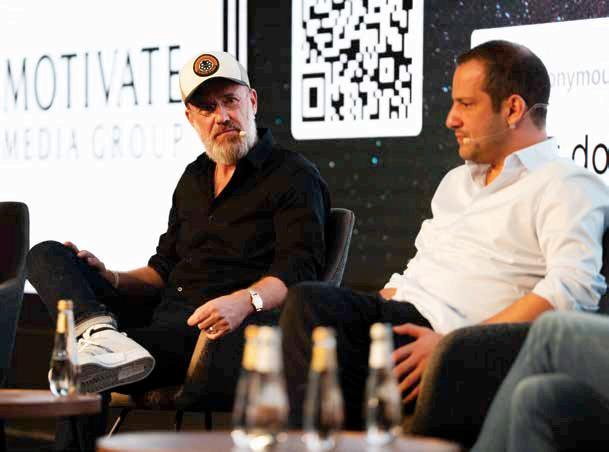

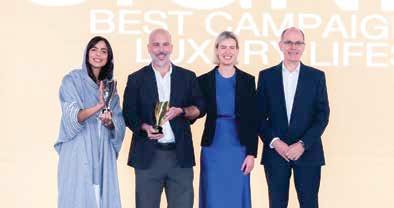




The Athar Awards, held on 22 October at the Four Seasons Hotel Riyadh, brought together more than 1,000 of the industry’s top professionals from across Saudi Arabia’s marketing and communications industry for the festival’s largest recognition platform to date.
Now in its third year, the awards continued to highlight creative work, ideas and teams shaping the Kingdom’s growing creative economy.
This year, the awards attracted 274 finalists across more than 35 categories, reflecting the scale and diversity of entries received. Following a multi-stage judging process led by more than 80 experts from across the public and private sectors, a total of 87 awards were presented during the ceremony, including 36 Gold, 34 Silver, and 17 Bronze trophies.
The 2025 edition introduced several new awards across Campaign, Team, and Individual categories to reflect emerging areas of creative practice. Among the new Campaign categories were Best Artificial Intelligence/Augmented Reality-Powered Campaign, Best Fintech Solutions and E-commerce Campaign, and Best Video Storytelling Campaign – each acknowledging work that integrates creativity with evolving technology and audience insight.
In the Team categories, awards such as Startup of the Year and Production Team of the Year recognised collective achievement in execution, collaboration and innovation. The Individual categories placed a stronger focus on changemaking and impact, adding Disruptor of the Year and Influencer of the Year to the list of accolades.
Beyond the metals presented on stage, this year’s Athar Awards reflected how Saudi creativity continues to grow into a defining force across the Middle East region. What began as a platform for recognition has evolved into a measure of how far the industry has come, a showcase of talent that is not only shaping the Kingdom’s creative identity but also contributing to its global visibility.
By expanding its scope and refining its framework, Athar Awards has reaffirmed its role as a credible benchmark for excellence, celebrating the people and ideas that drive progress and turn Saudi creativity into one of the Kingdom’s most valuable cultural assets.
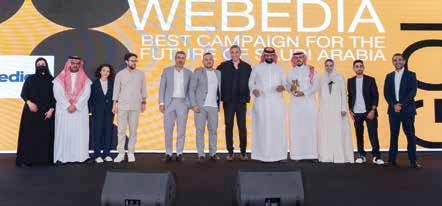
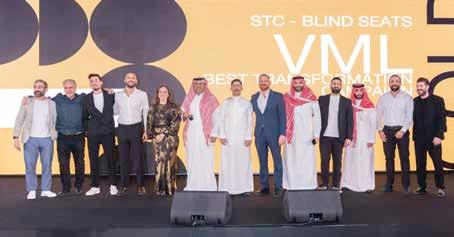


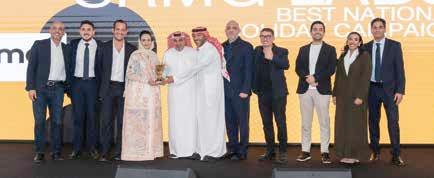




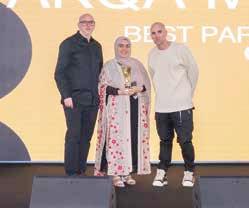

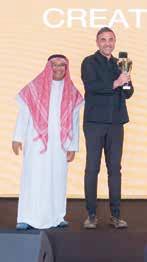

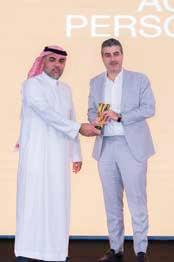

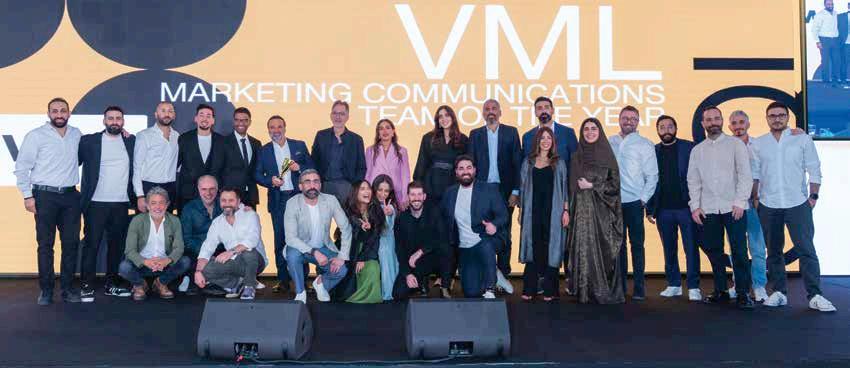

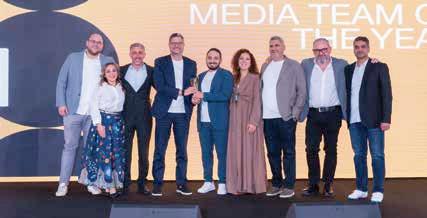



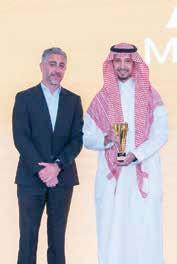
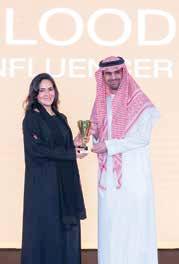
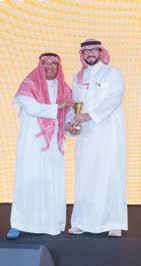
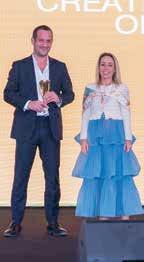


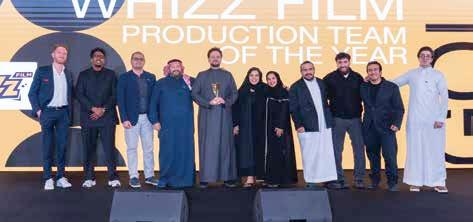
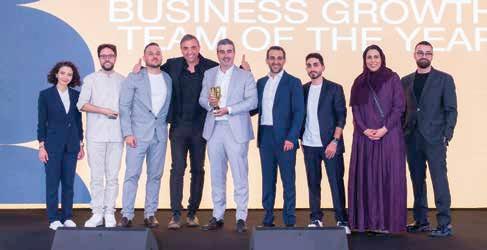




















IAlmarai’s Nabil Sleiman discusses the need for marketers to add gaming to the roadmap for the near future to build cultural relevance, drive immersive storytelling, create experiences beyond advertising and connect with consumers in Saudi Arabia. SAUDI FOCUS



was never a gamer. As a kid, I’d play Mortal Kombat occasionally at my neighbour’s place. I owned Tetris and Atari video games, but my controller kept breaking.
As an adult, I’ve completely drifted away from gaming. I don’t own a console, and I don’t have a single game on my phone. My gaming life pretty much stops at Google Chrome’s jumping dinosaur when my laptop is connecting to a Wi-Fi network.
So, it might sound like a safe bet to say that I have no opinions to share about gaming.
But that would be the wrong bet – because what I am is a marketer – and as a marketer in Saudi Arabia, I have every reason to talk about gaming.
THE NUMBERS TELL A STORY THAT CAN’T BE IGNORED
There are 23.5 million gamers in Saudi Arabia, according to the Saudi Esports Federation. That’s more than two-thirds of the total population of the country. On average, gamers in Saudi spend 96 minutes a day gaming – the second-highest average in the world, surpassed only by Egypt at 115 minutes. Half of these gamers spend about five hours per week gaming, and nearly a million gamers play up to seven hours a day. Every single day. That’s almost a full-time job.
This mirrors global trends. Consumer spending on gaming has already outpaced spending on cinema and streaming combined and is projected to overtake paid TV by 2026, according to The Economist.
Esports viewership has grown by approximately 47 per cent in the past five years, making it one of the most-watched ‘sports’ globally. Riyadh now sits at the centre of all of this, with the 2025 Esports World Cup drawing 750 million viewers.
So even if I’m not a gamer, my interest in the industry as a marketer is genuine.
Just as I had to learn how to communicate with a Saudi mother aged 25 to 45 with two kids –someone I have nothing in common with – I had to learn to communicate with gamers. That goes back to the fundamentals of marketing. First, understand the audience, then, unlock their objective: Why they game
and what they want, in this case. Only once I did this could I truly understand how to communicate with them.
The stereotype was a teenage boy sitting in a dark room. Turns out, 48 per cent of gamers are female, and 31 per cent of hardcore gamers are aged 35 to 44 years old.
The biggest revelation? Parents are gamers too. Some do it to connect with their children; others simply play because they enjoy it. And 45 per cent of those gaming parents are the mothers.
As for why they game, more than half (51 per cent) game to disconnect; 21 per cent play to destress, and 13 per cent to socialise. That last one surprised me, too.
Globally, socialising is a major aspect of gaming – that’s why it’s often referred to as ‘the new social’. When we dug deep, we found that more than half of gamers in Saudi consider themselves sociable and outgoing, and 70 per cent prioritise family time. Both



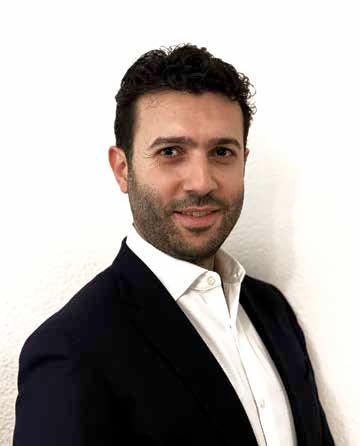
By Nabil Sleiman, Head of Marketing Communications, Almarai

points stand in stark contrast to the stereotype.

According to the Global Web Index, more than half of gamers want brands that are reliable, authentic and smart: 59 per cent, 56 per cent, and 52 per cent, respectively.
Gamers also made what they don’t want very clear. They don’t want brands that treat gaming as just another media channel. It’s not about slapping your logo on a screen. It’s about building a meaningful relationship with the gaming community. And yes, gamers are a community; one where – as a brand – you either belong or you don’t.
Armed with that understanding, the roadmap became clear. To connect with gamers, consistency is key. It’s not about running a four-week campaign and then going silent for six months. It’s not about showing up for Ramadan and back-to-school, then ghosting the community for the rest of the year. If brands want to show up, we have to keep showing up.
We also need to create meaningful and interesting activations. And above all, be authentic. Make sure the brand values are aligned with the values of the gamers. This is how brands build cultural relevance: By integrating into the daily lives of its audiences, driving immersive storytelling, and creating experiences beyond advertising. And above all, it’s about being present where consumers spend hours every week, and turning that presence into ‘part of the game’.
But I believe that the biggest step in this roadmap is taking the first one. And here, context matters. The industry has faced similar challenges before: Thirty years ago, no one was digital-media savvy, and budgets for digital were nonexistent. Twenty years ago, we faced the same skepticism with social media. Today, 73 per cent of total media budgets globally are invested in digital and social.
Advertising spend on gaming is projected to grow twelvefold over the next decade, at a compound annual growth rate (CAGR) of 33.4 per cent to $8.5bn by 2034.
So, here’s the question I’ll leave you with: “Where does gaming sit on your roadmap today, and how early do you want to get on that train?”
Building a regionally resonant global brand is akin to constructing a bridge between two worlds – anchored in local heritage yet stretching out and connecting with a worldwide audience. In the context of Saudi Arabia’s tourism destination brands, this endeavour requires a delicate equilibrium between cultural authenticity and international appeal.
Brett Armitage, Group Head of Branding and Marketing at Red Sea Global, which is spearheading two of the most ambitious tourism projects in the world – The Red Sea and AMAALA – talks to Campaign Middle East about the brand’s transformative journey.
Armitage reveals insights that go beyond nation building and regional representation. He calls for marketers to use meaningful storytelling to create connections rather than sell a sojourn.
At the core of Red Sea Global’s ambitious undertaking is a commitment to creativity that celebrates courage, highlighting unmistakably Saudi lived experiences, brave cultures, and a consistent sense of purpose.
Armitage says, “Building a global brand from Saudi Arabia begins with authenticity. It’s about being deeply connected to our roots, our culture, our environment and our people, while expressing those values in a way that resonates across the world. The goal is not to imitate what’s been done elsewhere, but to contribute something original and inspiring to the global stage.”
He adds, “Red Sea Global aims to show that Saudi Arabia’s story can be told with sophistication, creativity and confidence. By combining world-class design and operations with an authentic sense of place, we can create brands that feel both globally relevant and unmistakably Saudi.”
Moving past traditional marketing tactics, Armitage highlights the power of storytelling to create lasting connections.
He explains, “Storytelling allows us to move beyond promotion and into connection. People don’t want to be sold a destination; they want to feel part of something meaningful.”











This ethos underpins his work with The Red Sea and AMAALA, where the narrative extends beyond the physical destination, inviting guests to discover personal, emotional and cultural revelations.
“Our role is to evoke curiosity, emotion and purpose. The story is not just about where guests are going, but what they’ll discover – about themselves, about nature and about culture,” he says.
That said, for global ideas to shine, they must first be grounded in local truth, be co-created with locals, with messages that are accepted and resonate locally.
Armitage asserts that the “magic happens when you take universal concepts such as wellness, exploration and creativity, and express them through the lens of local culture, materials and people”.
He explains, “We collaborate closely with Saudi artists, architects, and communities to ensure every element feels authentic. It’s this integration of global excellence and local insight that creates something timeless – a sense of place that speaks to the world but could only exist here.”
However, to truly move the needle on collaborative storytelling, creative teams that highlight local culture and lived experiences on the regional and global stage must be trusted and empowered. They need to be bold
SAUDI FOCUS



and brave enough to go big – from idea to implementation.
and brave enough to go big – from idea to implementation.
“Creativity thrives in environments that celebrate courage, collaboration and curiosity. Building strong creative teams means giving people both a clear sense of purpose and the freedom to push boundaries,” Armitage says.
celebrate courage, collaboration and curiosity. Building strong creative teams means giving freedom to push boundaries,” Armitage says.
Keeping this in mind, Red Sea Global has empowered its talent, bringing together local and international minds who challenge each other and elevate ideas.
and international minds who challenge each other and elevate ideas.
“When people feel trusted and inspired, they don’t just deliver great work, they redefine what’s possible. Bold ideas are born from brave cultures,” Armitage adds.
don’t just deliver great work, they redefine what’s possible. Bold ideas are born from brave
Being bold also means going beyond the short-term brief. It’s not just the stories and experiences of the locals that need to shine through in storytelling; their values must move beyond slogans to shine in the spotlight, as well.
experiences of the locals that need to shine through in storytelling; their values must move beyond slogans to shine in the spotlight, as well.
Armitage explains, “Sustainability can’t be an add-on; it must be the heart of the brand. At Red Sea Global, regeneration is not a slogan, it’s our entire operating philosophy. Every decision we make, from infrastructure to guest experience, is guided by how we can leave the environment and communities better than we found them.”
“It’s not about indulgence without consequence, but about purpose-driven experiences that create a positive legacy. When sustainability becomes a lived principle rather than a message, it naturally drives the brand forward,” he adds.
Purpose remains central to success. While many brands have attempted to move at the ‘speed of culture’, ‘speed of tech adoption’ and the ‘speed of trends’, those that have stood the test of time in a rapidly evolving landscape are those that have stood their ground on purpose.
“The challenge is to evolve while staying true to that purpose, to innovate without losing identity. What we’re doing at Red Sea Global is setting a new benchmark, building destinations that combine sustainability, culture and luxury in ways the world hasn’t seen before. The journey hasn’t been without challenges, but it’s incredibly rewarding to be part of a transformation that will redefine not just Saudi tourism, but the future of global travel,” Armitage adds.
Overseeing two of the biggest gigaprojects in the Kingdom, Red Sea Global now stands as a testament to the power of authenticity, storytelling and sustainability in action. Under Brett Armitage’s guidance, the narrative is no longer just about must-visit places and 10 things to do there; it is about locally led creation, cultural fusion and transformative experiences.


Red Sea Global’s Brett Armitage on storytelling with sophistication, creativity with confidence and purpose.
By Anup Oommen




This story goes far beyond building beautiful destinations. It’s a bridge of belonging crafted by those who live and breathe Saudi for those they have invited to their homeland.

Armitage concludes, “Every visual, message and experience should reflect a larger narrative of transformation and belonging. That’s how storytelling becomes a bridge, not a brochure.”










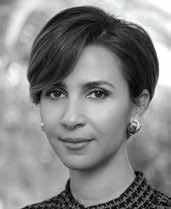






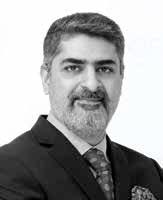





For the first time this year, Campaign Middle East has introduced the Marketing Game Changers Awards – an annual platform created to recognise client-side marketers who have delivered clear, measurable impact on their brands and the wider industry. While individual marketers have been profiled in our pages before, this initiative marks a shift towards a more structured and transparent approach with a dedicated awards programme with defined criteria, formal submissions and independent evaluation.
The awards were free to enter and open to brandside marketers across the MENA region. Entrants were required to have held their current role for at least one year and to have been based in the region for a minimum of two. All submissions were reviewed for achievements over the past 12 months across six criteria:
Leadership & Talent Development assessed how entrants build capability and culture within their teams.
Creativity & Innovation considered original thinking that contributed to brand or business progress.
Performance & Business Impact looked at how marketing activity delivered tangible results.
A new platform that recognises client-side marketers who delivered measurable impact across creativity, performance, leadership and industry contribution – all selected by a jury of 34 industry veterans through a transparent process.
Brand Building reviewed contributions to equity, positioning and long-term perception.
Social Impact recognised purpose-driven initiatives that led to positive societal outcomes.
























Industry Contribution focused on how marketers support the wider profession and raise standards across the ecosystem.
A panel of senior figures from across the region’s advertising, media and marketing community independently assessed the entries over a two-week period. Scores across the criteria were averaged to determine the final scores. According to the judges, the winning marketers demonstrated tangible outcomes, purposeful initiatives and clear value to the marketing ecosystem.
Based on the jury’s scoring, the top 10 have been named Campaign Middle East’s Marketing Game Changers for 2026, with the highest-scoring entry receiving the title of Marketer of the Year. This year’s winners represent a wide cross-section of sectors – from telecommunications and government to tourism, F&B, quick commerce, packaged goods, FMCG and financial services. All will be honoured during the Agency of the Year Awards gala on 11 December 2025.
In the following pages, each of the selected leaders reflects on the challenges facing the industry, the achievements that defined their year and the advice they would offer the next generation. Together, their perspectives provide insight into what marketing leadership looks like today – and where it is heading next. Congratulations to all the winners!
Ahmed Al Sahhaf, Chief Executive Officer, MBC Media Solutions
Amer El Hajj, CEO MENA, WPP Media
Asmaa Quorrich, Founder and CEO, Think Big Consulting, ZAAZ Wellness and Beauty
Avishesha Bhojani, Group CEO, BPG Group
Banali Malhotra, Board Advisor and Regional Marketing Leader
Bassel Kakish, CEO, Publicis Groupe Middle East and Turkey
Conrad Egbert, Head of PRCA MENA
Dani Richa, Chairman, BBDO Europe Middle East and Africa
Dany Naaman, CEO, Havas Middle East
Elda Choucair, CEO, Omnicom Media Group
Eleni Kitra, Executive Director, Advertising Business Group Middle East
George Maktabi, Group CEO, Webedia Group MENA
Habib Wehbi, Chairman & Group CEO, W Group Holding (Hypermedia, DXTA & AiOO)
Houda Tohme, CEO, HAVAS Media
Middle East
Ian Manning, Executive Director, IAB MENA
Jawad Hassan, Head of Media and Communications Vertical, Multiply Group
Joe Nicolas, CEO, UM MENAT
Khaled M. Ismail, CEO and Founding Partner, ToughLove Advisors
Lara Arbid, CEO, Initiative and Magna Global MENAT
Sir Martin Sorrell, Founder and Executive Chairman of S4 Capital
Maria Gedeon, CEO, Gedeon Mohr & Partners
Mazen Nahawi, Founder and Group CEO, CARMA
Melis Ertem, CEO, MMA MEA
Mounir Harfouche, CEO, MullenLowe MENA
Nassib Boueri, CEO, VML MENA
Ramzy Abouchacra, MENA Media Practice President, Denstu
Rami Hmadeh, CEO, Serviceplan Group
Middle East
Ravi Rao, Managing Partner, Climaty.AI
Reda Raad, CEO, TBWA\Raad
Sunil John, Senior Advisor –MENA, Stagwell
Tarek Daouk, CEO MENAT, Dentsu and President Merkle SEMENAT
Tarek Miknas, CEO, FP7 McCann MENAT
Tony Wazen, CEO, Publicis Media
Middle East
Vikram Krishna, Co-Founder and Chairperson, The Sacred Groves CIC
Executive Director of Marketing and Communication, UAE Government Media Office
YEARS IN THE COMPANY : 11
YEARS IN THE REGION : 21





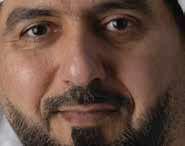


What is the top challenge the marketing and advertising industry needs to address on priority?
The real challenge is depth over decoration. Too often, our industry chases noise instead of meaning; short-term campaigns that entertain but do not endure. Brands must move beyond vanity metrics and start asking harder questions: Are we genuinely shaping culture? Are we solving problems that matter to people? Are we leaving a legacy of trust, not just impressions? Until we shift from moment marketing to meaningful marketing, we risk losing relevance to the very people we claim to serve.
What do you consider your top achievement over the past 12 months?
My top achievement has been proving that nation branding can be provocative, creative and globally competitive. With Bring Your Impossible, we placed a government brand on the same creative stage as the world’s boldest advertisers; daring to




launch headlines initially rejected in global capitals, negotiating them into approval, and delivering a campaign that earned respect, attention and measurable results. For me, the achievement is not just the campaign’s reach, but the fact that it redefined expectations of what a government can say and how far it can push the boundaries of creativity.
What is your advice to the next generation of marketers?
Be brave, but also be generous. Don’t just chase campaigns; chase change. Celebrate your agencies, your peers, even your competitors, because true leadership is about lifting an entire ecosystem, not just yourself. The next generation of marketers must see themselves not only as brand guardians but as industry builders; people who will leave behind better standards, bolder work, and stronger talent pipelines than they inherited. That is how respect is earned, and how real legacies are made.
A classic marketing trick that never gets old? Simplicity.
Most overrated buzzword in marketing? Storytelling: when it’s said, not lived.
Favourite nostalgic ad from your childhood?
7 Up. The Fido Dido ‘Ya Lazeez Ya Rayiq’ era.
One marketing principle you’ll never compromise on? Bravery.
Book, podcast or show you recommend to everyone?
The Qur’an.
Biggest lesson you’ve learnt in your career? Presence beats process.
What you’d be doing if not marketing? Lawyer.
One thing your colleagues would be surprised to know about you?
I don’t measure risk; I feel it.
The future of marketing in one word? Trust.
Khaled Al Shehhhi believes creativity can move nations, not just markets. A bold voice in public-sector storytelling, he has redefined how governments connect with people worldwide. As the first government-sector juror in Cannes Lions history, he symbolises the UAE’s growing creative power. Under his leadership, the UAE Government Media Office ranked fourth globally in the 2022 Effie Index.
His work has earned more than 220 awards, including the Effie MENA Honorary Award (2022), Dubai Lynx Advertising Person of the Year (2023), the Loeries Marketing Leadership & Innovation Award (2023), and the World Media Group’s Content Leadership & Innovation Award (2022).
From systems to stories, he brings an engineer’s precision to the art of emotion. He champions government communication that’s not safe but bold, human, and unforgettable. Through mentoring and industry leadership, he continues to shape a new era of purpose-driven creativity across MENA and beyond.
VP – Brand and Marketing Communications, du
years in the company : 19
years in the region : Emirati. Born in the region.
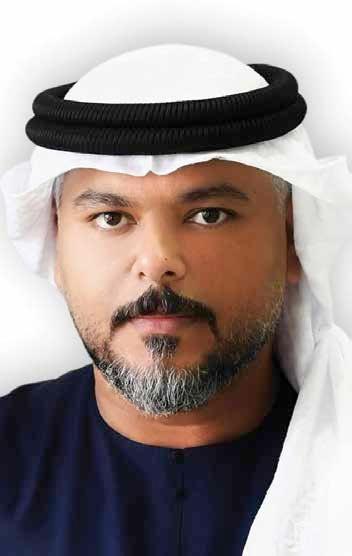
What is the top challenge the marketing and advertising industry needs to address on priority?
The top challenge facing the marketing and advertising industry today is cutting through digital fatigue with authentic, emotionally resonant storytelling. Audiences are bombarded with content across platforms, yet crave genuine connection and purpose-driven messaging. Brands must shift from transactional communication to building trust through empathy, relevance and cultural sensitivity. It’s no longer about being louder – it’s about being meaningful. In a world of algorithms and short attention spans, the priority is crafting campaigns that feel human, spark emotion and foster lasting relationships. Only then can marketing truly move hearts and minds.
With 19 years of experience in strategic marketing communications – all at du – Ibrahim Al Mayahi has grown from a passionate designer into a brand and creative powerhouse. His journey began at the American University of Sharjah, where he studied design and laid the foundation for a career driven by storytelling, emotional resonance and bold visual thinking.
At du, Al Mayahi has led transformative campaigns that connect deeply with audiences, blending insight with imagination. He’s a brand guardian, a creative strategist, and someone who lives and breathes the art of emotional engagement. Whether crafting a visual identity or shaping a narrative, Al Mayahi brings heart, vision and nearly two decades of hands-on expertise to every challenge.
A classic marketing trick that never gets old? Tapping into nostalgia to evoke emotion and trust is a timeless marketing move that never fails to connect.
Most overrated buzzword in marketing? Viral.
Favourite nostalgic ad from your childhood? I grew up loving the Lurpak ads and the classic 7 Up commercials. They are simple, catchy and unforgettable.
One marketing principle you’ll never compromise on?
Authenticity. Because real connection only happens when your message reflects genuine purpose and truth.
Book, podcast or show you recommend to everyone?
Tony Buzan’s Guide to Mind Mapping. It completely transformed how I organise my
What do you consider your top achievement over the past 12 months?
I’m proud to have driven impactful business results, including significant revenue growth through emotionally resonant campaigns that elevated brand engagement.
But beyond the numbers, my greatest achievement has been nurturing and empowering my team. Watching them evolve creatively, take ownership, and push boundaries has been deeply rewarding.
Building a culture of trust, passion and purpose has not only amplified our output – it’s created a space where ideas thrive and people grow.
I am so proud to have grown and empowered this team to a point where I can send them off to a chief meeting by themselves, and I know they will deliver with perfection. This team is
thoughts and approach creativity.
I’d like to highlight an app: Be My Eyes. It allows you to assist blind individuals with everyday tasks and opens your own eyes to new perspectives and the beauty of human connection.
Biggest lesson you’ve learnt in your career? Always stay human – feel deeply, listen with intention, and honour the stories people carry. It’s not just talent that shapes greatness, but the quiet power of showing up, day after day, with heart and discipline.
What you’d be doing if not marketing? Chief AI Officer or Creative AI Officer. And, if not that, I would 100 per cent be an interior designer.
One thing your colleagues would be surprised to know about you?
I’m a professional horseback rider and foodie.
The future of marketing in one word? Connection.
the heartbeat behind every milestone we’ve reached.
What is your advice to the next generation of marketers?
Lead with heart, be human no matter what, and nurture. In a world overflowing with data and automation, emotional intelligence is your superpower. Don’t just sell; connect.
Understand your audience’s hopes, fears and dreams, and craft stories that resonate deeply. The most memorable campaigns aren’t the loudest; they’re the ones that make people feel something. Be curious, stay human and never underestimate the power of empathy in shaping brand love. Marketing isn’t just about products; it’s about people. So listen more, feel more and create with purpose. Emotion moves markets, and authenticity builds legacies.
Founder & CEO, InsuranceMarket.ae
years in the company : 15
years in the region : 37

















Avinash Babur is the CEO and visionary force behind InsuranceMarket.ae, the UAE’s largest insurance platform. Under his leadership, the company has redefined how insurance is perceived and purchased, making it more accessible, transparent, and customer-centric. A serial innovator, Babur has introduced pioneering services such as dedicated insurance advisors, personal claims managers and the myAlfred super app, which enhances policyholder value through exclusive lifestyle rewards.
Recognised as a thought leader in digital transformation, Babur has spearheaded InsuranceMarket.ae’s rise to become the nation’s number one insurance provider, trusted by millions of customers and backed by more than 26,000 Google reviews with a 4.8-star rating. He is celebrated not only for driving growth and industry disruption, but also for building a culture of excellence and innovation. With a passion for technology, people, and purpose, Babur continues to shape the future of insurance in the UAE and beyond.
A classic marketing trick that never gets old? Storytelling.
Most overrated buzzword in marketing? Metaverse.
Favourite nostalgic ad from your childhood?
Amul’s witty billboard campaigns.
One marketing principle you’ll never compromise on? Trust.
What is the top challenge the marketing and advertising industry needs to address on priority?
Cutting through the noise. Consumers are bombarded with messages every second, and attention is the rarest commodity. The challenge is no longer reach; it is relevance. The industry must focus on depth of engagement rather than breadth of exposure, building trust through authenticity rather than chasing vanity metrics.
What do you consider your top achievement over the past 12 months?
Sustaining growth while elevating brand equity. At InsuranceMarket.ae, we did not just scale our numbers; we reinforced our position as a
Book, podcast or show you recommend to everyone?
Good to Great by Jim Collins.
Biggest lesson you’ve learnt in your career? Sustainable growth beats short-term spikes.
What you’d be doing if not marketing?
Making films.
One thing your colleagues would be surprised to know about you?
I am a passionate student of Bitcoin.
The future of marketing in one word? Personalisation.
trusted household name in the UAE. The successful launch of major brand milestones, such as the InsuranceMarket.ae Metro Station naming rights and record customer satisfaction scores stand out, but what I value most is how our team kept culture and performance aligned through rapid expansion.
What is your advice to the next generation of marketers?
Do not confuse activity with impact. Technology will keep changing, platforms will rise and fall, but the fundamentals of human connection remain the same. Focus on storytelling, trust, and consistency. Master the craft of measuring what truly matters and never forget that marketing is a leadership function, not just a support function.
Director of Brand and Communication, HungerStation
years in the company : 4+
years in the region : 17+

What is the top challenge the marketing and advertising industry needs to address on priority?
The industry’s top challenge is balancing short-term performance with long-term brand building. Brands that focus too heavily on promotions and immediate return on investment (ROI) become vulnerable, risking the dilution of distinctiveness and equity. The priority must be to create sustainable models that blend data-driven efficiency with creativity and storytelling. By addressing this imbalance, marketing can move beyond chasing metrics to humanising brands, building deeper connections that endure. This approach ensures brands not only convert today but also remain relevant, trusted and valuable in an increasingly competitive
Ahmad Chatila is the Director of Brand and Communication at HungerStation, a leading Saudi food delivery platform that is part of Delivery Hero. He is focused on shaping breakthrough strategies that accelerate growth, strengthen brand equity and set new creative benchmarks for the region. Chatila brings more than 17 years of experience in building brands, leading large-scale campaigns, and pioneering marketing innovation across Saudi and the wider MENA region, including a leadership role at Samsung Mobile KSA.
He championed the brand platform that delivered Saudi Arabia’s first Cannes Lions Grand Prix, establishing a milestone moment in the Kingdom’s creative journey. Recognised by Campaign Middle East as a 2023 Marketing Game-Changer and having served as a Saudi Ad School mentor, Chatila has contributed to the advancement of the local brand and marketing landscape.
Chatila holds a Master’s in Digital Transformation Leadership and a Bachelor’s in Marketing. Passionate about creativity, technology and digital transformation, he holds a track record of turning bold ideas into measurable business and brand impact.
A classic marketing trick that never gets old?
Social proof.
Most overrated buzzword in marketing?
Growth hacking.
Favourite nostalgic ad from your childhood?
RayOVac Battery ad from 1982.
One marketing principle you’ll never compromise on?
Positioning before creativity.
Book, podcast or show you
landscape, delivering both immediate business results and long-term cultural resonance.
What do you consider your top achievement over the past 12 months?
My top achievement over the past 12 months has been leading HungerStation, with my marketing colleagues, to yet another historic milestone: Winning six Cannes Lions in 2025, following Saudi Arabia’s first Grand Prix at the Cannes Lions Festival of Creativity in 2023. This recognition elevated the brand and positioned the Kingdom on the global creative stage.
On a personal level, the real achievement was balance, making sure not to miss my kids’ football training and committing, whenever possible, to a healthier work-life rhythm. Achieving both professional success and
recommend to everyone?
Start with Why by Simon Sinek.
Biggest lesson you’ve learnt in your career?
Trust creates leaders.
What you’d be doing if not marketing?
Production and filmmaking.
One thing your colleagues would be surprised to know about you?
I studied psychology on the side.
The future of marketing in one word? Immersive.
personal presence has been the most rewarding accomplishment of the year.
What is your advice to the next generation of marketers?
My advice to the next generation of marketers is to stay human in an increasingly high-tech world. Embrace technology as a powerful enabler, but never lose sight of the human element. People connect with emotions, stories and authenticity, qualities that will always matter more than any artificial intelligence (AI) algorithm. At the same time, stay endlessly curious. The industry evolves at lightning speed, and what works today may be outdated tomorrow. Keep learning, experimenting and questioning. The blend of human insight and continuous learning will keep you relevant and impactful.

CMO – Middle East & Africa, Kraft Heinz years in the company : 8.5 years in the region : All my life.






What is the top challenge the marketing and advertising industry needs to address on priority?



The top challenge our industry faces is balancing long-term brand building with short-term results in a high-pressure economy. Today, consumers are more value-driven than ever, and brands are pushed to deliver immediate returns while still sustaining equity for the future.
In an era of fragmented media, rising misinformation and AI-driven content, trust becomes the currency that bridges both
horizons. To stay relevant, marketers must shift from chasing attention to earning trust – by delivering value now, while consistently investing in meaningful, purposeful and insight-driven creativity that secures growth for the long run.
What do you consider your top achievement over the past 12 months?
Our biggest achievement has been the launch of Heinz condiments in the Middle East & Africa. In just three months, the range soared 60 per cent above target, reaching a 7 per cent market share – an unheard-of pace for a new
Passant El Ghannam is a strategic and creative growth leader with more than 17 years of international experience in FMCG, having led iconic brands such as Heinz, Dettol, Harpic and Vanish across global and regional markets.
Now CMO MEA at Kraft Heinz in Dubai, she’s known for turning challenges into growth, crafting disruptive strategies, and delivering award-winning campaigns.
Recognised as a Campaign Middle East 2023 Marketing Game Changer, El Ghannam has earned more than 66 industry awards for her transformative impact. She’s passionate about unlocking growth through insight, creativity and purposeful leadership.
A classic marketing trick that never gets old? A good story.
Most overrated buzzword in marketing?
AI will take over creativity.
Favourite nostalgic ad from your childhood? Egyptian jingles.
One marketing principle you’ll never compromise on? Consumer first.
Book, podcast or show you recommend to everyone? Radical Candor.
Biggest lesson you’ve learnt in your career? Be true to yourself.
What you’d be doing if not marketing? Film director.
One thing your colleagues would be surprised to know about you?
Not sure … I’m open book.
The future of marketing in one word? Limitless.
category entry. What started as a regional play turned into a global success story, with the innovations now being exported to Chile and Mexico. It’s proof that bold ideas from our region can travel the world – and that creativity, when paired with consumer obsession, can drive both cultural impact and business growth.
What is your advice to the next generation of marketers?
Be authentic – as a leader and as a brand. Louder voices may grab attention, but truer ones build trust, and trust builds everything.
Marketing Director, Royal Commission for AlUla years in the company : 6
years in the region : 11


What is the top challenge the marketing and advertising industry needs to address on priority?
Today’s audiences don’t give brands time – they give them a glance. The biggest challenge is earning trust and cutting through in that moment.
What do you consider your top achievement over the past 12 months?
Proving that AlUla isn’t just a place on the map but also a brand that shifts behaviours, from summer travel patterns to global perceptions.
What is your advice to the next generation of marketers?
Marketing is a privilege. You’re telling stories that shape how people see places, products and even themselves. Take that responsibility seriously.

A classic marketing trick that never gets old?
Scarcity. Make people feel like they are missing out, and they will lean in.
Most overrated buzzword in marketing? Disruption. Often just noise dressed up as a strategy.
Favourite nostalgic ad from your childhood?
Good way to age everyone!
Guinness ‘The Surfer’ – those waves and the drumbeat, etched in my memory.
One marketing principle you’ll never compromise on?
Every claim must be substantiated. If you can’t prove it, don’t say it.
Book, podcast or show you recommend to everyone?
David Attenborough’s shows. They teach humility, patience and the art of letting the subject shine brighter than the storyteller.
Biggest lesson you’ve learnt in your career?
That great marketing is about subtraction, not addition. Strip it back until the idea sings. What you’d be doing if not marketing? F1 pit crew.
One thing your colleagues would be surprised to know about you?
That I started in this industry with no tourism experience myself. I’ve learnt it all on the job.
The future of marketing in one word? Human.
Charlotte Eland is a brand marketing leader with 18 years of experience driving cultural and commercial impact through content, campaigns and strategic storytelling. Currently Marketing Director at the Royal Commission for AlUla, she oversees brand strategy, event marketing and global sponsorships for one of Saudi Arabia’s most ambitious tourism and heritage destinations.
Her work has played a central role in positioning AlUla on the global stage, leading award-winning campaigns like Journey Through Time and The World’s Masterpiece and securing multi-million-dollar brand partnerships across the luxury, wellness and entertainment sectors.
Previously, Eland spearheaded international communications for Dubai Tourism and led entertainment and hospitality portfolios at Edelman and leading UK agencies.
Eland is passionate about the power of place branding, the art of building trust through content, and finding fresh ways to connect with audiences in an oversaturated world.
Vice President Brand and Communications, Dubai Airports
years in the company : 6
years in the region : 10
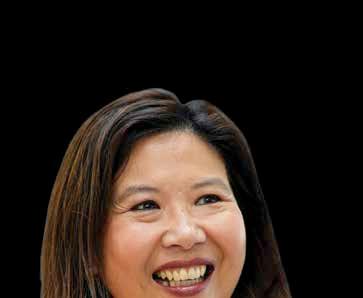
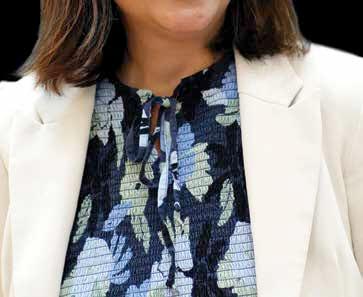

What is the top challenge the marketing industry needs to address on priority?
The top challenge for marketing and advertising today is keeping pace with rapid technological change and leveraging tools, particularly artificial intelligence (AI), as an enabler rather than a replacement, to enhance creativity, insight and efficiency. At the same time, brands must navigate an increasingly fragmented media landscape, understanding the right digital platforms and creating optimal content to engage audiences effectively at every touchpoint. Addressing both priorities is essential for marketing to remain strategic and future-ready.
Michelle Lee is the Vice President of Brand and Communications at Dubai Airports. Lee has more than 17 years of experience in marketing and joined Dubai Airports in December 2019.
Prior to her current position, Lee has held various global marketing and customer experience leadership roles in the aviation, tourism, insurance, automotive and consumer goods industries across local and global enterprises that include Qatar Airways, Aer Lingus, Virgin Australia, Air New Zealand and Pepsico. Lee’s most recent role was Chief Marketing Officer EMEA for MetLife, based in Dubai, UAE.
Lee holds double bachelor’s degrees in Commerce and Arts from the University of Auckland, with majors in marketing and psychology. She also attended the University of Virginia School of Business Leadership Programme and achieved certifications in Strategy in the Age of Digital Disruption from INSEAD and Implementing Winning Strategies from Columbia Business School Executive Education. Active in various international marketing bodies, Lee has been invited to participate in judging panels of multiple creative and advertising award events within the industry.
A classic marketing trick that never gets old? Relationship building. You can never underestimate the value of human connection, whether it’s through simple personalisation of messaging or hosting an in-person event. Fostering human connections and showing a genuine interest in your target audience, whether B2B, B2C, or B2E, is a classic marketing trick that works and will never date. Most overrated buzzword in marketing? Viral.
Favourite nostalgic ad from your childhood? Nike’s first Just Do It ad, featuring Walt Stack.
What do you consider your top achievement over the past 12 months?
The oneDXB Engagement Ring campaign, which successfully mobilised the DXB community to rally around our brand proposition, “Welcoming Guests, the Dubai Way” and deliver a unified service experience, contributing to DXB maintaining its position as the world’s busiest international airport for the 11th consecutive year. I am also proud to have strengthened the credibility, trust and respect of marketing and communications within Dubai Airports by demonstrating our impact on the organisation. Through initiatives like ‘Bring Your Dubainess’, we drove
One marketing principle you’ll never compromise on?
Knowing your audience.
Book, podcast or show you recommend to everyone?
Diary of a CEO with Steven Bartlett.
Biggest lesson you’ve learnt in your career? Be resilient; continue to stay focused on the end goal and take the time to reflect.
What you’d be doing if not marketing? Be an interior designer.
One thing your colleagues would be surprised to know about you?
Love to cook and bake.
The future of marketing in one word? Personalisation.
employee engagement, influenced organisational culture and fostered advocacy for our employer brand, showing how marketing delivers tangible value beyond traditional campaigns.
What is your advice to the next generation of marketers?
Listen, experiment, and learn from successes and mistakes to continuously improve. Stay curious, ask ‘why’, find out what the problem is before jumping into the solution, and be bold when ideating solutions. Understand your audience, pay attention to detail, and most importantly, be yourself and stay authentic.
Group Marketing Manager, NMK Electronics, A Midwich Group Company years in the company : 8.5 years in the region : 15





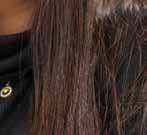


What is the top challenge the marketing and advertising industry needs to address on priority?
The biggest challenge the marketing and advertising industry must address is balancing creativity with authenticity in an age of saturation and scrutiny. Audiences are more informed and values-driven than ever, and they demand transparency, purpose, and inclusivity alongside innovation. The priority now is to build campaigns that are not only imaginative but also sustainable, responsible, and trustbuilding. Marketers must go beyond short-term metrics to create long-term value – advancing ESG goals, elevating diverse voices, and demonstrating measurable impact that strengthens both brands and communities.
What do you consider your top achievement over the past 12 months?
My proudest achievement in the past 12 months has been transforming the way NMK approaches marketing – both internally and externally. I rolled out an AI-powered marketing automation platform, integrating all channels
Maleeha Riaz is a marketing leader recognised for her imaginative approach to brand building and her impact on the AV and technology sector. As Head of Marketing at NMK Electronics, part of Midwich Group, she has transformed marketing into a growth engine – driving high-profile events, pioneering industry-first initiatives, and leading initiatives such as NMK Academy and the NMK Interactive, among others. Under her leadership, NMK has trained thousands of professionals, expanded its regional footprint, onboarded new brands into its portfolio, and established itself as a trusted partner for clients and global manufacturers alike.
Beyond her corporate role, Khan is an advocate for inclusion and sustainability. She was a founding pillar in establishing a Women Council in the AV industry, champions ESG initiatives such as Iftar distribution drive, tree planting, office recycling, and paper-free policies, and mentors women pursuing AVIXA certification and advanced degrees. Recognised with accolades including Inavate’s 40 Under 40, Influential Women in Tech, and a CSR Award by Dubai Municipality, she continues to inspire growth and change across the industry.
A classic marketing trick that never gets old?
Storytelling – because people forget data, but they never forget a good story.
Most overrated buzzword in marketing?
Innovation. Every campaign is called innovative, even when it’s just repackaging the same idea.
Book, podcast or show you recommend to everyone?
Start with Why by Simon
Sinek. A timeless reminder that purpose drives everything.
Favourite nostalgic ad from your childhood?
7UP Fido Dido. Cool, quirky, timeless.
One marketing principle you’ll never compromise on?
Consistency. Great brands are built brick by brick.
Biggest lesson you’ve learnt in your career?
Leadership is not about being the loudest voice in the room, but the one that listens, supports, and
and streamlining databases into a single unified system. This has dramatically improved efficiency, reporting, and ROI tracking across campaigns.
I successfully executed flagship events, including but not limited to the Season Kick-Off and NMK InterActiVe, which combined scale, creativity, and measurable engagement, bringing together clients, partners and system integrators in unforgettable ways.
I oversaw the gradual launch of NMK Beyond, our experience centre, from Studio B to immersive brand activations – positioning NMK as an industry hub.
I also led the onboarding of several new global brands into our portfolio, strengthening our market offering and regional presence.
What is your advice to the next generation of marketers?
My advice to the next generation of marketers is simple: be curious, be bold, and stay human.
The industry is evolving faster than ever –with AI, data, and automation transforming how we work – but technology will never replace creativity, empathy and storytelling. Learn to
makes others believe in their own potential.
What you’d be doing if not marketing?
Sustainability advocacy – building purpose-driven initiatives that give back.
One thing your colleagues would be surprised to know about you?
I rap in my free time, creativity doesn’t stop at campaigns for me.
The future of marketing in one word?
Community. The shift from audience to belonging.
harness new tools, but don’t lose sight of the people behind the data.
Build campaigns that resonate emotionally, not just statistically.
Always measure impact, but also measure meaning: Did your work build trust? Did it inspire? Did it create long-term value?
Finally, remember that marketing isn’t just about selling products – it’s about shaping culture, driving purpose, and telling stories that matter.
If you stay imaginative, authentic and willing to experiment, you’ll not only succeed in marketing but also make a lasting impact on the world around you.
We live in a time when it is easy to be mesmerised by sophisticated tools and overwhelmed by fleeting trends. I encourage young marketers to return to the core question: Does this genuinely serve our audience and consumers?
Technology has always been there as an enabler, but the marketers who will thrive are those able to harness new capabilities while maintaining an unwavering focus on delivering real value to real people.
Vice President, Destination Marketing and Communications, Ras Al Khaimah Tourism Development Authority (RAKTDA) years in the company : 5.5 years in the region : 18
With an 18-year track record in strategic planning and delivery, Winter specialises in brand and tactical marketing, digital, media relations, PR, reputation management and corporate and stakeholder communications.
As Vice President, Destination Marketing and Communications for Ras Al Khaimah Tourism Development Authority, Winter is tasked with elevating the profile of the northern emirate in the UAE and ultimately driving its vision of becoming a sustainable destination and attracting more than 3.5 million visitors annually by 2030.







As a travel and hospitality expert, Winter’s career has taken her from Fairmont, Raffles and Swissotel to Accor, one of the largest hotel operators worldwide. During her time at Accor, she was the custodian of 30 brands and oversaw a portfolio of more than 350 hotels across 36 countries.
A classic marketing trick that never gets old?
Using humour.
Most overrated buzzword in marketing?
Double click.
Favourite nostalgic ad from your childhood? Alka-Seltzer (especially the jingle – plop plop, fizz fizz, oh what a relief it is). Genius marketing in getting consumers to use more than one tablet. Also love it as it’s my namesake.
Biggest lesson you’ve learnt in your career? You’re never full stack enough; keep acquiring skills – and keep stacking.
What is the top challenge the marketing and advertising industry needs to address on priority?
Demonstrating the strength of brand to stakeholders. As brand building compounds over time, a lot more work needs to be done to get relevant stakeholders (the board, finance, procurement and C-Suite) on-side and prepared for the long game.
What do you consider your top achievement over the past 12 months?
My top achievement and an area that I am incredibly proud of is the development, the diversity and the tenure of my team. They are my ‘Justice League’, spanning across 10 different nationalities, three different
One marketing principle you’ll never compromise on?
Craft and quality.
Book, podcast or show you recommend to everyone?
Uncensored CMO by Jon Evans.
For great storytelling, hinging on the horrific and – really nothing to do with marketing
– MrBallen: Strange, Dark & Mysterious Stories.
What you’d be doing if not marketing? Collecting art.
One thing your colleagues would be surprised to know about you?
I’m pretty shy.
generations and a range of experiences (from hospitality marketing, ad agency to e-commerce and online travel agency (OTA). Not only am I incredibly proud of the work we’ve produced over the years, but I’m even more chuffed to see them develop into leaders in their own right.
Advice to the next generation of marketers?
Be aware of your surroundings from an industry standpoint.
What are the most pressing issues of the day and how can you, as a marketer, help solve them?
Observe popular culture and social undercurrents. The more you show relevancy within this context, the more impactful your work will be.
years in the company : 6
years in the region : 20







What is the top challenge the marketing industry needs to address on priority?
The top priority challenge is preserving human creativity and critical thinking as AI transforms all aspects of the marcomms industry. While AI empowers content creation and accelerates execution, the industry risks commoditisation – where everyone has access to the same tools producing similar outputs. The pressing question is: How do we protect diversity in advertising from sliding into a homogenised, soulless pursuit of efficiency?
To ensure that brands don’t sacrifice distinctive voice and emotional resonance for efficiency, the industry should adopt a humanAI framework of collaboration that enhances rather than diminishes creative excellence, while addressing concerns about IP and brand differentiation.
Here, marketers must redefine creativity’s value by maintaining the role of conceptual
Nabil Sleiman is a multi-awarded marketing leader with more than 20 years of experience elevating powerful brands, mentoring multidisciplinary teams and driving unconventional campaigns powered by data and deep consumer insights.
As Head of Marketing Communications at Almarai Company since 2019, the fourth most valued dairy brand in the world for the year 2025, Sleiman leads a diverse portfolio of more than 30 brands and sub-brands across the GCC, Egypt, and Jordan. Under his leadership and guidance, Almarai has earned more than 50 global and regional awards, while consistently pushing boundaries in digital innovation and disrupting the industry with ahead-of-the-curve investments.
Sleiman has pioneered emerging platforms, including gaming integrations, AI-powered content creation, and next-generation engagement strategies that have established new benchmarks for the region.
A strong believer in the value of research, his approach balances technological innovation with unwavering consumer-centricity. He believes that the most sophisticated tools must always serve genuine audience needs.
A classic marketing trick that never gets old?
Listen to your consumer … always.
Most overrated buzzword in marketing? Artificial intelligence (AI).
Favourite nostalgic ad from your childhood? Yes, 3 in 1. A classic Lebanese ad from the 1980s.
One marketing principle you’ll never compromise on? Consumer-centricity.
thinking, cultural insight, and authentic storytelling that AI can’t replicate.
What do you consider your top achievement over the past 12 months?
In the past year, I led a mission to reposition Almarai, a 48-year-old name, ensuring it resonates with Saudi Arabia’s profound demographic and cultural shifts and leverages technology without compromising authenticity. Saudi society is younger and more diverse: 53 per cent of the population is under 24 and female workforce participation has nearly doubled. To bring this mission to life, we launched more than 80 campaigns across more than 30 major communications projects.
I also drove unprecedented digital innovation and initiated 10 disruptions in gaming; pioneering regional integrations with Roblox; Fortnite and EA FC; an AI-driven video campaign generating 1,600 unique assets, and a unique partnership with Shahid. For marketing
Book, podcast or show you recommend to everyone?
Diary of a CEO.
Biggest lesson you’ve learnt in your career? When there is a will, there is a way.
What you’d be doing if not marketing?
Marketing. It’s one of those rare times when I didn’t have a plan B.
One thing your colleagues would be surprised to know about you?
I studied to be a financial auditor.
The future of marketing in one word? Positively unpredictable.
leaders, taking disruptive measures with legacy brands like Almarai is both challenging and sensitive; but my strategy remains data-driven, navigating between cultural heritage and audience relevance.
Advice to the next generation of marketers?
It worries me to see young marketers who have lost their compass, drawn to anything labelled as technologically advanced or innovative, while forgetting that our role should remain consumer-centric and audience-relevant. We live in a time when it is easy to be mesmerised by sophisticated tools and overwhelmed by fleeting trends. I encourage young marketers to return to the core question: Does this genuinely serve our audience and consumers?
Technology has always been there as an enabler, but the marketers who will thrive are those able to harness new capabilities while maintaining an unwavering focus on delivering real value to real people.



































https://www.wppmedia.com/local/mena
The Middle East and North Africa (MENA) region’s media landscape has never been more dynamic. Viewers are streaming premium content on Connected TV, listening to podcasts during commutes and engaging with digital screens that are woven into our everyday environments. Yet while our media habits have evolved, the way the industry measures success is still in the development stage.
The media and marketing community still celebrate impressions, clicks and views –metrics that tell us what was served, not what was seen. In a world defined by fragmented attention, these vanity metrics don’t reveal whether audiences actually noticed, understood or cared. To move forward, we must evolve from measuring exposure to measuring experiences. That evolution begins with one universal metric: Attention.





We’re not buying media anymore – we’re buying real consumer connections.
THE VANITY TRAP
For years, success has been tied to scale. The cheapest cost per thousand (CPM) wins, and those with the biggest reach have been taking the most credit. But what do millions of impressions mean if your audience never even notices you. Optimising towards clicks often rewards clickbait, not brand-building. This system simply drives volume, not value.
As consumers become more selective, swiping past ads in seconds or tuning out passive placements, measuring real engagement becomes the missing bridge between media investment, business impact and growth.
It’s also a matter of trust. According to IAB MENA, up to 20 per cent of digital ad budgets in the region – an estimated $1.25 bn annually – are lost to fraud. When so much value disappears before an ad is even seen, it’s no surprise that marketers are seeking new ways to validate effectiveness.
Attention changes the rules. It’s more than a measurement framework; it’s a new trading metric. It quantifies human engagement, whether an ad was seen or heard, for how long and in what context, across every screen and format.
Now, we can integrate attention signals directly into digital planning, treating attention as a currency rather than a post-campaign metric. In practice, this means rethinking the supply path, prioritising and curating partners and publishers proven to deliver higher attention per impression.
Over the last year, we have integrated attention and intelligent curation across all digital channels and outcome-driven models, reinforcing our commitment to investing in media that delivers measurable impact and tangible business outcomes. Focus should not be on cheap reach but attentive reach, the kind that drives growth for our clients.
CONSIDERATIONS
While attention brings us closer to true engagement, it’s not without its complexities.
validate their role in brand lift.
Audio: Go beyond ‘audibility’. Attention identifies the moments when listeners are actively tuned in, helping brands own screenless engagement.
When planning through this lens, our media spends work harder and achieve greater business outcomes. Although at face value it may seem to result in fewer impressions, it reveals greater impact.
Attention isn’t a vanity metric; it’s the connective metric linking media quality to measurable results. Global and regional studies consistently show that reallocating even a fraction of spend toward high-attention inventory drives significant lifts in brand awareness and purchase intent.
By combining attention data with brand lift studies and outcome modelling, we can uncover how attention contributes to brand impact over time, moving the conversation from media efficiency to marketing effectiveness.
This point is powerfully illustrated by a recent WPP Media campaign for a utility
WPP Media’s Yasmine AlTurk explains how the metric of attention unifies measurement and unlocks growth in the region’s fragmented media landscape.
A lack of supply transparency, such as domain spoofing or pooled supply, can distort quality signals. Attention vendors also differ in how they define or capture engagement, which makes standardisation a challenge. And once attention becomes a key performance indicator (KPI), there’s always the risk of over-optimising for the metric at the expense of other KPIs and creative storytelling.
The key is to combine attention insights with brand safety tools, creative diagnostics and clear supply-path governance. Attention isn’t about chasing perfect scores; it’s about creating an ecosystem where quality, context and human relevance align.
An attention-first approach means curating environments that earn genuine focus. Digital supply: Evaluate inventory not just by cost or viewability, but by attention quality –placements where creative truly lands. CTV and DOOH: These high-attention environments offer storytelling power. Attention metrics justify their value and

supplier in EMEA. By optimising towards attention, the campaign saw more than a 17 per cent increase in attention (vs control) and more than a 13 per cent increase in ad recall, demonstrating that focusing on attention directly translates to positive brand metric lifts and measurable campaign performance.
The MENA region is entering a new era of media maturity, one that demands accountability, precision and human understanding. Attention offers a common language to unify fragmented channels and deliver measurable business growth. We have been at the forefront of that evolution – helping brands turn attention from theory into a buyable, verifiable and scalable reality, because in a world overflowing with content, attention is the missing link between exposure, engagement and growth.
By Yasmine AlTurk


We are WPP's global media collective, built for the AI era. We bring the best platform, people, and partners together to create innovative solutions that deliver unparalleled growth for brands –in every market, every day.


For years, the world of digital marketing felt a bit like trying to find someone in a crowd using a blurry photograph. We relied on clues and workarounds, things called cookies, lookalike models, and rented identity graphs, to try and connect with consumers. It kept things moving, but it was often a case of educated guesswork. It was never sharp, and it wasn’t always welcome.
That era is officially over.
Today, we’re all navigating a landscape that, rightly, puts people first. With new data protection laws emerging and a universal expectation for transparency, the ground has shifted. Marketers should see this as an opportunity, not a challenge. It’s a chance to move beyond assumptions and build something far more valuable: an honest, respectful relationship between a brand and its customers.
But in this new world, some old habits die hard. A few data brokers still operate in the grey areas, using scraped information that might seem compliant on the surface. But silence is not consent. Trust is something you earn, not something you take.
This shift brings the strategic imperative of first-party data into sharp focus.
FROM GUESSING GAMES TO GENUINE
First-party data has always been the key to better performance and more relevant customer experiences. It’s no longer just an option; it’s the very foundation of a modern business. Just as we embraced this new foundation, another powerful force entered the scene: Artificial intelligence (AI). AI has become accessible to everyone, levelling the playing field in incredible ways. But this presents a new, fascinating puzzle. When everyone has the same powerful tools, how do you create a real advantage?
The answer lies not in the tool, but in what you feed it. An AI trained on the same public data everyone else uses will only give you the same, generic answers. The true, gamechanging insights come from combining the power of AI with your own unique, first-party data. This approach is how brands will maintain their competitive edge.
BUILDING BRIDGES, NOT WALLS
We saw this future coming. We live and breathe the art of enabling smarter collaboration.
At the heart of our work is Open Intelligence, the AI-powered data solution that fuels WPP’s operating system, WPP Open. This isn’t just another algorithm; it’s the world’s first large marketing model, a brain built specifically for marketing and trained on trillions of signals from across the globe.
However, this new landscape presents new challenges.
‘‘THE ANSWER IS NOT ‘DON’T OWN DATA’, BUT RATHER ‘ENABLE SMARTER COLLABORATION’.”


Decentralised datasets are harder to connect. Even if all data were centralised, fragmented martech stacks and disconnected systems make integration complex. And while advertisers want to deliver better performance, they cannot risk harming customer experience or breaking trust.
We believe the answer is not ‘don’t own data’, but rather ‘enable smarter collaboration’. But its true power is unlocked when it is fed a brand’s own first-party data. Through choreograph, WPP Media’s data and technology company, we create and manage consumer and marketing performance data in more than 70 markets. It combines different threads of information: behavioural, contextual and more, to create predictive models tailored to brands’ specific business goals. This delivers always-on intelligence that continuously sharpens everything from audience segmentation to creative personalisation.
We’ve taken this a step further by helping our clients collaborate directly and securely. Through our acquisition of Infosum, we use ‘remote bunker’ technology. Essentially, the data never moves; it stays protected in its secure bunker, giving clients full control while allowing them to connect their insights with a global network of media platforms and retailers.
No single dataset holds the entire picture, but by connecting them responsibly, we can unlock and create exponential value.
A NEW CHAPTER FOR THE MIDDLE EAST
This isn’t a far-off vision; it’s happening right now, delivering real and unrivalled results for our clients. By uncovering powerful insights, we help them find their most valuable audiences, improve efficiency, and unlock new avenues for growth.
The Middle East, with its high penetration of digital-first consumers and ambitious national agendas, is perfectly positioned to lead this charge. Advertisers here demand global sophistication while honouring deep-seated cultural expectations of trust. This new approach provides that perfect balance.
Ultimately, this is about reshaping the value exchange between brands
















The future is not about guessing who might want your product, but about predicting and connecting with them at the perfect moment with a message that resonates, writes choreograph’s Alan Azar. and people. Customers will share their information if they receive real value in return, and will champion brands that respect their privacy and deliver more relevant, meaningful experiences.
The future is not about guessing who might want your product. It’s about understanding why people act, predicting what they need, and connecting with them at the perfect moment with a message that resonates.
By Alan Azar, Regional Managing Director, choreograph, WPP Media’s data and technology company.

What once lived on screens and servers now lives in streets, malls and metros. The algorithms that power online ads are no longer trapped behind glass; they’ve stepped into the real world, illuminating the city itself.
Every screen around us, from the phone in your hand to the billboard above your head, is now part of one connected intelligent network. It sees, learns and reacts in real time.
This is not the future of advertising. It’s the present, where the physical world has become the newest platform, and data has found its most human form: movement.
THE NEW ARCHITECTURE OF ADVERTISING
The virtual universe of programmatic media has expanded beyond browsers and feeds to include every illuminated surface that surrounds us. The result is a living network that tracks movement over clicks, context over cookies, and presence over prediction.
A few years ago, a billboard was still a billboard: a static image counting eyeballs instead of engagement. Today, it’s a live data point in a connected ecosystem where every impression can be verified, re-engaged and measured.
THE END OF ONLINE
It’s no longer online versus offline. This is the age of real-time programmatic out-of-home (prDOOH), where physical media behaves like digital and the algorithms that once optimised banner ads now optimise cityscapes.
Online advertising is built on history: what we’ve searched, liked or clicked. prDOOH operates in the present. It reads cities as data. Mobility patterns, audience density and dwell times form a live feedback loop that tells brands where attention exists and when.
Behind each digital screen lies a layer of intelligence: sensors, data feeds and decision engines that choose what to display based on who’s nearby. Cities are turning into

patterns, advertisers understand how audiences behave in daily life: where they go, how long they stay, and what their routines reveal about intent.
When that intelligence is layered across a network of digital screens, the result is a medium that thinks. It knows when business districts are busiest, when residential areas quiet down, when malls hit their evening peak. It understands the rhythm of a city and aligns messaging to its pulse.
The promise of out-of-home (OOH) has always been visibility; its challenge was accountability. For years, marketers could only estimate exposure. Today, they can prove it. Brand-lift studies and real-time analytics let campaigns optimise mid-flight, shifting budgets toward the locations and hours that drive measurable outcomes.
DXTA’s Hicham Dergham shares how programmatic media has moved beyond optimising web banners to now optimising cityscapes.

operating systems, and media is becoming their interface.
This transformation is already under way. Hypermedia’s prDOOH infrastructure, powered by DXTA’s data and audience intelligence solutions, shows how urban media can now operate as part of a live digital ecosystem. Each impression is verified, each exposure measurable and each campaign adaptable in real time.
This shift rewrites the balance of credibility. Where online metrics depend on probabilistic tracking, prDOOH deals in verified presence: real people in real places in real time. The result is cleaner data, higher intent and a truer measure of attention.
A campaign that begins on a city screen can now continue on a phone, a laptop, or inside a retail app. The moment someone is exposed to an outdoor impression, that signal – anonymised and geo-fenced – can trigger a follow-up message in a digital environment.
This transformation is powered by data that reflects real movement. By mapping anonymised device signals and mobility

OOH is evolving from a medium of influence to a medium of intelligence. And it isn’t replacing digital channels; it’s connecting them. The same audience exposed on the street can be re-engaged online, building one continuous data-driven journey.
The GCC’s programmatic ad-spend is growing faster than any global average, projected to surpass $1.3bn by 2026, with prDOOH capturing a rising share as brands demand measurable impact. Dubai, home to one of the world’s most advanced smart-city infrastructures, is leading that transformation.
Here, media doesn’t just display content; it interacts with its environment. Every metro screen and retail display can feed and respond to real-time data, transforming public space into a living digital marketplace.
This is where out-of-home becomes the backbone of connected commerce: accountable, adaptive, and powered by intelligence.
By Hicham Dergham, Regional Sales Director, DXTA Technology.

A U T O M AT I O N W I T H O U T
B L I N D F O L D S :
In a region
where growth
ambitions remain high despite tighter resources, the question isn’t just how to do more with less, but how to do it with intent,
writes Havas Media’s David Do Rosario.
Automation has become the default answer to shrinking budgets.
Faced with rising sales targets and leaner media spends, many marketers have turned to AI-driven tools that promise efficiency at scale. Yet the very solutions built to simplify our work are quietly changing their nature, shifting control from human strategy to machine logic.
The Middle East’s marketing landscape is a clear reflection of this paradox. Technology adoption is moving faster than budgets, and efficiency has become the new currency of performance. But efficiency without context is fragile. Automation can amplify results or distort them depending on how it’s framed,
managed and measured. In markets like Saudi Arabia and the UAE, this challenge feels even sharper. Budgets may be tightening, but ambitions are not. Regional advertisers are expected to scale internationally, attract diverse audiences and maintain global-level performance with far smaller teams.
Automation can be a powerful equaliser; it helps regional brands punch above their weight, yet only if paired with local intelligence. Understanding cultural nuance, consumer rhythm and platform maturity by market is what transforms automation from a tool into a competitive advantage.
The real challenge for today’s brands is not adopting AI but mastering it.
WHY MENA BRANDS NEED TO REDEFINE AUTOMATION AS A STRATEGIC ALLY, NOT A SHORTCUT
Platforms like Performance Max, Advantage+, or TikTok Smart Performance have become the go-to escape route for teams under pressure. Define a budget, pick an objective, and let the algorithm do the rest; the promise is seductive, especially when headcounts are tight and deadlines shorter than ever. And yes, these systems can unlock genuine efficiency. For brands managing large e-commerce portfolios or fragmented regional markets, automation helps simplify execution. But there’s a hidden cost: when algorithms decide where money goes, marketers lose visibility over why it performs. Many advertisers have already noticed it; results that look perfect on paper but tell a narrower story once examined.
Take Performance Max, for instance. In many cases, a large share of spend flows automatically into branded search, inflating ROI while delivering little incremental growth. The algorithm isn’t chasing long-term value; it’s chasing the quickest conversion. And when each platform defines its own KPIs, marketers risk adopting a version of ‘success’ they didn’t design and can’t audit.
Add to that the growing opacity of measurement cookies disappearing, pixels being restricted and attribution models collapsing, and it’s easy to see why handing the keys entirely to platforms is risky. When you operate inside their ecosystem, you also adopt their definition of performance … without the ability to challenge it. Long term, this lack of transparency isn’t just a data issue; it’s a governance one. Automation cannot become a black box we accept by default; advertisers must keep the ability to question and interpret what the machines deliver.
When you can’t fully see how media dollars are distributed, it becomes difficult to know whether the machine is truly creating incremental performance or simply recycling demand.
Platforms are starting to respond to this growing demand for transparency, slowly opening the black box to let marketers see what’s inside. For once,

Google is leading the way by offering greater visibility into Performance Max channel distribution across YouTube, Search, Gmail and Display, along with the long-awaited ability to exclude brand keywords through negative lists. Some teams are even experimenting with creative ‘hacks’, such as feed-only Performance Max campaigns to focus exclusively on Google Shopping placements.
Advertisers need the right to question and verify. If AI tools are to drive business decisions, they must be auditable. This doesn’t mean rejecting automation; it means demanding accountability. Access to impression paths, bidding logic and incrementality data. The ability to measure isn’t a technical privilege; it’s strategic hygiene.
Brands shouldn’t wait. Building proprietary reporting layers, whether through in-house dashboards or agency BI platforms, is essential to keep control over interpretation.
As budgets tighten, it’s tempting to double down on what ‘proves’ ROI now. Automation naturally reinforces that bias, funnelling investment into bottom-of-funnel activity while awareness and consideration quietly erode.
Cutting brand investment may look efficient in the short term, but it creates long-term fragility. Without sustained visibility and preference, even the best-performing campaigns eventually plateau. The truth is simple: the machine optimises for conversion, not for future demand.
This is where leadership becomes critical. The strongest marketers I see in the region don’t measure success by immediate cost per lead; they look at how media, data and creative work together to build future growth. As one client recently put it, “If you stop telling your story, the algorithm won’t tell it for you.”
Machines optimise the present; strategy protects the future.
The goal isn’t to reject automation, it’s to make it serve a broader plan. AI should accelerate what you already know works, not decide it for you. That means rebuilding a sense of control over how tools are used and measured: Prioritising quality over volume. In programmatic, brand-safe and contextually relevant environments consistently outperform broad-reach buys when the objective is meaningful engagement. Value beats volume and quality context drives trust, which in turn fuels conversion.
Measure independently. Incrementality testing, server-to-server tracking, and multi-touch attribution require effort, but they bring back credibility to performance data. Perfection is
impossible, but clarity is essential. The goal isn’t a flawless model – it’s a consistent one that lets you compare like-for-like.
A recent test with one of our retail brands illustrated it clearly: we ran two scenarios – one fully automated and one hybrid with human oversight. The algorithm hit its KPIs faster, but 70 per cent of conversions came from branded traffic that would have happened anyway. The hybrid setup delivered fewer total conversions but double the number of new customers. It cost less, grew the audience base, and taught the team more. Context still beats code.
‘‘THE GOAL ISN’T TO REJECT AUTOMATION; IT’S TO MAKE IT SERVE A BROADER PLAN. AI SHOULD ACCELERATE WHAT YOU ALREADY KNOW WORKS, NOT DECIDE IT FOR YOU.”

Automation doesn’t make marketers obsolete; it redefines their value. The best digital teams today don’t just manage budgets; they design systems. They know how to brief algorithms, define guardrails, and translate business priorities into machine logic.
Planners aren’t just buyers; they have to be system architects. They translate brand ambition into algorithmic guardrails, define success metrics, and know when to intervene or pivot. That’s the new creative discipline: designing systems that learn the right things.
But technology alone can’t compensate for structural gaps. Many organisations in MENA still operate in silos, media, data, CRM and creative running on different timelines, often reporting to different KPIs. Automation can’t solve that; in fact, it amplifies the problem if not addressed. True automation maturity only happens when teams share a unified performance language, when governance evolves alongside technology.
In my experience, the most effective regional setups are those that integrate data, media, and creative under one collaborative governance. Automation delivers far more value when the strategy behind it is coherent.
AI is a lever, not a strategy. The real challenge is balance: automation with control, short-term efficiency with long-term value. In times of economic pressure, it’s tempting to hand control to the machine and chase short-term wins. But true mastery lies in balance: automation with control, efficiency with vision, data with creativity.
The future of marketing won’t be human or algorithmic – it will be hybrid. Automation will scale efficiency; humans will bring judgment, empathy and creative vision. The brands that succeed will design systems where data science and human intelligence coexist, not compete.
The next evolution won’t be about new tools, but new talent and structures. As automation reshapes workflows, marketing teams need to evolve from channel operators into strategic orchestrators, people who can translate business outcomes into data signals, guide algorithms and still tell human stories. This shift also demands stronger collaboration between data, media and creative departments, often supported by central intelligence hubs. In the Middle East, where organisations are scaling fast, this integration is becoming a genuine competitive edge. Brands that invest early in analytical capability and measurement frameworks – from server-to-server setups to business impact dashboards – are already moving beyond platform reporting. They’re not just optimising campaigns; they’re steering performance as a business discipline.
Automation is here to stay, but strategy is what keeps it honest.
By David Do Rosario, SVP – Digital Media and Commerce, Havas Media Middle East



























The social agency model was never meant to stand still. It has evolved year-on-year with every new platform, format and shift in audience behaviour. Today, artificial intelligence (AI) isn’t just another chapter in that evolution; it’s a turning point. It is changing how value is created, how teams operate and what clients expect.
From where we sit, leading an agency through this shift isn’t just about tools; it’s about trust, talent and transformation. Expectations are higher. Timelines are shorter. Agility is no longer a competitive edge; it’s the baseline. It’s pushing agencies to be faster, yes, but also sharper, more strategic and more human than ever before.
The fundamentals haven’t changed: know your audience, stay relevant, deliver work that works. So, the question is no longer whether we adopt AI; it is whether we use it to sharpen our thinking and elevate human creativity, or let it stiffen the very value we’re trusted to bring?
THE MEANINGFUL SHIFT OF AI INTO HUMANITY
The real opportunity in this shift isn’t about displacing talent; it’s about reimagining how we think, collaborate and lead. At SOCIALEYEZ, we don’t see AI as a shortcut; we see it as a multiplier. We’re actively integrating AI into our value proposition of insights, strategy and creativity to create more intelligent workflows without losing the human judgement that defines our work. When you empower people with smarter systems, you unlock new levels of potential, and that’s when AI moves from being a tool to becoming a catalyst for performance.
But for that to work, leadership has to model a mindset shift. Integration starts with trust – in the tools and also the team’s ability to use them with judgment and intention. Agencies that thrive in this era will be the ones which focus less on control and more on capability-building. The goal isn’t to automate thinking; it’s to make thinking better: faster when it needs to be, deeper where it matters, and always anchored in human insight. AI is here to stay. The agencies that win will be the ones that know how to stay human while scaling impact.
INSIGHTS BECOME MORE INTELLIGENT THAN EVER
AI has redefined the role of insights within modern agencies. With the integration of machine learning and natural language processing tools, we can now detect sentiment shifts, behavioural patterns, and conversation spikes across platforms in real time. This allows teams to respond not just faster, but smarter, spotting what matters before it trends, and bringing clarity to ambiguity.
AI is transforming workflows at scale. SOCIALEYEZ’s Tarek Esper says the impact depends on how teams wield it, not what the technology can do alone.

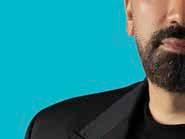



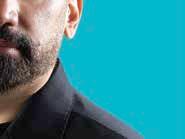


But the real value of AI is not in data collection; it’s in pattern recognition and strategic insights. AI can cluster conversations, extract themes, and surface blind spots that humans might miss in high-volume environments. AI works in tandem with analysts. It accelerates their impact. When used intentionally, it enables insight teams to step out of reporting mode and step into the room as strategic partners, bringing the foresight, curiosity, and confidence needed to guide client outcomes.
STRATEGY NOW HAS A CO-PILOT
At its core, strategy is about decisions: What to prioritise, where to show up, and how to create meaning that moves people. AI, when applied with intent, becomes a powerful co-pilot in this process. It doesn’t come up with the strategy; it allows people to make better educated guesses.
In the early stages, AI is transforming how teams brainstorm, benchmark, and sense-check ideas. It can map competitor activity, cluster audience behaviours, summarise dense research and surface cultural trends in seconds, removing precious time from the groundwork and allowing strategists to focus on clarity and direction. Crucially, AI also makes the strategy process more iterative. We no longer need to wait for quarterly reports to recalibrate. It empowers agencies to be more agile, testing hypotheses, adapting narratives and refining positioning without losing sight of the bigger picture.
WITH AI
With AI, a single prompt can produce five storyboard concepts, a first draft script and visuals tailored for six different audience segments. It’s a brainstorm partner, a sketch artist and a creative thinker, all at once.
But here’s the catch: the work only lands when it feels authentic. That’s where human instinct steps in. The tone, the timing, the cultural fluency that still lives in us. AI can draft, but it can’t decide what resonates. That’s the human merit.
THE ROAD AHEAD IS LEAD WITH AI; DELIVER IT WITH HEART
The coming years will test how agencies balance intelligence and instinct. We’re past the debate of whether AI will reshape agencies, as it already has. The focus is now on how to preserve human purpose within that progress. The advantage will be teams that can combine intelligence with experience and know when to rely on each.
Progress is inevitable. But the agencies that rise will be those that don’t just adopt AI, but lead with authenticity, and use AI to amplify it.
By Tarek Esper, Managing Director, SOCIALEYEZ




The marketing world is in the middle of a seismic shift, one that’s been accelerated by generative artificial intelligence (AI).
Tools like ChatGPT, Midjourney and countless others are reshaping how agencies and brands operate. But beneath the buzz and experimentation lies a deeper transformation, one that’s changing the role of the marketer from task executor to strategic thinker.
At TheGenXMedia, we believe this is not just a technology shift; it’s a mindset shift. And how we adapt will define the next era of digital marketing and the future for players like us in the region.
FROM TASK EXECUTION TO STRATEGIC THINKING
Let’s rewind a bit. For much of the last decade, digital marketing agencies were built around doing campaign setup, ad copywriting, asset resizing and reporting. These were timeconsuming, often manual and formed the bulk of the day-to-day workload.
But now? AI tools can handle many of those tasks in seconds, in fact, with much more accuracy and a professional look.
That’s not a threat; it’s an opportunity. The heavy lifting is no longer the bottleneck. Instead, what sets marketers apart today is the ability to think, ask better questions and guide AI with strategic intent.
We can now spend more time understanding why a message matters, what audiences really




























GenX’s Ashish Gupta explains how the AI shift is elevating marketers into more analytical and strategic roles.
want, and how digital touchpoints align with long-term brand value. In this shift, execution becomes the baseline, not the differentiator.
AI CAN GENERATE - BUT ONLY HUMANS CAN GUIDE AND COMMAND
Yes, AI can generate hundreds of ad variations in seconds. But it can’t grasp cultural nuance, brand history, or emotional tone. It doesn’t understand why an ad that works in Riyadh might fall flat in Dubai, or why certain visuals connect better with younger Arab audiences than others.
That’s where strategic creativity comes in, something we’ve deeply integrated into our model at TheGenxMedia. It’s not about replacing people with AI. It’s about hiring creators who can guide it, planners who can frame the problem, and media leads who can translate insight into action.
AI is the engine. Human insight is the compass.
RETHINKING THE AGENCY MODEL
The AI era also forces us to re-evaluate agency structures. The old, siloed model with separate teams for content, performance, media and analytics is starting to feel outdated. Today, agility matters more than hierarchy.
At TheGenxMedia, we’re restructuring around interdisciplinary pods – agile teams composed of AI-literate strategists, creative technologists and culturally fluent planners. These teams don’t just deliver assets; they solve problems, interpret data with nuance, and create scalable narratives that machines alone can’t build.
We’re also training teams on prompt design, AI quality control, and data contextualisation skills that are now essential in any marketer’s toolkit.
WHAT CLIENTS EXPECT IN THE AI ERA
Clients are evolving, too. They’re no longer impressed by speed or automation; that’s expected. What they want is:
Contextual insights
Strategic foresight
Smarter integration across platforms
And, ultimately, partnership over production.
We’re seeing this first-hand with several MENA-based clients, who are no longer asking
“Can you run my ads?,” but rather “How do we adapt our marketing model in an AI-driven world?” And that’s the right question to be asking.
THE MIDDLE EAST HAS A UNIQUE ADVANTAGE What makes this conversation especially relevant in the Middle East is the region’s unique position.
A young, digitally-native population, fast-growing tech adoption and government support for AI innovation – especially in the UAE and KSA – make this one of the most fertile grounds globally for AI-led transformation.
But transformation doesn’t come from tech alone; it comes from how we use it. And brands in the region must avoid the trap of ‘AI for the sake of it’. Instead, they should focus on building real customer value, data responsibility and local relevance into their AI strategies.
THE NEW BRIEF: LESS EXECUTION, MORE VISION
The most exciting part of this shift? It forces us to be better marketers.
We’re no longer limited by production bandwidth or media ops. We’re now in a position to build brand stories faster, respond to market changes in real time and align more closely with both customer needs and business goals.
It’s no longer about how many creative executions we can generate. It’s about how relevant, intentional and strategic each message is. And that’s where the future lies. This is just the beginning AI will continue to evolve. Automation will keep expanding. But our role as marketers, especially in a region as dynamic as the Middle East, is not to compete with machines but to lead them.
At TheGenxMedia, we’re leaning into this shift. We’re not afraid of AI. We’re excited by what it frees us to do: think more deeply, plan more strategically, and deliver more meaningfully.
Because in this new era, the most valuable tool we have isn’t AI. It’s perspective.
By Ashish Gupta, CEO & Founder, TheGenXMedia







More predictive through modelling capabilities

Carat’s Bassem Hoss explains why the industry must stop chasing efficiency and focus on effectiveness.
The digital media landscape has become a theatre of efficiency. We are constantly chasing lower cost per acquisition (CPA) and higher return on ad spend (ROAS). In the performance marketing trenches, the gospel is simple: do more, spend less. We find ourselves asking a far more complex question: are we merely efficiently digging ourselves a shallow grave, or are we truly driving long-term effectiveness?
The truth is, efficiency – the act of doing things cheaper – has become dangerously confused with effectiveness – the act of doing things that matter.
In recent years, the industry’s obsession with the immediate conversion has led to an over-reliance on the low-hanging fruit. Our sophisticated algorithms are masters at identifying users already on the path to purchase. We excel at retargeting, dynamic creative optimisation, and leveraging lower-funnel tactics to shave a few cents off the final cost. This generates fantastic end-of-quarter spreadsheets, showcasing exemplary CPAs and ROAS figures. But here is the critical pivot: Is this marketing that grows a business, or is it merely brilliant sales enablement?
We have, inadvertently, ceded control of growth by prioritising the short-term transactional win. A classic example is the aggressive application of budget toward the final click, often neglecting the crucial, formative media exposures that built brand affinity in the first place. The lower-funnel efficiency we champion is frequently a measure of our ability to claim credit for a sale that would have occurred anyway. In one instance, a deep dive into campaign performance revealed that a significant portion of ‘efficient’ revenue was coming from loyal, returning customers who were consistently served an ad only days before a habitual repurchase. The media was not an accelerator of demand; it was a toll booth on the demand already created by the brand.
This is where a performance reset is urgently needed. True digital performance is not solely a measure of cost; it is a measure of sustainable value creation. Effectiveness is about smarter data connections that move us beyond the simplistic last-click metric.
The key to this shift lies in re-architecting how we define and measure success. Instead of celebrating the campaign with the lowest CPA, we must champion the campaign that demonstrates an increase in incremental lifetime value (LTV). This requires a holistic view that acknowledges the entire customer journey, linking upper-funnel media (like video or high-impact display) with final conversion, and then connecting that new customer cohort’s behaviour to their long-term value to the business.
Consider a leading e-commerce player. Their previous media model was ruthlessly efficient on a last-click basis, driving immediate sales. When they shifted to a model that measured the net new demand generated by their brand-building media efforts and linked it to a customer retention projection, even if the initial CPA was higher, they saw a notable increase in the total value of their average customer over 12 months. The short-term efficiency was sacrificed for long-term effectiveness.
To achieve this, performance teams must break down the traditional silos between brand and performance media. We must use data not just to target a known audience, but to forecast and cultivate a new one.
Smarter data stacks: The evolution of data clean rooms and sophisticated first-party data strategies allows us to understand the





“WE MUST USE DATA NOT JUST TO TARGET A KNOWN AUDIENCE, BUT TO FORECAST AND CULTIVATE A NEW ONE.”
quality of the acquisition, not just the cost. We can model the probability of a customer generating repeat purchases based on the specific media mix that first introduced them to the brand.
Incrementality testing: We must move away from retrospective reporting and embrace rigorous, always-on testing. Hold-out groups, geo-testing and media mix modelling are no longer advanced; they are foundational. They provide the empirical proof that our media investment is generating sales that would not have happened otherwise, effectively separating our legitimate contribution from mere attribution credit.
The next era of digital performance will not be won by the agency that can drive the cheapest click, but by the partner that can demonstrate the highest quality, most valuable customer acquisition. As industry leaders, our challenge is to educate our clients and ourselves that sometimes, the most effective path forward is to accept a higher upfront cost in exchange for a significantly larger and more sustainable future return. We must stop chasing a transient metric of efficiency and begin to focus on the enduring principle of effectiveness. This is the performance reset, a vital recalibration for sustained growth in the digital age.
By Bassem Hoss, Head of Performance, Carat MENA.




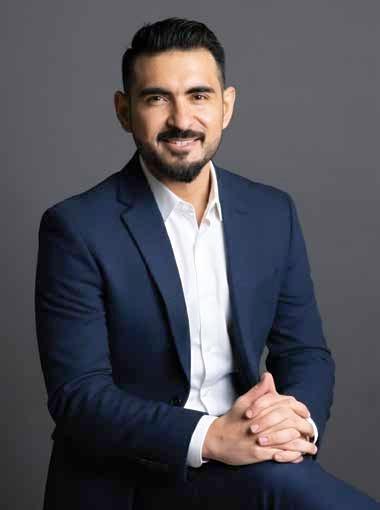
Search has long been the quiet engine of digital marketing, delivering reliable results that advertisers can measure and optimise with precision. For years, the model was straightforward: a user typed a query, an advertiser appeared with the right offer, and the click told the story. Conversion rates were predictable, attribution was clear, and ROI could be calculated with confidence. Today, that tidy funnel is cracking open.
Discovery is no longer linear. It’s happening everywhere and all at once, from TikTok videos to AI chatbots and voice prompts. For performance marketers in MENA, this shift demands fundamental transformation. The established search marketing rules are dissolving, and brands risk invisibility to their future customers.
THE FRAGMENTED DISCOVERY ECOSYSTEM
For more than two decades, when you thought of search, Google was synonymous with intent. Marketers relied on clear signals, structured bidding strategies and measurable conversion paths. Those days are behind us. Research shows that more than half of Gen Z now begin product searches on TikTok or Instagram. They’re inspired by video tutorials and swayed by creator recommendations.
ChatGPT has fundamentally shifted how consumers approach information retrieval. They’re asking questions rather than entering keywords, receiving direct answers instead of link lists. Within MENA, marketplaces like Noon and Amazon have become search destinations in their own right. The landscape has transformed into a constellation of discovery platforms, each competing for user attention. Whilst the industry grapples with fragmentation, these changes create exciting opportunities.
RETHINKING THE PERFORMANCE PLAYBOOK
So how should performance teams respond?
Map intent, not platforms: Search is no longer a discrete channel. It’s part of a larger ecosystem encompassing creators, social media, marketplaces and AI assistants. Budgeting and measurement must reflect this reality. Rather than dividing spend by platform, advertisers should map stages of intent: inspiration, research, comparison and purchase. Each stage has its own discovery environment, and media planning must reach users where that intent lives.
Prioritise discovery-ready content: Brands must treat discovery content with the seriousness it deserves. Helpful, authentic videos matter for both viewers and algorithms. Creators and brand advocates build trust within these ecosystems. Nurturing these relationships is now essential for performance, not merely brand-building. Optimise for conversational search: Marketers should prepare assets for AI-led discovery. When brands organise information clearly through structured data and plain language, they perform better on conversational platforms. SEO
Discovery is no longer a channel but an ecosystem. Initiative’s Rahul Karam shares why today’s performance strategies must follow intent, not platforms.
must evolve beyond keywords to accommodate both human and machine understanding.
MEASUREMENT AND COMMERCE
READINESS
Measurement requires an overhaul. Last-click attribution fails to capture performance when much of the journey unfolds in video or chat. Brands should test incrementality, adopt cross-channel models and utilise clean-room data to connect insights across touchpoints. This holistic view reveals the true customer journey, enabling smarter budget allocation and strategic optimisation. Commerce readiness represents another critical factor. As online shopping and retail media expand, accurate product data and frictionless checkout experiences determine revenue outcomes. If customers encounter obstacles during purchase, conversion suffers, regardless of how compelling the discovery moment was.
BUILDING HYBRID TEAMS FOR THE FUTURE Team structures must evolve alongside strategy. The future belongs to hybrid skill sets. Search specialists need creator strategy knowledge; content teams require performance literacy. Progressive MENA advertisers are already building small, cross-functional intent teams –organised around verticals – owning the complete path from discovery to conversion regardless of platform. These changes may seem daunting, yet they point towards a healthier model for the region’s digital industry. Search is not dying; it is multiplying. What’s dying is the illusion that performance can be managed through a single platform or metric.
THE CONVERGENCE OF BRAND AND PERFORMANCE
The next chapter will belong to those who embrace curiosity, experimentation and integrated thinking. As discovery continues evolving, marketers must move beyond channel-centric approaches and rebalance demand creation with demand capture.
Performance can no longer operate in isolation from brand-building. Both feed each other in shaping intent. The data now makes abundantly clear the need for an operating model that builds awareness to drive curiosity, and performance that converts it into action.
The real challenge lies in finding the right equilibrium between investment, creativity and measurement so the two operate as one system. Those who master this balance will do more than futureproof their performance efforts. They’ll create more meaningful and lasting connections with their audiences.
In MENA’s rapidly evolving digital landscape, the question is not whether to adapt, but how quickly brands can embrace this new reality. The search revolution is here. The only choice is whether to lead it or be left behind.
By Rahul Karam, Head of Performance, Initiative

With the DOOH industry set to reach $55bn by 2030, SignX’s Muneef Khan says that trust alone can no longer carry the sector and that technology-driven verification is the way forward.
In advertising, trust isn’t a soft metric – it’s the currency that keeps the industry moving. Yet in digital out-of-home (DOOH) advertising, that currency has been steadily devaluing. As the sector races toward $55bn by 2030, a fundamental question remains unanswered: How do we know what we’re actually buying?
Advertisers approve budgets based on promised impressions. Screens display content. Reports are generated. Invoices are paid. But somewhere in that chain, doubt creeps in. The uncomfortable truth is that DOOH, despite its digital sophistication, still operates largely on trust and delayed verification. This realisation is what drove us at SignX to tackle the verification challenge head-on – not because we saw a market opportunity, but because we experienced the problem ourselves as media buyers and planners.
The DOOH industry faces a verification gap that would be unthinkable in other digital channels. Imagine running a programmatic display campaign where you couldn’t verify impressions until weeks after delivery, or where multiple vendors reported the same metrics differently. The challenges are structural. Fragmented measurement standards mean comparing performance across media owners is like comparing currencies without an exchange rate. Delayed verification creates accountability gaps – advertisers often discover delivery issues only after campaigns conclude. Ad fraud takes subtle forms: phantom impressions from malfunctioning screens, inflated traffic counts, ads that play partially or not at all. In building verification systems, we’ve discovered that the problem runs deeper than technology – it’s institutional inertia.
WHAT THE INDUSTRY ACTUALLY NEEDS
The solution isn’t more data – it’s verifiable data.
Real-time verification should be standard, not premium. Advertisers need to know, during campaign flight, whether their content is displaying as planned. This
enables optimisation when it actually matters – while the campaign is still running.
Standardised measurement protocols would transform how the industry operates. When every impression is counted the same way, the market becomes more efficient. Complete delivery tracking addresses the most basic question: Did my ad actually play?
Technologies such as VAST protocols can track content from initiation to completion. The question is whether the industry has the will to implement them universally.
THE ROLE OF EMERGING TECHNOLOGIES
Artificial intelligence (AI) and blockchain aren’t silver bullets, but they offer practical solutions.
AI-powered fraud detection identifies anomalies that human reviewers miss –irregular traffic patterns, impossible delivery scenarios, and statistical outliers. Through our work developing AI monitoring systems, we’ve seen algorithms flag deviations within




























rapid technology adoption, ambitious digital transformation initiatives and significant DOOH investments create the perfect environment for implementing nextgeneration verification standards.

‘‘TRANSPARENT, IMMUTABLE RECORDS ONLY WORK WHEN ALL STAKEHOLDERS PARTICIPATE.”
minutes that would otherwise go unnoticed for weeks. Predictive analytics help advertisers plan with confidence, shifting from educated guessing to data-informed forecasting. In our testing, predictive models have achieved accuracy rates near 90 per cent. Blockchain’s value is straightforward: immutable record-keeping. When impression data is recorded on a blockchain ledger, it creates an auditable trail that all parties can verify independently. Trust becomes less about believing and more about verifying.
The challenge isn’t technical – it’s adoption. Transparent, immutable records only work when all stakeholders participate.
The Middle East has an opportunity to lead on this issue rather than follow. The region’s
Developing solutions here in the Emirates, we’ve benefited from a regulatory environment that encourages innovation and a market willing to experiment. When the region adopts rigorous verification standards, it doesn’t just improve local campaigns – it demonstrates what’s possible globally. The region’s ambition to become a global technology hub includes setting standards, not just following them.
The path to transparent DOOH requires commitment from every stakeholder. Media owners must prioritise verification. Agencies must demand accountability. Advertisers must make transparency a selection criterion. The technology exists. The business case is clear. What’s needed now is a collective will to make verification the industry standard rather than a competitive advantage.
At SignX, we’re working to make verification accessible, but we’re not naive enough to think one platform solves an industry-wide problem. Real change requires adoption across the ecosystem – from the largest media owners to independent screen operators, from global agencies to regional boutiques.
An industry built on trust but verified through technology is stronger than one built on trust alone. The DOOH industry deserves better than crossed fingers and delayed reports. It’s time we held ourselves to the same verification standards we’ve normalised in every other digital channel. That’s the future worth building.
By Muneef Khan, CEO, SignX

Fusion5’s Pascal Khazzoum outlines how AI learning systems are transforming agency operations and outcomes.
Artificial intelligence (AI) is rapidly transitioning from lab demonstrations to daily operations, a shift exemplified not only by humanoid robots entering realworld pilots but, more tellingly, by the compounding performance of learning systems already at work in fields like advertising. While some high-profile launches such as Rabbit R1 and the Humane AI Pin miss the mark (reminding us that AI creates value only when it genuinely improves a job, fixes a problem, or enhances an outcome), embodied AI is accelerating with 1X’s NEO, Tesla’s Optimus and pilots from other companies. With this, the signal for our industry is clear: when a model has the right inputs and oversight, it moves the needle and keeps learning.
This evolution is most evident inside the major platforms, where manual knobs have given way to integrated learning systems. Meta’s Advantage suite, Google’s Performance Max, and similar tools from TikTok, LinkedIn and others have folded targeting, bidding, placements and creative selection into automated learning loops. The practical effect is less guesswork and more strategic steering; the platform explores who is responding and where new demand may lie, while our role is to provide clean signals, monitor its moves and correct course quickly.
This new reality fundamentally changes how teams work. We no longer wait for post-mortems, as models now flag momentum or fatigue in real-time, rotate formats before creative burns out, and allow the brief to evolve with the results. With strategy, creative, media and analytics operating from a single source of truth, adjustments happen while audiences are still paying attention. In practice, this translates to short daily reviews, a simple decision log, and clear ownership for each change. Day to day, we focus on clarity, causality and compounding. Clarity means prioritising signal over noise, while causality involves knowing which lever – audience, context, message, or media – moved the metric. Compounding is the ultimate
















“WE NO LONGER WAIT FOR POST-MORTEMS, AS MODELS NOW FLAG MOMENTUM OR FATIGUE IN REAL-TIME, ROTATE FORMATS BEFORE CREATIVE BURNS OUT, AND ALLOW THE BRIEF TO EVOLVE WITH THE RESULTS.”
payoff, where each impression teaches both the system and the team, making tomorrow’s setup sharper than yesterday’s.
This shift elevates every function. In media planning, scenario models set realistic ranges before launch, and then the system learns which combinations win and rebalances spend, a move that does not shrink a planner’s role, but rather frees them from manual booking to focus on connecting choices to business outcomes and elevates judgement. Meanwhile, creativity also benefits immensely when informed by live context; multilingual social listening helps us read tone across languages, shaping the brief and asset order to manage fatigue without drifting off-brand. AI can point the direction, but it takes people to give it a voice and land it with cultural sense.
The proof is in the performance. In a recent campaign, shifting from tight manual targeting to audience AI with learning-based budget automation saw our cost per lead fall by roughly 50 per cent, with lead quality improving because the system continuously explored adjacent demand while we fed back conversion data, particularly on which leads converted after the first call and through the Customer Relationship Management (CRM) system.
To match this pace, agency operating models are evolving into cross-functional pods that own a learning agenda. Each pod tests within clear guardrails: the KPI we want to move, the hypothesis we’re testing, the acceptable risk and the decision rule. When a test wins, we scale it; when it doesn’t, we close it quickly and log the learning to avoid paying tuition twice. This environment favours hybrid talent – people who can interrogate data, iterate creative without losing tone, and translate a model’s output into a story a CFO can trust.
In this accelerated landscape, governance matters as much as speed. Since models can inherit bias and drift, we maintain human review for all public-facing content (language, visuals, claims and targeting), checking cultural nuance as a rule and being meticulous about data rights and consent. The aim is simple: be fast, be right and be respectful.
For decision-makers, this approach changes the conversation from presenting a wall of charts to clearly answering three questions: what changed, why it changed, and what we are doing next. On platforms pushing deeper automation, the winning agencies will be those that can steer intelligently rather than just set up campaigns –the difference between renting a tool and building a lasting capability.
The direction we are heading in is clear: agencies are evolving from production partners to intelligence partners. Our core job remains creating ideas that connect, but our added responsibility is to make the system around those ideas smarter with every impression. While AI gives us new ways to see, measure and predict, it is empathy that gives the work its meaning. The future belongs to leaders who master both the precision of data and the depth of human understanding, forging a new kind of agency that unites these strengths to deliver faster, smarter, and more relevant communication.
By Pascal Khazzoum, Social Media Director, Fusion5.












Leadgen Arabia’s Rasha Mansour outlines the five forces that brands need to embrace to not just survive but lead the shift.
As 2025 is nearing the end, the rules of engagement have been rewritten once again, as digital media enters a transformative new era defined not just by innovation, but by intelligence. Rules that are being rewritten by artificial intelligence (AI), attention and authenticity. Platforms, brands and consumers alike are on an accelerated upward trajectory, driving the digital ecosystem to continuously evolve and adapt to stay relevant.
Here are five digital media forces that will shape the next chapter:
The search experience has drastically evolved. For years, Google was the gateway to knowledge. Then came social platforms like TikTok, which users treated as their go-to search engine for trends, reviews and recommendations. The next leap is the rise of large language models (LLMs), delivering clear, conversational insights rather than long lists of links. Google has already responded by introducing AI-generated summaries at the top of results and doubling down on its E-E-A-T principles: experience,

expertise, authoritativeness and trustworthiness to safeguard credibility in an environment increasingly flooded with AI-generated content. For brands, this means accounting for LLMs in their search engine optimisation (SEO) strategies and adhering to Google’s principles to remain discoverable. Though AI-powered search is still in its infancy, its growth trajectory is undeniable.
For years, both brands and marketers have set their sights on Gen Z, the first digital-native generation, decoding their behaviour, psychographics and media consumption to sharpen their strategies, since they were positioned as the generation shaping the future. However, in the era of Gen AI, the focus has shifted from age to behaviour, where daily interactions with intelligent tools have become the norm. Gen AI isn’t a demographic but a mindset: a generation of consumers shaped by constant engagement with AI, regardless of their age. This shift challenges businesses to adapt their communication, content and experiences to resonate with a digitally native and AI-empowered audience. Soon, the real test will
come with Gen Alpha, a generation for whom AI is second nature, that will raise the bar on consumer expectations, compelling brands to evolve once again.
With countless platforms competing for limited screen time, consumer attention has become the scarcest commodity. Within the first three seconds of an ad, consumers decide whether to engage or skip –making these three seconds the most valuable. Attention goes beyond simply seeing an ad and it cannot be measured with the traditional KPIs: impressions, views, unskippable ads, etc. True attention is earned through cultural relevance, content resonance, and a brand identity that reflects the consumers’. Yes, short-form content dominates, yet, the campaigns that last are the ones that hold emotional attention, not just eyeballs. Brands that prioritise authenticity, storytelling and emotional connection will stand out in a cluttered digital ecosystem and win the battle for attention.
Shopping is no longer confined to malls or websites. It’s happening directly on social platforms. Consumers are discovering, comparing, and buying products within social apps. The ease of the scroll-tobuy experience blends entertainment and commerce seamlessly, without disrupting the consumer in their native environment. This is where the power of algorithmic recommendations to drive relevancy comes into play. For brands, this means investing in shoppable content and creating frictionless purchase journeys. Trust remains critical: transparent reviews, authentic voices and secure payment options will drive results. As social commerce grows, it’s not just an extension of e-commerce; it’s becoming a primary business channel.
The Middle East and North Africa (MENA) region, particularly Saudi Arabia, is rapidly emerging as a global gaming powerhouse. With heavy investments under Vision 2030, gaming has become a cultural phenomenon, with more than 23.5 million gamers in Saudi Arabia. Hardcore gamers now spend more time gaming than watching TV or scrolling social feeds. For marketers, gaming is more than entertainment; it’s an emerging media channel that opens doors for brands into deeply engaged communities. For brands, this represents an uncluttered platform to reach engaged audiences as gaming environments offer authentic ways to connect, not just broadcast. To reap meaningful and long-lasting relationship with their audiences, brands have to be authentic, consistent and add value to the experience. The secret lies in seamless integration and immersive interactions that enhance, not disrupt, gameplay.
The next chapter of digital will be defined by these five forces: the evolution of search through AI; the rise of Gen AI as a mindset; attention as a finite currency; the surge of social commerce and the rapid growth of gaming. This landscape offers both opportunity and urgency. The next chapter of digital isn’t waiting to unfold; it’s being written now. The brands that embrace these shifts today by experimenting, measuring and adapting will not just survive the shift, they’ll lead it.
By Rasha Mansour, Head of Strategy & Analytics, Leadgen Arabia

























Seedtag’s Sherry Mansour explains how neuro-contextual AI is redefining relevance, bringing emotions back to advertising.
Digital advertising has long been a numbers game. What began as an effort to reach the right people at the right time has evolved into a fixation on metrics, key performance indicators (KPIs) and optimisation – often forgetting the human on the other side of the screen. After all, an ad view means little if it doesn’t resonate.
For years, artificial intelligence (AI) and automation were perceived as tools that widened the disconnect – making digital experiences more measurable but less meaningful. Today, however, innovations like neuro-contextual AI are proving the opposite. By combining neuroscience principles with advanced AI embeddings, this approach analyses content in real time to understand users’ emotions, interests, and intentions – offering advertisers a human-like understanding of context, all without relying on personal data.
WHY EMOTIONS MATTER IN THE DIGITAL AGE
Emotions shape how we pay attention, remember and act. When a message aligns with a person’s emotional state, engagement rises sharply. A recent neuromarketing study found that ads with strong emotional content – such as humour or sadness – significantly increase audience engagement and brand recall. In fact, up to 70 per
cent of emotionally engaged consumers spend twice as much on brands they are loyal to.
From a neuroscience perspective, emotional arousal activates memory-related regions of the brain, such as the amygdala, enhancing both attention and encoding. The tone of surrounding content also matters – positive environments create a halo effect that boosts overall impact.
Frontal Alpha Asymmetry (FAA) studies further prove that ads activating left-frontal brain activity spark positive emotions and approach motivation. Neuro-contextual ads have been shown to enhance these responses, helping brands connect with audiences on a deeper, more human level.
FROM CONTENT TO MEANING
AI has transformed advertising with data-driven precision – predicting what people might search, scroll, or buy. But traditional models stop at what people do, not why they do it. Neuro-contextual AI changes that.
By analysing the content of an article, including words, images and even sentiment, it understands deeper user signals of emotion, interest and intention. It aligns with how the human brain naturally processes information. Instead of simply matching keywords or topics, neuro-contextual AI

understands the underlying motivation behind the content – whether someone is seeking information, entertainment, or inspiration.
At its core, neuro-contextual uses embeddings to map words, phrases, and contextual cues – like time of day or weather – into multi-dimensional data spaces that capture conceptual and emotional relationships. This allows AI to predict how content makes users feel and serve ads that complement that motivational state – all while remaining privacy-first.
For advertisers, this means campaigns that resonate – matching ads to the moments, emotions and intentions that drive real action. It’s not about replacing human creativity but enhancing it, ensuring messages reach people when they’re most receptive.
Even in an AI-driven world, the ads that resonate most deeply are grounded in human connection. Neuro-contextual AI brings that connection to life – creating smarter, more human advertising experiences across the full marketing funnel.
By Sherry Mansour, Managing Director, Seedtag MENA.


Innovation

Smarter solutions powered by cutting-edge AI.
Unified teams working seamlessly across platforms and markets.
Delivering measurable outcomes for clients, every day. We empower ambitious experts, brands, and businesses to do extraordinary work.
WPP Media’s Gurdeep Matharu outlines how brands can navigate the new and complex era of AI search.
Search is being rewritten. AI search is changing how people find and trust information. Instead of scrolling through pages of links, users increasingly receive direct, conversational answers shaped by sources the systems trust. For MENA brands, this represents a pivotal moment.
Rules of search are shifting fast. With 60 per cent of searches ending without a click – a ‘zero-click’ phenomenon –consumers often get answers directly from search results This trend, driven by large language models (LLMs) means visibility now depends on authority, clarity and relevance.
Brands have historically prioritised fast-moving channels – paid and social – over SEO. This wasn’t a mistake; it reflected market realities. Digital growth demanded quick and measurable returns. Paid delivered immediate reach, and social platforms scaled engagement. SEO felt complex and long-term, especially in a region where language diversity and cultural nuance made global playbooks hard to apply. Local teams assumed SEO was ‘handled by global’, leaving strategy and execution to headquarters. But global frameworks often lacked Arabic nuances and regional behaviours. The result wasn’t failure, it was untapped potential. Today, AI search exposes this gap, rewarding brands that invest in clarity, completeness and credibility. The question is no longer ‘How do we rank on Google?’. It’s ‘How do we stay visible everywhere?’. Search now spans video, social, voice and image, as every touchpoint becomes shoppable and the traditional funnel flattens.
This is where the temptation for quick fixes appears. With new AI experiences, it’s natural to ask, ‘How do we rank on LLMs?’. Shortcuts don’t work. AI-driven answers rely on depth and consistency built over time. Successful brands are those that show expertise clearly and repeatedly. The real solution is strengthening foundations, deciding what you want to be known for and proving it through helpful, localised content.
That begins with the questions your customers actually ask. When someone searches in Arabic or English for guidance, do they find clear, complete answers, on your site and in your voice?

Does real expertise show through named authors, experience and local proof? Are stories told with the nuance of the markets you serve, not simply translated but truly transcreated? These signals help both people and modern search systems understand, trust and return to your brand. We help brands activate these signals by identifying which platforms and content types AI models pull from – be it Reddit, YouTube, or local forums – and guiding brands to create or amplify content in those spaces. Progress doesn’t have to be dramatic to be meaningful. Small improvements compound. One thoughtful article that answers a common question can earn attention. Helpful pages can build familiarity. A visible expert voice can anchor




trust. Over time, these efforts form the kind of presence that gets cited in answer-led experiences, shapes early decisions and reduces reliance on short-term spend. The returns are tangible: trust grows, visibility becomes more durable, and brands influence the journey sooner. Our dashboards track web traffic but also AI traffic, monitoring how often content is cited in AI answers, what the sentiment is, and how this visibility translates into conversions
Brand preference can now be built, or eroded, without a consumer ever landing on your site. Add to that the rise of agentic shopping, where AI makes purchasing decisions for consumers, and winning both customer loyalty and algorithms becomes critical.
The difference between intent and momentum often lies in making a few simple decisions and holding to them. Choose the topics you should own. Commit to helpful content that reflects local realities. Give it time. Brands that strengthen their core won’t chase waves; they’ll be prepared for whatever comes because they’ve built on enduring values that travel well across platforms and trends.
How do brands navigate this exciting, complex new frontier? Performancedriven plans that embraces these changes and leverage cutting-edge technology. It’s about connecting consumer questions to brand answers, no matter where those questions are asked. This approach builds on existing platform AI capabilities and develops new, smart solutions.
AI search doesn’t erase the past; it elevates what has always worked. For brands, the imperative is clear: build on the best of traditional SEO with a local, human voice. Be useful. Be credible. Be consistent. Brands that take this path will find themselves present, cited and trusted, today and through whatever comes next. They won’t just be found; they will lead. And as AI agents begin to handle tasks autonomously, like ordering products or booking appointments, we prepare brands to be ‘agent-ready’ by optimising for new user agents, ensuring technical accessibility and creating interactive features that encourage direct engagement.
By Gurdeep Matharu, Head of SEO MENA, WPP Media




































































Globally, the lines between TV, streaming and digital video have blurred and, honestly, in MENA, they might have disappeared completely. People here aren’t thinking about platforms; they’re chasing stories. From YouTube on mobile, to connected TV (CTV) in the living room, to that 2 AM reel a friend sends, it’s all just video now.
This raises an important question for marketers: how do we plan, activate and measure in a world where video is everywhere?
The answer is to build a total video strategy that connects every platform, device and data source for a unified view of the consumer.
There’s never been a more complex time to reach audiences. The modern viewer doesn’t just watch: they interact, shop and share. This fragmented attention economy requires us to connect viewing behaviours, data signals and outcomes. Fragmentation can be both a challenge and an opportunity if you know how to link it and turn scattered attention into connected outcomes.
MENA audiences are among the most engaged in the world. According to MiQ’s Advanced TV Reports, 87 per cent of people stream content on mobile devices in KSA, while 59 per cent in the UAE prefer the TV. And second screening has become second nature in both markets, proving that multiscreen consumption isn’t replacing behaviours, but layering them.

brand-building space that marketers have always valued. Together, they bridge upper-funnel storytelling and performancedriven engagement. YouTube, especially, is becoming non-negotiable. According to MiQ’s Advanced TV reports, 68 per cent of UAE advertisers plan to increase their YouTube spend in the next year, while 53 per cent of KSA marketers are making YouTube a priority for future investment. In a region where mobile reigns supreme, media plans must mirror audience habits.
As a member of the YouTube Activation Partners programme, MiQ positions YouTube as a fully integrated part of the programmatic media ecosystem alongside linear TV, CTV and digital. When you combine YouTube’s 2.5 billion monthly average users (MAUs) with MiQ Sigma’s 700 trillion signals, you get the most effective way to plan and buy programmatic media. So, marketers can plan and optimise campaigns that create a more direct and measurable link between consumer actions and business outcomes.
TURNING COMPLEXITY INTO SIMPLICITY
MiQ’s Wassim Mneimne on building a successful total video strategy for MENA.
People watch whatever they want on whatever screen they want. The goal isn’t to chase audiences from one platform to another, but to create a connected plan that unifies them. A total video strategy achieves this using data and artificial intelligence (AI) to understand how viewers switch between screens, ensuring that every impression adds value.
AI IS AT THE HEART OF TOTAL VIDEO
Let’s imagine that every piece of audience data (CTV, YouTube, mobile, etc) could talk to the others. This conversation would reveal how people are watching, browsing and buying, creating a single connected view of the consumer. Sounds pretty futuristic, right? The kind of thing you’d expect to see in a sci-fi trailer, except it’s actually just another Tuesday in adtech.
It’s already happening. MiQ Sigma, our AI-powered advertising technology, connects trillions of data signals across the programmatic ecosystem, transforming fragmented data into clear insights, leading to smarter planning and smoother delivery. Marketers can manage frequency, balance investments, and measure reach accurately – all while focusing on creativity and storytelling.
AI doesn’t replace human insight. It gives marketers the confidence to make datainformed, audience-focused decisions.
YOUTUBE AND CTV: THE FOUNDATION OF A TOTAL VIDEO PLAN
Any total video strategy in MENA should start with the platforms audiences enjoy the most.
YouTube’s dominance on mobile and TV offers unmatched reach. CTV provides the
The biggest challenge to total video planning is data fragmentation. Each platform speaks a different language, making it difficult to measure true reach and frequency with clarity. That’s why the next wave of programmatic innovation focuses on harmonisation, not just automation. When AI-driven insight unifies exposure data across CTV and YouTube, marketers can see the full picture: where attention overlaps, expands and converts. Marketers can then manage spending, balance short-term performance with long-term brand impact, and understand the role each screen plays in the customer journey.
FROM MEASUREMENT TO MEANING
Marketers currently focus on metrics like impressions, clicks and completions. With total video, the real indicator of success is connection – between message, media and moment.
By connecting what people see with what they do, we can finally understand how attention turns into action. This shift from measurement to meaning is what will shape the most effective video strategies in the years ahead. When attention and action are part of the same system, every screen becomes a performance channel, and every impression becomes an opportunity for growth.
THE FUTURE OF TOTAL VIDEO
Building a total video strategy isn’t about replacing traditional TV or chasing digital trends, but recognising that audiences move seamlessly across screens, and ensuring that your media does too.
The marketers who win will be the ones who value understanding over visibility, who blend AI with creativity, and who see each impression as part of a larger picture. MiQ believes the future of video in MENA will be unified and smart. It begins with a total video mindset; it’s time to connect everything.
By Wassim Mneimne, Managing Director – MENAT, MiQ
























With consumer search expectations undergoing rapid changes, OMD UAE’s Terry Mo explores how a smart GEO strategy can turn GenAI platforms into a brand’s loudest advocates.









ome time ago, a colleague was telling me about a holiday she’d booked on a remote island in the Philippines that I’d never heard of before.
“It’s amazing! Let me show you,” she said excitedly as she pulled out her phone to search. In typical Gen Z fashion, it wasn’t Google Images she was reaching for –it was TikTok.
She’s not alone – new OMD research shows that less than half of all Gen Z searches start on Google. Social platforms and, increasingly, AI ones combine to take the majority of Gen Z’s searches. And, before we write this off as some sort of niche, this is a generation The Economist describes as “unprecedently rich”. McKinsey reports that Gen Z are “willing to splurge” even in the absence of financial security. With 63 per cent of the Saudi population and 36 per cent of the UAE population under 30, the transition of spending power from millennials to Gen Z is well under way.
So how do we navigate this new search landscape?
First things first – we do not want to write off the role of traditional search. It still plays a vital role in consumer purchase decisions, but that is a role that’s much better established in modern media planning practices. Our focus today is evolution, and that means we need to understand the importance of social search. It’s not just about images – Google Image search does that just fine, and arguably better. In a large part, it’s the presence of influencers that makes social search so trustworthy – 69 per cent of consumers trust influencer recommendations, and 76 per cent of consumers have bought something they’ve
seen on social. This access to reviews from a trusted, neutral source is the key to the success of social search.
That same access is also critical for the new kid on the block. Generative AI platforms like ChatGPT have grown significantly in traffic, with behaviour mimicking that of traditional search – research, explaining concepts, planning itineraries – GenAI search is seeing strong adoption from all generations but particularly millennials and Gen Z. More than that, 70 per cent of all consumers trust the accuracy and comprehensiveness of AI results. It’s clear that these platforms are the future of search. Enter GEO.
GEO, or generative engine optimisation, is an emerging discipline that focuses on understanding how these GenAI platforms are trained and how we can improve our brands’ visibility in these conversations. GenAI is becoming the new normal for people and it’s reshaping the search landscape. Just consider that 45 per cent of consumers are using GenAI for information gathering and finding answers to their questions, while 54 per cent now say they dig into topics more than they used to. The advantage that GenAI provides here is comprehensive, summarised answers but still supports for deeper explanation – if you ask about a product category, GenAI will actively give a brand recommendation and reasoning rather than just a list of options. More importantly, trust in GenAI platforms rose from 37 per cent to 61 per cent from 2024 to 2025, highlighting the increasingly crucial role that GenAI plays in consumer decision making.
So, what can brands do with this information? You first need to understand how different GenAI platforms see your brand’s USPs. They are trained to value the same USPs as consumers, so if there’s a mismatch then there’s a creative and comms challenge to be solved. You also need to identify how visible your brand is on GenAI platforms. They are all trained differently, so visibility on AI Overviews doesn’t equate to visibility on ChatGPT. Another key consideration is how favourably GenAI platforms view your brand. These platforms don’t learn from just official marketing material and don’t hesitate to repeat the negative opinions they picked up from Reddit. A comprehensive audit here will help you understand where consumers can and can’t find your brand, and how you can become more visible.
Brands that understand these factors are better able to craft a more meaningful approach. In a world where consumers’ expectations of search are evolving so rapidly, a smart GEO strategy can turn GenAI platforms into your loudest advocates.
By Terry Mo, Head of Digital, OMD UAE











Only a year ago, the industry was debating whether brands should hire prompt engineers. It already feels quaint. Prompt engineering has been overtaken by something far more powerful: agentic systems. Allow me to digress for a moment.
Almost every evening, I create bedtime stories with ChatGPT, and my children give me ideas based on their imagination. Currently, we’re deep in an episodic saga involving the family, Star Wars, Sonic and Hogwarts. But the story arc has become formulaic and repetitive. Even my kids are tired of beating Darth Vader with a Sonic Spin-Dash every time. My appreciation of these stories has diminished.
I realised two things very quickly.
Firstly, I value the output less.
Behavioural economists call it the effort heuristic: we equate value with visible labour. The harder something appears to be, the more we trust it. When a strategy, an insight, or a concept is produced quickly, even if it’s brilliant, we instinctively treat it with suspicion.
A 2023 Nature Scientific Reports study found that identical artworks labelled “AI-made” were rated up to 62 per cent less valuable than when labelled “humanmade”. The work didn’t change. Only our perception did.
This bias follows AI into the workplace. We celebrate AI for automating targeting, analytics and optimisation. But the moment it enters the world of ideas, writing, ideation or planning, we hesitate. Not because outputs are weaker, but because the effort is less visible. It’s a psychological barrier, not a technological one.
Secondly, I need to put more thought into the concept to derive meaning from the output.
Creativity isn’t just about generation. It’s about intention.
PHD’s Amit Patel on unlocking exponential human creative value with agentic AI.
FROM AD-HOC PROMPTS TO AGENTIC CAPABILITY
Early prompt libraries at PHD were a practical bridge. They helped our people structure thinking, access information consistently and reduce hallucinations. Prompts sat inside Studio Workflow in Omni, guiding AI through the steps of campaign planning: hypothesis generation, research, and refinement.
But prompts were always a stopgap.
The real breakthrough came when we moved beyond isolated prompts to agentic systems. These are AI processes that think in multi-step sequences.
Agentic capability means the model forms hypotheses, extracts keywords, runs desk research, checks source credibility, rejects weak ideas while strengthening good ones, synthesises evidenced conclusions and generates new hypotheses.
This is why the conversation about prompt engineers now feels outdated. Not because prompts don’t matter, but because agentic systems can generate, adapt and sequence their own prompts internally. The real value sits somewhere else entirely.
Agentic systems don’t improve outputs linearly; they compound them. They deliver depth, consistency and speed at a scale humans simply can’t replicate alone.
FROM PROMPTS TO HYPOTHESES: WHERE HUMAN CREATIVITY ENTERS THE SYSTEM
This shift isn’t just technical. It fundamentally changes how value is created inside agencies. Concept engineering is the art of embedding human intent, judgement, creativity and problemframing at the front of the process, giving agentic AI the right ‘soul’ to work from.
AI can scale and refine thinking, but it can’t originate purpose. It can extend a narrative but won’t work out why the narrative matters. It can evaluate hypotheses, but not choose which tension is worth exploring.

That’s human territory.
Hypotheses provide the ‘why’ while Agentic processes deliver the ‘how’. This is the moment when AI stops replacing labour and starts expanding human ingenuity. It’s the part of the story that is genuinely exciting and, yet almost entirely under-recognised.
WHY THE VALUE GAP IS A GOOD THING
Agentic systems are already delivering a step-change in speed, quality and depth, but many people still aren’t appreciating it.
That isn’t a problem; it’s an opportunity.
The organisations that close this psychological value gap, who help people trust, use and feel the power of agentic intelligence, will be the ones who capture disproportionate benefit. This is exactly where we at PHD now sit: ahead of the capability curve, and ahead of the adoption curve.
What surprises me most about agentic systems isn’t the speed or the scale. It’s something far smaller and more human, the rediscovery of what it feels like to think freely.
The bedtime-story problem showed me the trap: when AI generates without intention, the output becomes predictable, and the joy dissolves. But the moment I bring a real concept, a tension, a twist, a purpose, the model gives me the freedom to explore it without the drudgery of mechanics. The thinking becomes lighter. The ideas get bigger. The process feels playful again.
And perhaps that’s the real message here. For us, Agentic AI is creating an army of thinkers, which gives everyone the opportunity to develop strategy and add value.
By Amit Patel, Executive Director, PHD UAE


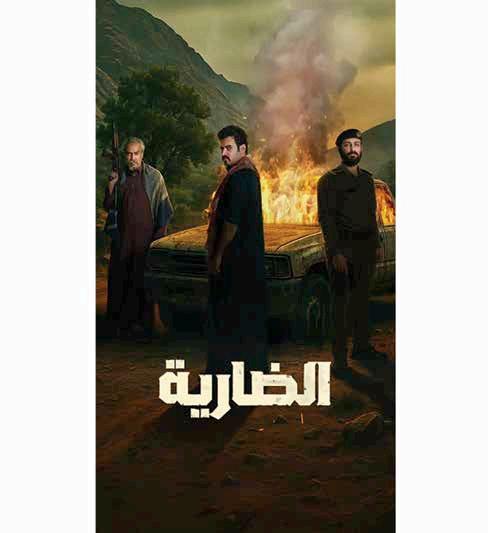
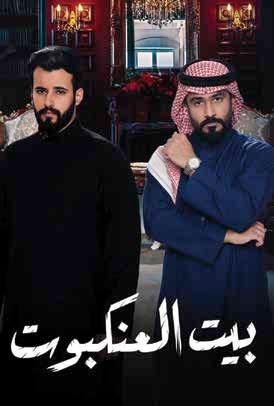

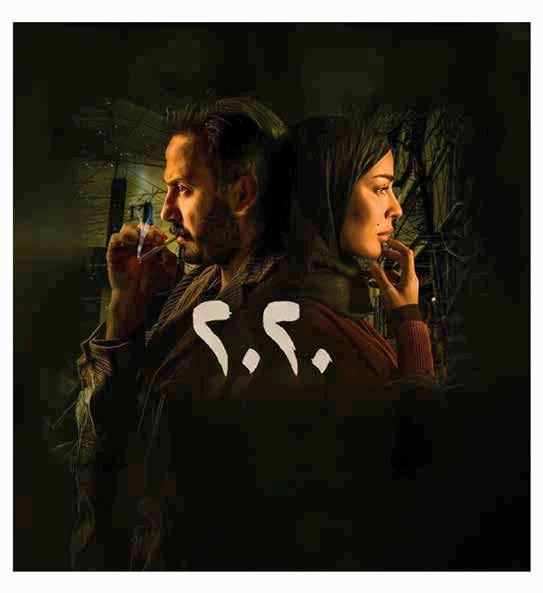



MMS’s Jad Saab explains how CTV is restoring shared viewing in MENA and offering brands more opportunities to be part of it.



For decades, the world’s stories unfolded on front pages, linear channels and around the majlis. Then came the era of endless scrolling – where culture scattered across countless feeds and fleeting stories.
Now, the script is shifting once more. In a region that has always loved gathering – for Ramadan series, football nights, or everyday family dinners – the living room is reclaiming its role as the home of connection and culture.
At the heart of it all is one screen: the connected TV (CTV).
FROM LINEAR HABIT TO DIGITAL RITUAL
Let’s be honest: TV never really left. From Bab Al Hara to Arab’s Got Talent, television has always been where MENA’s biggest cultural moments happened. What’s changed is how we watch them.







Today, more than 85 per cent of households in the Gulf own a smart TV, and people are streaming everything – Arabic dramas, Turkish series, YouTube content, football highlights – all from the same couch. On average, viewers across the GCC spend from six to more than 20 hours per week watching digital video, underscoring how on-demand entertainment has become central to daily life.
Platforms like Shahid, the region’s homegrown streaming powerhouse, have transformed the big screen into an open platform where culture meets stories. It’s not just about watching any more; it’s about choosing, rewinding, bingeing and even shopping – all from the same seat.
When Shahid launched its premium tier, many saw it as MENA’s answer to Netflix. But what it has really become is something far more interesting: a new kind of stage for Arabic storytelling, and a new kind of opportunity for brands.
Online video is now projecting the highest growth area in MENA, reaching $8.4bn by 2029,














while Saudi Arabia alone is expected to surpass 28.7 million OTT users – illustrating just how deeply streaming has entered everyday culture.
It’s where Ramadan series debut to recordbreaking audiences. Where Gulf dramas, Egyptian comedies and Saudi thrillers coexist in one app. And where advertising has evolved from being background noise to becoming part of the entertainment experience.
AND ATTENTIONS ALIGN
Social media taught us to chase quick clicks. But CTV brings attention back to where it belongs –with emotion, immersion and intent.
With more than 60 per cent of viewers reporting that they prefer watching content on CTVs in MENA, brands can reach these audiences with the emotional depth of linear TV but with digital precision through CTV advertising. And it’s not just any audience – high and mid-income individuals account for nearly 72 per cent of all digital video consumption in the GCC, showing that brands are connecting with consumers who have both passion

and purchasing power. On CTV, brands don’t have to fight for a two-second swipe. They can build experiences and tell stories that unfold, breathe, and resonate.
Whether it’s a cinematic Ramadan spot that stirs nostalgia, a curated piece of branded content or a data-driven campaign served to viewers, it offers something the feed never could: attention with intention. It’s no coincidence that CTV viewership peaks during communal moments. These are not passive audiences; they’re coviewing, discussing and sharing. For marketers, that’s gold.
The question isn’t whether your brand should be on CTV – it’s whether you’re showing up in the right way. The best CTV ads don’t interrupt stories; they participate in them. They don’t shout for attention; they earn it through craft, timing and cultural empathy.
With Shahid now offering rich audience insights, contextual targeting and unique ad formats, the living room has become an incredibly strategic – and measurable – media space. It’s not only about banner ads and pre-roll. CTV is where your brand gets to feel big again.
After a decade of fragmented attention, people are gathering again – together, in front of the screen. For brands, this isn’t just a new media channel. It’s the return of shared culture – and the opportunity to be part of it.
Because, while the rest of the world scrolls through noise, the Middle East is showing that the biggest stories – and the biggest feelings – still belong on the biggest screen.
This is where connection lives. And where brands can belong again.
By Jad Saab, Digital Growth Lead, MMS

In the modern digital world, success often feels measurable. Numbers rise, graphs appear healthy, dashboards shine green. A higher click-through rate (CTR) might mean more users are clicking, but it does not necessarily mean they are buying. A low cost per lead (CPL) might signal efficiency, but it does not guarantee profitability. The reality is that impressions do not walk into showrooms, and reach does not convert into recurring customers. The illusion of success frames social metrics as business outcomes, when in reality they are only indicators, and more often times than not, misleading ones.
The question lies here: How long can brands claim success with vanity metrics?
RETHINKING SOCIAL PLATFORM IMPLEMENTATION
Social platforms remain powerful only when used with intentionality. To transform vanity metrics into actionable data, we must re-engineer how we utilise them.
While we have traditionally measured the success of the awareness stage using metrics such as video views and engagement, we should redirect our focus to more meaningful indicators such as ad recall lift and ad fatigue rates.
Then, to ensure that only relevant audiences progress further down the funnel during the consideration stage, marketers can apply additional filters such as user interests, income levels, and behavioral data in addition to traditional campaign setup to drive interest and intent.
At the conversion stage, campaigns such as catalogue sales, app installs, or customer relationship management (CRM)-integrated lead generation should be optimised for tangible outcomes, specifically, purchase events or lead quality scores, rather than mere form submissions.
One of the biggest disconnects in advertising is the gap between digital clicks and real-world outcomes. This begins with offline conversion tracking, which allows us to measure how many
social leads convert into paying customers. By connecting the dots between ad engagement and actual sales, we can identify which platforms, creatives and audiences drive real results.
Another key factor is CRM integrations – a capability some brands tend to undermine – which allows marketers to automate lead flow and assess quality in real time, distinguishing between high-intent prospects and low-value inquiries. These insights are then fed back into ad platforms, enabling their algorithms to optimise for buyers rather than clickers.
To elevate performance further, we adopt a value-driven optimisation approach supported by dynamic retargeting loops. For instance, those





who have watched awareness videos can be re-engaged with carousel ads, users who opened lead forms can be served case study content and past converters can receive personalised upsell or cross-sell messages to increase lifetime value. Each interaction becomes a deliberate step toward revenue growth, ensuring that data, creative sequencing and targeting all work cohesively to move prospects from interest to purchase with measurable efficiency.
REBUILDING REPORTING FRAMEWORKS
Traditional dashboards that highlight impressions and clicks often fail to tell the full story of performance. Moving from surface-level dashboards to impact dashboards is key. Indicators such as cost per qualified lead, conversion-to-sale ratio, return on ad spend and incremental lift versus baseline offer a more accurate picture of value creation. Now, the
‘‘THE ILLUSION OF SUCCESS FRAMES SOCIAL METRICS AS BUSINESS OUTCOMES.”
conversation shifts from how the campaign performed to what it delivered, ultimately optimsing budgets, refining targeting, and proving real return on investment (ROI).
FROM METRICS TO MEANING
In the end, brands that win are those that see beyond vanity metrics. Those that treat engagement as the starting point, not the result. Those that turn every interaction into a measurable business impact.
By Zaid Sweidan, Senior Performance Manager, Boopin
Boopin’s Zaid Sweidan shares how brands can rebuild their reporting frameworks to focus on impact, not illusion.
After 26 years in this industry, I realised I no longer wanted to sell noise.
Marketing had become too loud. Too fast. Too consumed by itself.
I didn’t walk away from the work. I walked towards a better version of it.
For too long, we’ve mistaken attention for value.
We’ve measured volume and called it victory.
We’ve celebrated impressions and “viral” moments while losing sight of what truly builds connection. Some still do.
The landscape changed. The audience changed. But our industry? Not so much.
People now respond to brands that listen before they speak. That act before they advertise.
That mean what they say. Many still chase visibility in an age that demands meaning.
If you’re looking for loud campaigns, vanity metrics, or creative theatre, I can happily recommend a dozen agencies that do that better than anyone.
But if you want your message to move people and withstand the passing of trends, then you’re speaking our language. Because we focus on impact over reach, understanding over algorithms, and substance over noise.
Creativity is evolving. Those who cling to the old playbook will fade with it.
The next generation of communicators will be half strategist, half scientist – guided by intuition, powered by intelligence.
They’ll design messages that live in culture, not just in campaigns. They’ll measure success in meaning, not metrics.
At Cicero & Bernay, we call this Intelligent Communication. It brings data, design, and intent together in one conversation.
It’s less about what we say and more about how we understand. So yes, I quit marketing.
And in doing so, I found something stronger: communication with conscience.
This is the era of intelligent connection. This is where creativity meets accountability. This is where we are Empowered by Facts.
Yours truly,







Ahmad Itani CEO, Cicero & Bernay Communication Consultancy

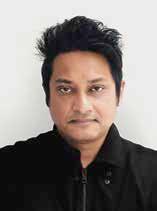
By Aunindo Sen, Executive Creative Director, Publicis Middle East
Publicis Middle East’s Aunindo Sen makes the case for ‘gloriously unreasonable’ creativity that is illogical, doesn’t follow reason, isn’t handcuffed by data, but is instead beautiful, terrifying, nonsensical and somehow makes perfect sense in hindsight.
There’s a quiet myth that has crept into advertising over the last decade. It’s the one that says research is king, statistics are the backbone and logic lights the way.
Lovely. Sensible. Entirely forgettable. Because if history has taught us anything, it’s that reason rarely makes history. Creativity does.
Let’s face it, algorithms may know where people are going, but creativity decides how they get there.
In fact, every great piece of advertising that has lasted in our memory began as something gloriously unreasonable.
“Think Different”? Strange back then.
“Just Do It”? Statistically unprovable.
“Without creativity, all that remains is just a pile of numbers and words waiting for a spark.”
“Got Milk?” Grammatically wrong.
But each, unforgettable. Because the ideas that live forever aren’t born from bar graphs or focus groups. They come from those mad, magnificent moments when someone says, “What if we did something completely stupid?”

Because the best advertising doesn’t follow reason, it rewires it.
Creativity – as a goal, not a department – is the heart and soul of the industry. Everything else – including the metrics, the build-ups with 86 slides – is a passenger. Helpful, polite, and sometimes even charming, but never the one at the controls.
Without creativity, all that remains is just a pile of numbers and words waiting for a spark.
Of course, that doesn’t mean we toss the non-creative bits out the window – although, admittedly, it’s tempting. It just means we should remember their place.
It is high time that research informed creativity not handcuffed it. Just look at TikTok or Snapchat now as proof. Because when creativity leads, the work sings. When logic leads, the work explains.
And no one ever fell in love with an explanation.
Look at the campaigns people still talk about decades later. They weren’t optimised to death or benchmarked into blandness. They were beautiful, terrifying, nonsensical risks that somehow made perfect sense in hindsight.
Guinness’s ‘Surfer’. Old Spice’s ‘The Man Your Man Could Smell Like’. Apple’s ‘1984’. None of these would’ve survived a modern test. They would’ve been deemed too strange, too niche or too ‘wrong’. Which is precisely why they worked.
So it’s not about making the obvious choice; it’s about making the only choice people will remember.
Because in advertising, creativity isn’t just the star of the show. It’s the script, the spotlight and the standing ovation.




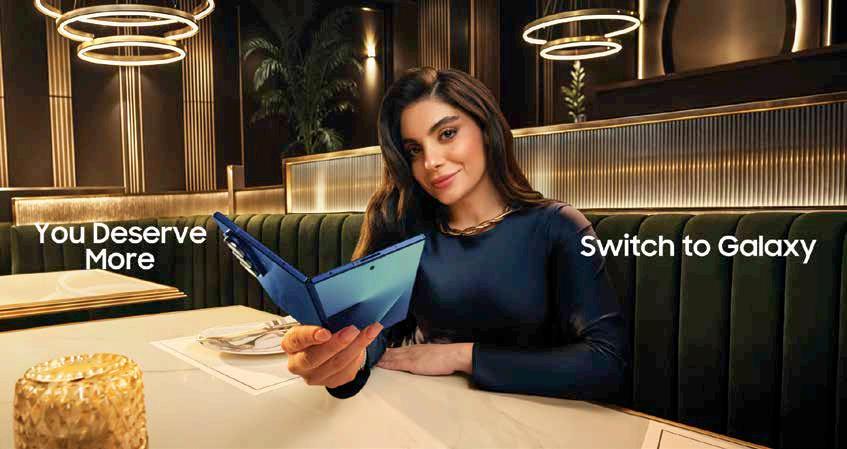





Advocacy Director, Saudi Tourism Authority
1.


The campaign showcases strong production values. That said, there is an opportunity to strengthen impact by refining the brief toward clearer conversion goals. With a sharper objective, the creative could further highlight Careem Quik’s unique value in a competitive quickcommerce space. Expanding the creative beyond the healthy-cooking user could unlock even wider relevance.
2.
This campaign carries a message far bigger than a festive ad. The brand uses this insight of Indians living abroad smartly, positioning itself not just as a jeweller, but as a symbol of Indian heritage that prioritises the passing of culture and traditions. A subtle but powerful detail is the play of accents – the child’s slightly Western tone contrasted with the parents’ – highlighting how easily cultural identity can drift, and the parents’ role in preserving it. A thoughtful, well-executed campaign.
3.
The campaign taps into a relatable truth: many users feel smartphone upgrades have become incremental. The humour lands well. The only part that felt slightly off was the focus on voice-assistant frustration, as many iPhone users today rely on tools like ChatGPT or Gemini instead. Overall, it’s a well-executed campaign that might still resonate, though it might have landed stronger a couple of years earlier.
4. NATIONAL BANK OF EGYPT
From the name to the creative idea, this work is built to speak to every Egyptian. The execution reinforces this intent through a diverse cast, signalling that anyone can be targeted by digital scams. The song’s pacing is especially effective: each line delivers one safety instruction, followed by a brief pause that allows viewers to absorb it. The final recap gives the campaign strong potential to resonate widely and drive real learning.
5. JEEP
Some car brands exist for mobility, while others build a lifestyle and community around them – Jeep is firmly the latter. The campaign delivers across the full funnel with clear intent. It drives awareness and builds consideration that can naturally transform into conversion, which is the ultimate commercial objective. The giveaways serve as a complementary layer, giving even non-owners a tangible entry point into the brand. A simple, well-structured campaign that balances culture and commercial impact effectively.
Chief Creative Officer, Horizon FCB
1. CAREEM QUIK


Extremely well executed, the film showcases such dynamic editing that it manages to make ‘cool’ a very straightforward selling proposition. The cheeky (and brave) writing in the mushroom piece makes me wonder how they got it approved! Well done on that one – nothing else really caught my eye in the rest.
2. TANISHQ
Beautifully filmed – the craft is definitely an attribute worth highlighting. The idea aims to be emotional; however, in my opinion, it isn’t particularly outstanding or original.
3. SAMSUNG MENA
I liked the initial parallel between breaking up with someone and breaking up with your phone – it’s fun and fresh. However, after a strong start, I felt the ads fell into a less exciting, plainer and unsurprising approach.
4. NATIONAL BANK OF EGYPT
A quirky approach to a very serious topic, such as financial safety. Translations never do justice to the intention and craft of the original work, and I’m sure it connects better with the local culture. Perhaps not my style of advertising.
5. JEEP
I’m not sure if digital cars can actually get stuck inside a video game; however, this parallel between the game and the real world is catchy. Putting aside my doubts about the technicalities and how it works, I believe there’s an interesting idea there.
Careem Quik
Title: Get Fresh
Agency: Careem Creative Studio (in-house)
Production house: Bigfoot Films
Tanishq
Title: India Wali Diwali
Agencies: Team Red Dot (Media, Digital), Watermelon Middle East (PR)
Production house: Lowe Lintas
Samsung MENA
Title: You Deserve More Agencies: FP7 McCann, Starcom (Media)
National Bank of Egypt
Title: A Call To All Egyptians Agency: Tarek Nour Advertising Production house: Butter Films
Jeep
Title: Rescue Squad Agencies: Publicis Middle East, Munch (Influencer) Game developer: Esteban Quintero

Havas has appointed BERTILLE TOLEDANO, CEO of BETC, as President of Havas Creative Network, and CEO of Havas Creative Middle East. Toledano will work closely with several of Havas’ executive leadership, including Dany Naaman, CEO of Havas Middle East, to ensure that the region delivers its full creative and business potential leveraging Havas’ Converged.AI strategy.


Creative agency We Are Social, formerly known as Socialize, has promoted JIM COLEMAN to the role of EMEA CEO. Previously CEO for the agency’s UK offices, Coleman will now focus on strengthening connections across the agency’s offices in Europe and the Middle East by accelerating growth through innovation in products and services across the region. He will be responsible for building closer collaboration and a unified culture across We Are Social, and sister agency Hello’s offices of 620 people in the EMEA region.
BPG Group has appointed TIM BAKER as President of BPG Arabia, to lead the agency’s operations and strengthen its digital-first and ‘integrated by intent’ offering across Saudi Arabia. Baker brings more than two decades of communications leadership. He will lead BPG’s expansion in Saudi Arabia, enhancing its integration across strategy, creative, content, PR, social and

technology, and working closely with clients to deliver data-driven, digital-first, insight-led communications.
Serviceplan Group
Middle East has appointed VARUN KOHLI as Chief Financial Officer for the region. He has held senior roles at leading global advertising and media groups. In his new role, Kohli will play a central part in accelerating the Saudi expansion of Serviceplan Arabia and Mediaplus Middle East, working closely with Managing Partners Rami Hmadeh and Azhar Siddiqui, respectively.


Initiative, a global media agency under the Middle East Communications Network (MCN), has appointed of AMINE ADEM as General Manager for its UAE operations. Adem brings more than 15 years of experience in research, insights, and client leadership across the MENA region. In his new position, Adem will oversee Initiative UAE’s strategic direction and operations. His remit includes strengthening client partnerships, advancing innovation in media planning and investment, and further developing the agency’s capabilities across key industries.
TBWA\RAAD has appointed HADI ABOU KHZAM as Managing Director for Nissan United MENA, the agency’s flagship automotive hub, which serves as the integrated

marketing engine for Nissan and INFINITI in the region. Khzam will drive the evolution of Nissan United 3.0, an artificial intelligence (AI)-powered, data-driven marketing model designed to deliver precision, performance and creative impact at scale. His mandate: To transform how two of the world’s most iconic automotive brands connect with consumers in one of the industry’s fastest-evolving markets.

Born Creators has appointed FADI SAAD as Chief Growth Officer for the MENA region. The move reinforces the Group’s expansion and growth ambitions across the region’s fast-evolving communications landscape. Saad is a well-rounded industry leader who has built his career within global agency networks such as WPP and Omnicom Holdings. In this role, he will lead Born Creators’ regional growth strategy, oversee new market development and more.

Think Human has announced the appointment of TIAGO BASTOS as its new Creative Director. Bastos brings more than two decades of experience from roles across Brazil, the UAE and Saudi Arabia, including positions at Leo Burnett Tailor Made and Edelman KSA. Bastos’ work has been recognised at awards such as Cannes Lions, Clio, D&AD, Dubai Lynx – where he won a Grand Prix – and Effies. He has also served on juries for international festivals including AdForum PHNX, NYF and MAD Stars. In his new role at the creative agency, Bastos is collaborating with teams across the agency to develop what he describes as ‘creative ecosystems that move beyond single campaigns’.

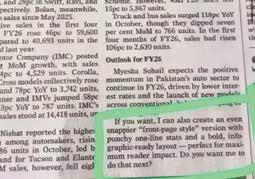

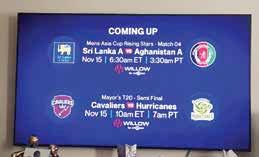
1. With a little help from their AI friend, this publication definitely achieved maximum reader impact, but perhaps not for the reason it intended. Screenshots of the mishap ran ablaze across the internet overnight, with comments questioning the credibility of traditional press in the age of AI. If the em dash ‘—’ in the piece didn’t raise eyebrows, the final paragraph surely did.
2. The latest delivery player in the UAE boldly took over cities with out-of-home campaigns in the country to celebrate its launch in the market. The Spin couldn’t resist


the temptation of seeing what the hype was about. It’s safe to say that the enthusiasm is well-noted, with weekend notifications coming in at the crack of dawn on a Monday morning.
3. If you really think about it, the region does kind of run on speedy deliveries. Without our trusty heroes on two-wheelers zipping through traffic to get our orders to us on time, we’d be left damsels in distress. It’s not surprising that the power of teleportation is at play, how else would you explain getting from Bur Dubai to Barsha in just eight minutes?


4. The Spin thinks the presenters might have dropped the ball on this one. A few letters more, and it would have left us truly aghast.
5. While autumn can certainly feel like just a moment in the sunny lands of the Middle East, The Spin thinks this store might have its measures of time mixed up. Logic does make a strong case for a moment being significantly shorter than a season.
6. This is not an emergency! We seem to have time-traveled back to the mid-2010s. Who else

remembers the acronym for ‘before all else’ being as overly used as today’s ‘6/7’ or ‘sigma’?
The Spin does find comfort in the nostalgia of yesteryear.
7. The Spin has a new addition to its bucket-list of destinations after the sandy shores of the Maldives and the Seychelles. After all, nothing beats a Jet2 holiday.
8. The Spin is gearing up for the festive season. However, it’s not sure which one to prepare for here. This case of mixed messaging has us in a tizz.
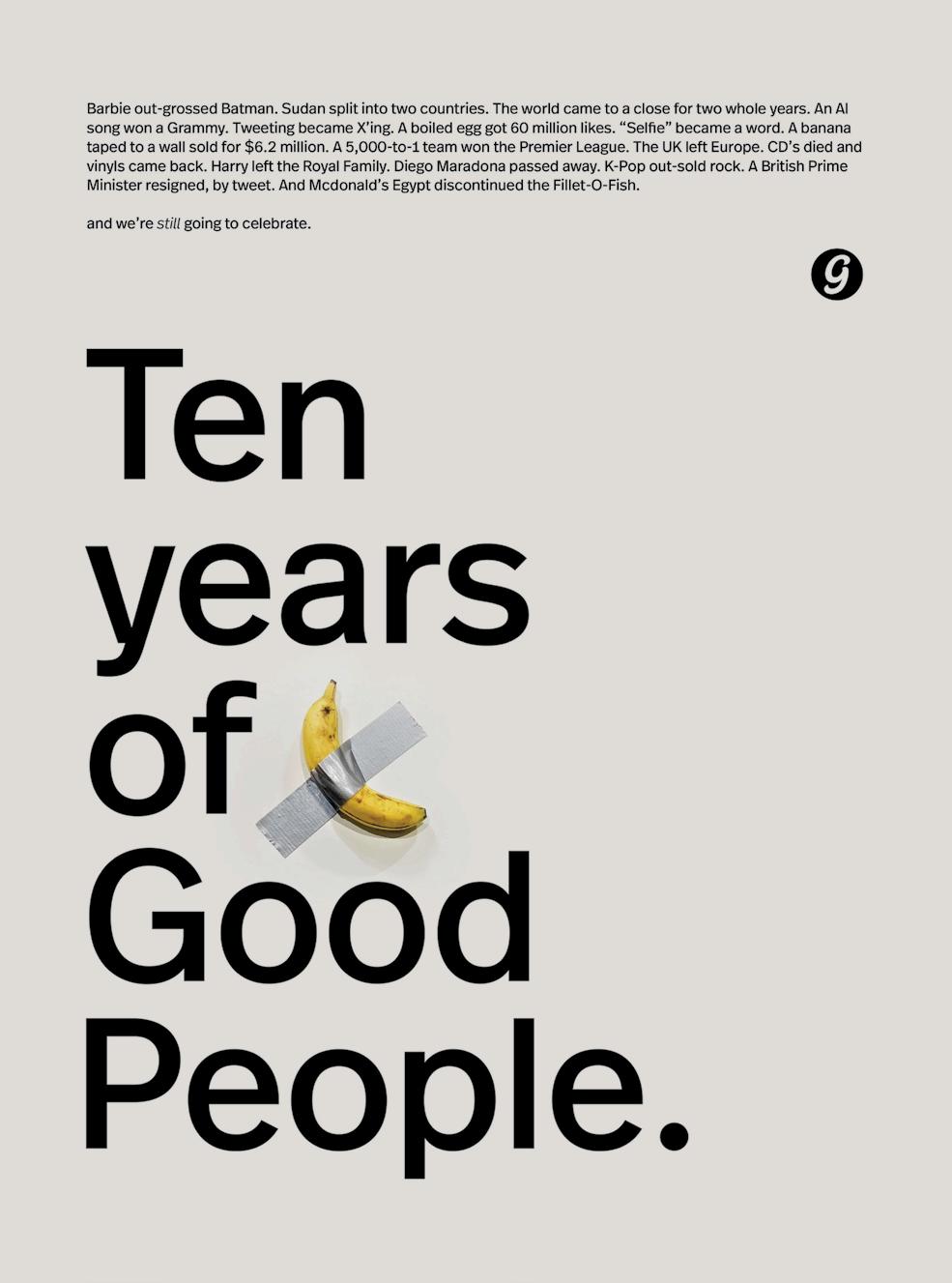
Algorithms can only skim the surface. But only humans dive into what truly matters: nuance, emotion and meaning.
Because real understanding lives beneath the obvious.
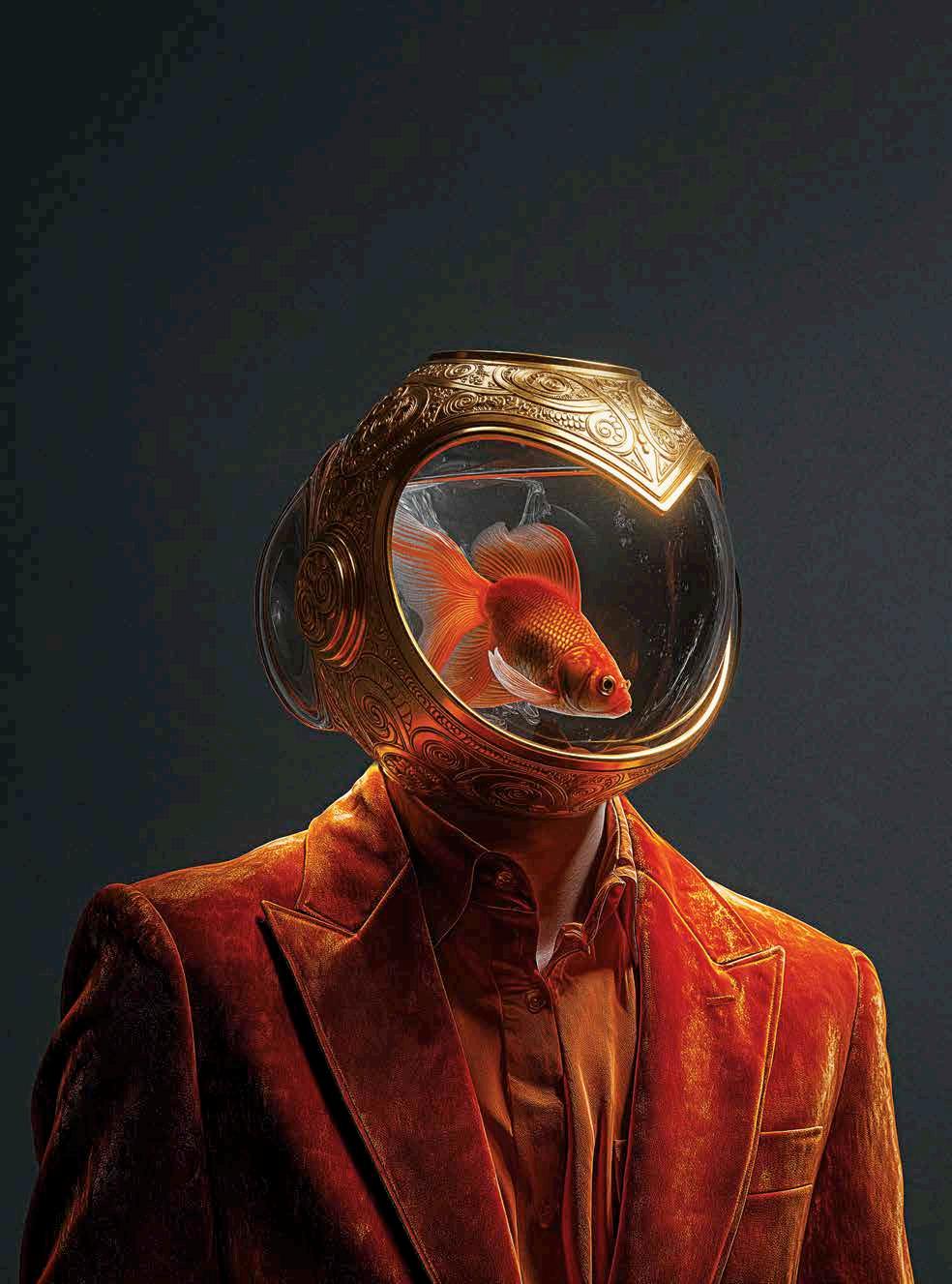
>> That’s what we do. We go deeper. With our strategists, storytellers designers and technologists, so brands can go further.
>> Let’s be partners | thinkhuman.ae